Paul van Yperen's Blog, page 58
February 26, 2024
Jean Lefebvre
French comedian Jean Lefebvre (1919-2004) appeared in about 150 films, mainly in supporting roles. He is best known for the film comedies about the gendarme of Saint-Tropez, in which he co-starred with Louis de Funès. The public loved his big, black, mournful spaniel's eyes and nervous, slightly rat-like smile.
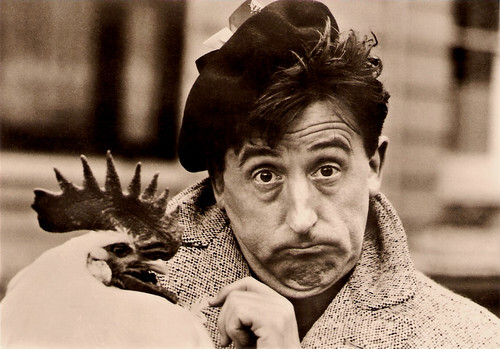
East-German postcard by VEB Progress Film Vertrieb, Berlin, no. 2.632, 1966. Retail price: 0,20 MDN.
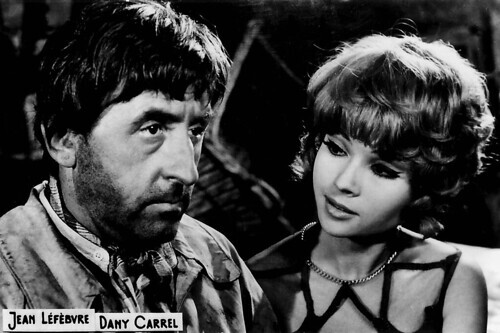
Romanian collector card. Jean Lefebvre and Dany Carrel in Un idiot à Paris/An Idiot in Paris (Serge Korber, 1967).
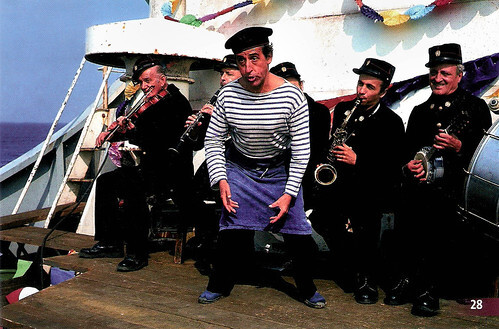
French postcard by Editions Atlas, Evreux, no. 28. Photo: INA. Jean Lefebvre in the TV series Chéri-Bibi (Jean Pignol, 1974-1975). IMDb: "Billy Bob Thornton appears to have lifted his Sling Blade (1996) performance - for which he lost the Best Actor Oscar, but won one for writing - entirely from Hervé Sand's Chéri-Bibi, down to his facial expressions, mannerisms and vocalizations (lower pitched voice and grunting). The French series being completely obscure and unheard of in the USA, no one was the wisest back in 1996." Hervé Sand was Lefebrvre's co-star.
Too big for his body
Jean Marcel Lefebvre (sometimes Lefevre) was born in Valenciennes, in the North of France in 1919 (some sources indicate he was born in 1922). He was the son of Georges Marcel Lefebvre and Zélia Louise Mathilde Masquelier.
As a boy, Jean made his first film appearance as the son of Judex in Judex 34 (Maurice Champreux, Roger de Trémeuse, 1933). After the war, he was an extra in films like Un flic/A Cop (Maurice de Canonge, 1947).
He went to the conservatory in Paris in 1948. He won second prize at the Opéra Comique, where he studied for a while. But his subsequent drama teacher, René Simon, took him down a few pegs when he informed Lefebvre that his stage acting voice was too big for his body. The effect was unintentionally ludicrous, so he was advised to stick to light comedy.
He made his stage debut in 'Vignes du Seigneur' at the Cabaret Amiral, then played a small part in Robert Dhéry's first great success, 'La Plume de ma tante' (The Pen of My Aunt), in the early fifties. He became a member of Dhéry’s company Les Branquignols.
He was to appear in numerous plays and in more than a hundred films, some of them total flops. In French, a flop is called a "navet" (turnip) which prompted him to remark that in his long career, he had planted a whole field of turnips. But he also appeared in some memorable comedies.
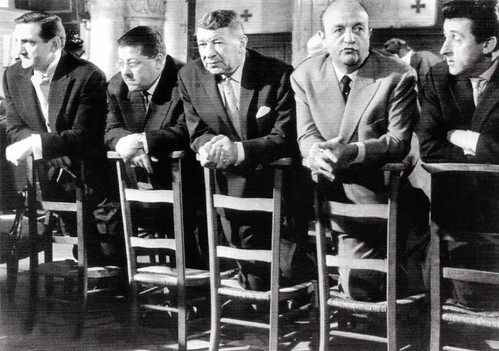
French postcard by Finart-Print (DR), no. 307. Lino Ventura , Francis Blanche, Robert Dalban, Bernard Blier and Jean Lefebvre in Les Tontons flingueurs/Crooks in Clover (Georges Lautner, 1963).
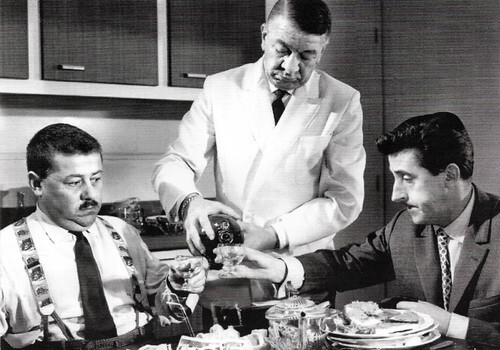
French postcard by Finart-Print (DR), no. 312. Francis Blanche, Robert Dalban and Jean Lefebvre in Les Tontons flingueurs/Crooks in Clover (Georges Lautner, 1963).
Les Gendarmes
Jean Lefebvre entered the film world in the early 1950s and played some minor roles. In 1954 he appeared as a drunken sailor in Les Diaboliques/Diabolique (Henri-Georges Clouzot, 1954) starring Simone Signoret .
Two years later he appeared as René in Et Dieu... créa la femme/And Woman… Was Created (Roger Vadim, 1956) with Brigitte Bardot , and again two years later in La Fille de Hamburg/The Girl From Hamburg (Yves Allégret, 1958) with Daniel Gélin and Hildegard Knef .
He also appeared in some comedies by his old buddy Robert Dhéry, La belle Américaine/The American Beauty (Robert Dhéry, Pierre Tchernia, 1961) and Allez France!/Up the French! (Robert Dhéry, Pierre Tchernia, 1964) with Diana Dors . He also appeared in the Hollywood production Gigot (Gene Kelly, 1964), an Oscar-nominated tribute to Charlie Chaplin and his film The Kid (1921) with Jackie Coogan .
Among his other successful films of the 1960s were the gangster comedy Les Tontons flingueurs/Crooks in Clover (Georges Lautner, 1963), and Ne nous fâchons pas/Let’s Not Get Angry (Georges Lautner, 1966), both with Lino Ventura .
Very popular was the comic series about the policemen of St. Tropez, starting with Le Gendarme de Saint-Tropez/The Gendarme of St. Tropez (Jean Girault, 1964). In these hilarious farces, he co-starred as the naïve Fougasse at the side of Louis de Funès and Michel Galabru . According to James Kirkup in The Independent , Lefebvre was called ‘le tendre pitre’ - the soft-hearted stooge. Audiences loved his randy adolescent's sidelong off-screen look of slightly panic-stricken bliss in the clutches of a statuesque but indulgently motherly hoofer.
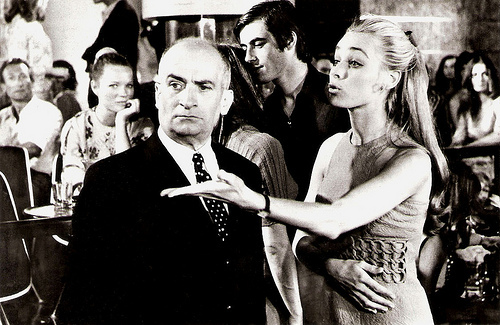
Louis de Funès . Romanian postcard by Casa Filmului Acin, no. 294. Retail price: 1,50 Lei. Photo: publicity shot for Le gendarme se marie/The Gendarme Gets Married (Jean Girault, 1968) with Geneviève Grad .
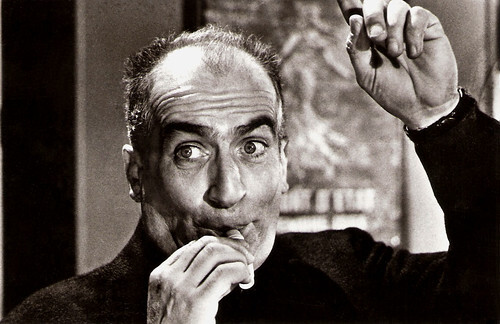
Louis de Funès . Romanian postcard by Casa Filmului Acin, no. 309. Retail price: 1,50 Lei.
The Seventh Company
Jean Lefebvre appeared in the 1970s in some international productions, such as Treasure Island (John Hough, 1972) with Orson Welles . Among his most successful films of this decade were Le Magnifique/The Magnificent Secret Agent (Philippe de Broca, 1973) starring Jean-Paul Belmondo , and Pas de problème!/No Problem (Georges Lautner, 1975) with Miou-Miou .
He also starred in the popular war comedies about the seventh company, On a retrouvé la 7eme compagnie !/The Seventh Company Has been Found (Robert Lamoureux, 1975) and La 7ème compagnie au clair de lune/The Seventh Company Oudoors (Robert Lamoureux, 1977).
In the 1980s he made far fewer films. He published a book, 'Pourquoi ça n'arrive qu'à moi?' in 1984, in which he mentions his birth date as 1922 and not 1919. And in the following decades, he mainly appeared on TV.
In 1999, Lefebvre won 15 million French Francs (2.5 million euros) with the Lottery, and he opened a restaurant, 'La Bohème', in Marrakech, Morocco (some sources indicate that the fortune was won with gambling and not with the Lottery). Incidentally, he appeared in films or on TV. His last film was Fifi Martingale (Jacques Rozier, 2001).
At the age of 84, Jean Lefebvre died in Marrakech in 2004. He was married four times (of which twice with the same wife): to Micheline Reine Grasser (1950-1962); Catherine Chassin-Briault, aka actress Yori Bertin (1967-1973 and 1974-1977); and finally in 1994, with Brigitte Jacqueline Françoise Lerebours. He had five children: Bernard, Catherine, Marie-Christine, Carole and Pascal.
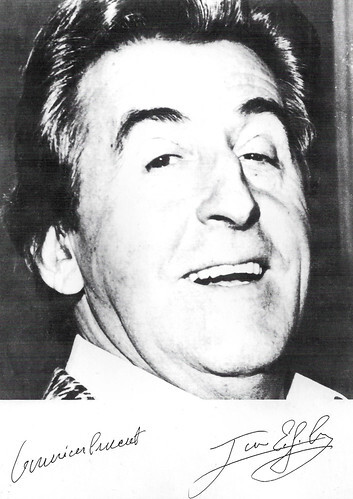
French postcard by La Roue Tourne, Paris.
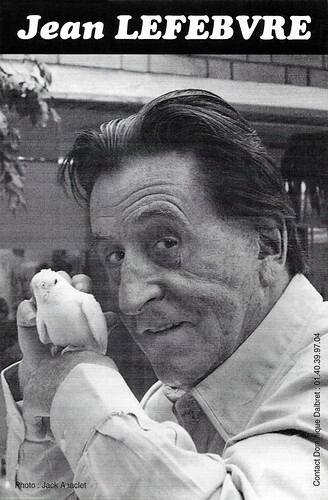
French card by Dominique Dalbret. Photo: Jack Anaclet.
Recut trailer for Les Tontons flingueurs/Crooks in Clover (1963). Source: Donny Brenton (YouTube).
Sources: James Kirkup (The Independent), Wikipedia, and .

East-German postcard by VEB Progress Film Vertrieb, Berlin, no. 2.632, 1966. Retail price: 0,20 MDN.

Romanian collector card. Jean Lefebvre and Dany Carrel in Un idiot à Paris/An Idiot in Paris (Serge Korber, 1967).

French postcard by Editions Atlas, Evreux, no. 28. Photo: INA. Jean Lefebvre in the TV series Chéri-Bibi (Jean Pignol, 1974-1975). IMDb: "Billy Bob Thornton appears to have lifted his Sling Blade (1996) performance - for which he lost the Best Actor Oscar, but won one for writing - entirely from Hervé Sand's Chéri-Bibi, down to his facial expressions, mannerisms and vocalizations (lower pitched voice and grunting). The French series being completely obscure and unheard of in the USA, no one was the wisest back in 1996." Hervé Sand was Lefebrvre's co-star.
Too big for his body
Jean Marcel Lefebvre (sometimes Lefevre) was born in Valenciennes, in the North of France in 1919 (some sources indicate he was born in 1922). He was the son of Georges Marcel Lefebvre and Zélia Louise Mathilde Masquelier.
As a boy, Jean made his first film appearance as the son of Judex in Judex 34 (Maurice Champreux, Roger de Trémeuse, 1933). After the war, he was an extra in films like Un flic/A Cop (Maurice de Canonge, 1947).
He went to the conservatory in Paris in 1948. He won second prize at the Opéra Comique, where he studied for a while. But his subsequent drama teacher, René Simon, took him down a few pegs when he informed Lefebvre that his stage acting voice was too big for his body. The effect was unintentionally ludicrous, so he was advised to stick to light comedy.
He made his stage debut in 'Vignes du Seigneur' at the Cabaret Amiral, then played a small part in Robert Dhéry's first great success, 'La Plume de ma tante' (The Pen of My Aunt), in the early fifties. He became a member of Dhéry’s company Les Branquignols.
He was to appear in numerous plays and in more than a hundred films, some of them total flops. In French, a flop is called a "navet" (turnip) which prompted him to remark that in his long career, he had planted a whole field of turnips. But he also appeared in some memorable comedies.

French postcard by Finart-Print (DR), no. 307. Lino Ventura , Francis Blanche, Robert Dalban, Bernard Blier and Jean Lefebvre in Les Tontons flingueurs/Crooks in Clover (Georges Lautner, 1963).

French postcard by Finart-Print (DR), no. 312. Francis Blanche, Robert Dalban and Jean Lefebvre in Les Tontons flingueurs/Crooks in Clover (Georges Lautner, 1963).
Les Gendarmes
Jean Lefebvre entered the film world in the early 1950s and played some minor roles. In 1954 he appeared as a drunken sailor in Les Diaboliques/Diabolique (Henri-Georges Clouzot, 1954) starring Simone Signoret .
Two years later he appeared as René in Et Dieu... créa la femme/And Woman… Was Created (Roger Vadim, 1956) with Brigitte Bardot , and again two years later in La Fille de Hamburg/The Girl From Hamburg (Yves Allégret, 1958) with Daniel Gélin and Hildegard Knef .
He also appeared in some comedies by his old buddy Robert Dhéry, La belle Américaine/The American Beauty (Robert Dhéry, Pierre Tchernia, 1961) and Allez France!/Up the French! (Robert Dhéry, Pierre Tchernia, 1964) with Diana Dors . He also appeared in the Hollywood production Gigot (Gene Kelly, 1964), an Oscar-nominated tribute to Charlie Chaplin and his film The Kid (1921) with Jackie Coogan .
Among his other successful films of the 1960s were the gangster comedy Les Tontons flingueurs/Crooks in Clover (Georges Lautner, 1963), and Ne nous fâchons pas/Let’s Not Get Angry (Georges Lautner, 1966), both with Lino Ventura .
Very popular was the comic series about the policemen of St. Tropez, starting with Le Gendarme de Saint-Tropez/The Gendarme of St. Tropez (Jean Girault, 1964). In these hilarious farces, he co-starred as the naïve Fougasse at the side of Louis de Funès and Michel Galabru . According to James Kirkup in The Independent , Lefebvre was called ‘le tendre pitre’ - the soft-hearted stooge. Audiences loved his randy adolescent's sidelong off-screen look of slightly panic-stricken bliss in the clutches of a statuesque but indulgently motherly hoofer.

Louis de Funès . Romanian postcard by Casa Filmului Acin, no. 294. Retail price: 1,50 Lei. Photo: publicity shot for Le gendarme se marie/The Gendarme Gets Married (Jean Girault, 1968) with Geneviève Grad .

Louis de Funès . Romanian postcard by Casa Filmului Acin, no. 309. Retail price: 1,50 Lei.
The Seventh Company
Jean Lefebvre appeared in the 1970s in some international productions, such as Treasure Island (John Hough, 1972) with Orson Welles . Among his most successful films of this decade were Le Magnifique/The Magnificent Secret Agent (Philippe de Broca, 1973) starring Jean-Paul Belmondo , and Pas de problème!/No Problem (Georges Lautner, 1975) with Miou-Miou .
He also starred in the popular war comedies about the seventh company, On a retrouvé la 7eme compagnie !/The Seventh Company Has been Found (Robert Lamoureux, 1975) and La 7ème compagnie au clair de lune/The Seventh Company Oudoors (Robert Lamoureux, 1977).
In the 1980s he made far fewer films. He published a book, 'Pourquoi ça n'arrive qu'à moi?' in 1984, in which he mentions his birth date as 1922 and not 1919. And in the following decades, he mainly appeared on TV.
In 1999, Lefebvre won 15 million French Francs (2.5 million euros) with the Lottery, and he opened a restaurant, 'La Bohème', in Marrakech, Morocco (some sources indicate that the fortune was won with gambling and not with the Lottery). Incidentally, he appeared in films or on TV. His last film was Fifi Martingale (Jacques Rozier, 2001).
At the age of 84, Jean Lefebvre died in Marrakech in 2004. He was married four times (of which twice with the same wife): to Micheline Reine Grasser (1950-1962); Catherine Chassin-Briault, aka actress Yori Bertin (1967-1973 and 1974-1977); and finally in 1994, with Brigitte Jacqueline Françoise Lerebours. He had five children: Bernard, Catherine, Marie-Christine, Carole and Pascal.

French postcard by La Roue Tourne, Paris.

French card by Dominique Dalbret. Photo: Jack Anaclet.
Recut trailer for Les Tontons flingueurs/Crooks in Clover (1963). Source: Donny Brenton (YouTube).
Sources: James Kirkup (The Independent), Wikipedia, and .
Published on February 26, 2024 22:00
February 25, 2024
La Collectionneuse: Photo by Juan Gyenes
Noted and talented photographer Juan (Janos) Gyenes was born on 21 October 1912 in Hungary. In 1927, he decided to start studying photography. In the 1930s, he notably worked for the stage and screen magazine Szinhazi Elet. In 1940, he settled in Spain, where he worked for several years for photographer and impresario Jose Denaria Vazquez. At the end of the 1940s, he opened his own studio and quickly rose to the first ranks of his profession. He photographed celebrities of his time, such as film and stage stars, singers, dancers, painters, etc. For the record, one of his portraits of dictator Francisco Franco was used on a stamp and he shot the first official photo of King Juan Carlos and Queen Sofia. He passed away in Madrid on 18 May 1995.
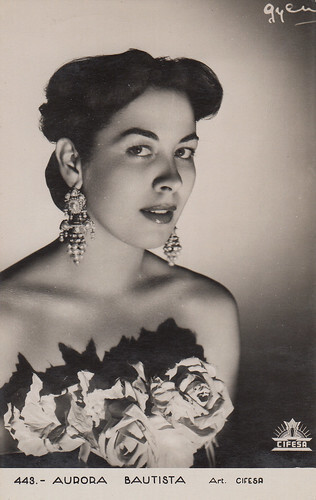
Spanish postcard, no. 443. Photo: Juan Gyenes / Cifesa.
Aurora Bautista (1925-2012) became a film star thanks to Locura de amor (1948), in which she played the mad queen Joanna of Castile. Until the mid-1970s, she was featured in about fifteen movies which include Pequeneces (1950), Condenados (1953), La gata (1956), Teresa de Jesus (1962), La tia Tula (1964), Pepa Doncel (1969) or Los pasajeros (1975). She also had a brilliant career on stage, appearing in plays by, for example, Shakespeare, Garcia Lorca, Tennessee Williams, Fernando Arrabal, ...
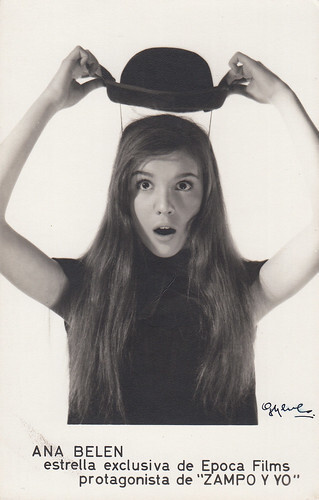
Spanish promotional postcard for Zampo y yo/Zampo and Me (Luis Lucia, 1966). Photo: Juan Gyenes /Época Films.
After having gained popularity in radio musical programs, Ana Belen (1951) signed in the mid-1960s a four-picture deal with Epoca Films, which hoped to turn her into a Marisol-like child star. She made her film debut in Zampo y yo (1966), alongside Fernando Rey, but it didn’t meet the expected success and the three other films were never produced. Fortunately, she quickly bounced back by turning to theatre acting under Miguel Narros’ guidance. It was the beginning of a long and impressive stage career. She came back to film in Espanolas in Paris (1971) and, this time, she found success. She then starred in, e.g., Morbo (1972), Vidal conyugal sana (1974), La peticion (1976), La oscura historia de la prima Montse (1977), Demonios en el jardin (1982), La corte de Faraon (1985), Divinas palabras (1987), El vuelo de la Paloma (1989), La pasion turca (1994), El amor prejudica seriamente la salud (1996), Antigua vida mia (2001), Cosas que hacen que la vida vulga la pena (2004), etc. On television, she notably was much appreciated in the big-budgeted series Fortunata y Jacinta (1980). She is also a renowned singer and received an honorary Latin Grammy Award for musical excellence in 2015.
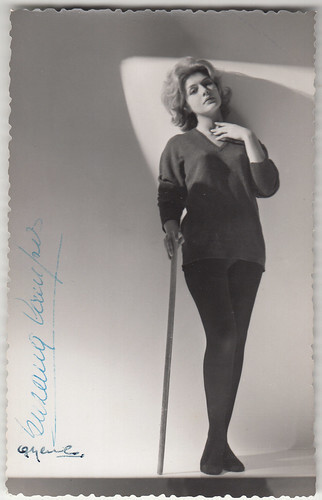
Spanish autographed postcard. Photo: Juan Gyenes.
Argentinian-born Susana Campos (1933-2004) starred in Argentinian and Spanish films. She got most of her leading parts from the mid-1950s to the end of the 1960s. She received a Best Actress Award from the 'Argentinian Film Critic Association' for Rosaura a las diez (1958) and her acting in El dia que me quieras (1969) gained her an Award from the American 'Association of Latin Entertainment Critics'. She also was active on stage.
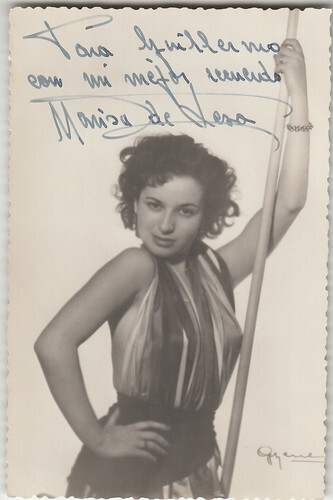
Spanish autographed postcard. Photo: Juan Gyenes.
Marisa De Leza (1933-2020) starred in Spanish films from the beginning of the 1950s to the beginning of the 1960s. She was featured in Surcos (1951), which is considered one of the best examples of Spanish neorealism, and received a Best Actress Award at the San Sebastian Film Festival for La patrulla (1954). She also performed on stage and on TV.
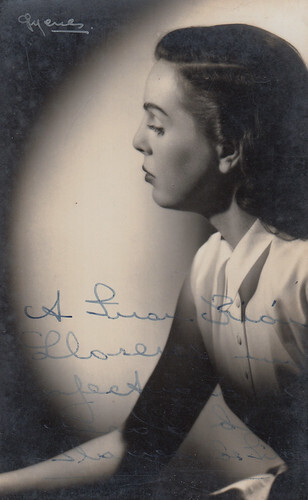
Spanish autographed postcard. Photo: Juan Gyenes.
Blanca De Silos (1914-2002) starred in Spanish films during the 1940s. They include Orosia (1943), Mariona Rebull (1947) and En un rincon de Espana (1949), which was the first production to use the Spanish Cinefotocolor process. After 1950, she was more active on stage.
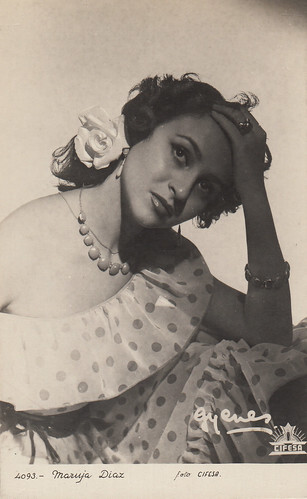
Spanish postcard, no. 4093. Photo: Juan Gyenes / Cifesa.
Marujita Diaz (1932-2015) became a film star thanks to Pueblo de las mujeres (1953). Until 1965, she was featured in fifteen more films such as El pescador de coplas (1954), El genio alegre (1957), Pelusa (1960), La casta Susana (1963) or La pergola de las flores (1965). Afterwards, she only appeared occasionally on screen. She was also a very popular stage performer, in variety shows and musicals. Furthermore, her disinhibited personality and her self-confidence enabled her to become a sought-after figure on various TV programs.
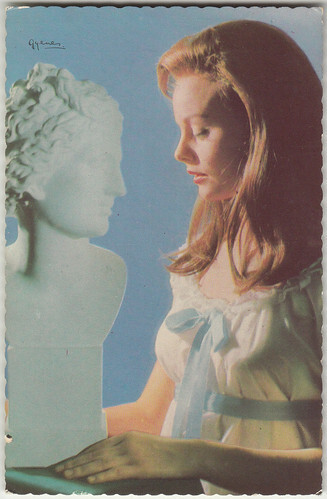
Spanish postcard by Ediciones Tarjefher, no. 220. Photo: Juan Gyenes.
Rocio Durcal (1944-2006) became a star thanks to her first film Cancion de juventud (1962), which made the best use of her musical talents. It was followed by other popular musicals such as Rocio de la Mancha (1963), Tengo 17 anos (1964), Mas bonita que ninguna (1965) or Buenos dias, condesita (1967). She played her first dramatic role in Cristina Guzman (1968) and then went back to musicals in Las Leandras (1969) and La novicia rebelde (1972). The dramas Marianela (1972) and Diselo con flores/Dites-le avec des fleurs (1974) were her two first movies in which she didn’t sing. In 1977, she played a lesbian in Me siento extrana, a role she regretted to have accepted. She then decided to give up film and to focus on her singing career. She soon specialised in a popular Mexican style of music known as 'ranchera' and became a true icon in that field, selling millions of records.
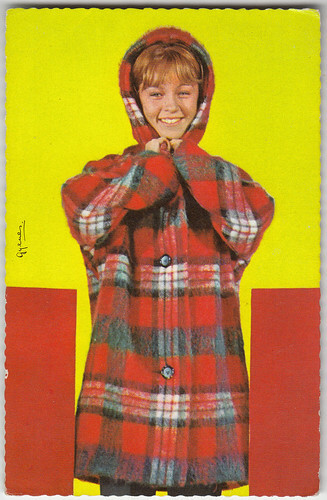
Spanish postcard by Ediciones Tarjefher, no. 110. Photo: Juan Gyenes.
Marisol (1948) became a hugely popular child star thanks to her film debut Un rayo de luz (1960), followed by, e.g., Tombola (1962) or Marisol rumbo a Rio (1963). In the second half of the 1960s, she matured into a ravishing young lady, without losing the audiences’ favour, and was featured in films such as Las 4 bodas de Marisol (1967) or Carola de dia, Carola de noche (1969). From 1973 on, she turned to dramatic roles and appeared for instance in La corrupcion de Chris Miller (1973), El poder del deseo (1975) or Los dias del pasado (1977). She retired after Caso cerrado (1985).
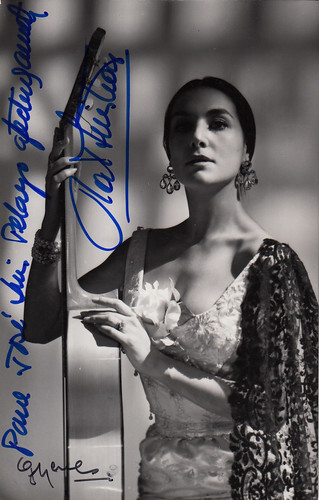
Spanish autographed postcard. Photo: Juan Gyenes.
Nati Mistral (1928-2017) was a multi-talented artist who had a brilliant career on stage. She starred in plays such as Garcia Lorca’s 'Bodas y sangre', Cocteau’s 'Les parents terribles', Jacinto Benavente’s 'La malquerida', Fernando de Rojas’ 'La Celestina' and Antonio Gala’s 'Cafe cantante' and in musicals such as Juan Ignacio Luca de Tena’s 'La Perrichola', Dale Wasserman’s 'Man of la Mancha' or Michael Stewart’s 'Hello Dolly'. She was a noted singer as well, with an interesting recording career which began in 1944, and gave poetry recitals. She also appeared in several films, especially at the end of the 1940s and the beginning of the 1950s. She notably was featured in Maria Fernanda, la Jerezana (1947), Currito de la Cruz (1949) and Cabaret (1953).
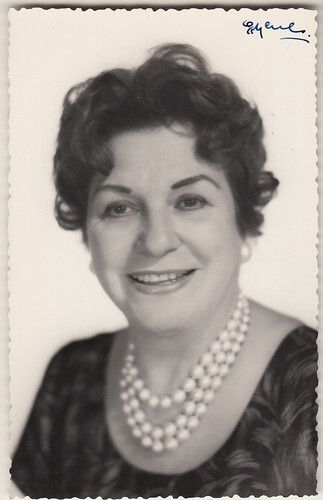
Spanish autographed postcard. Photo: Juan Gyenes.
Matilde Munoz Sampedro (1900-1969) was a popular character actress in films, from 1944 until her death, and on stage. She was famous director Antonio Juan Bardem’s mother. He gave her roles in several of his films, such as Comicos (1954), Calle Mayor (1956) or Nunca pasa nada (1963).
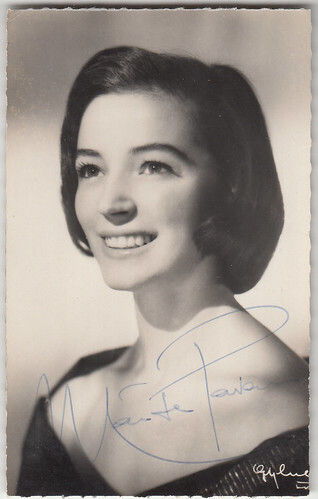
French postcard by Editions du Globe, Paris, no. 740. Photo: Juan Gyenes.
Italian-born Marisa Pavan (1932-2023) followed her twin sister Pier Angeli’s footsteps and became a star in her own right in the 1950s. Her Hollywood films include Drum Beat (1954), Down Three Dark Streets (1954), The Rose Tattoo (1955), Diane (1956) and The Midnight Story (1957).
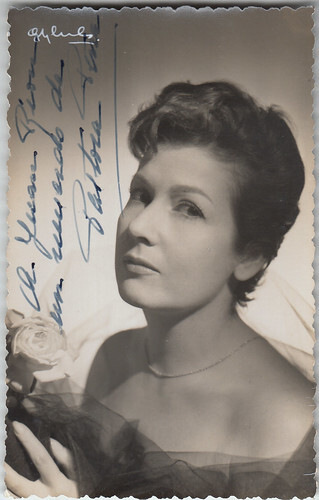
Spanish autographed postcard. Photo: Juan Gyenes.
In the 1940s, Pastora Pena (1920-2003) starred in Spanish movies such as Porque te vi llorar (1942), Lecciones de buen amor (1944) or Una noche en blanco (1949). During her long and impressive stage career, she notably had great success in Robert Anderson’s 'Tea and Sympathy' at the end of the 1950s.
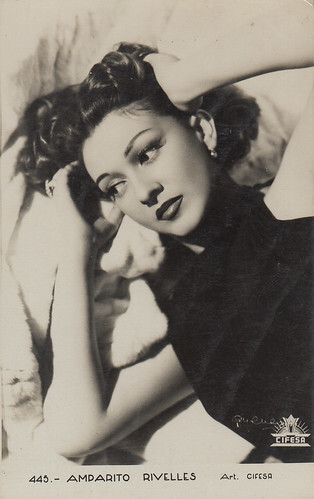
Spanish postcard, no. 445. Photo: Juan Gyenes / Cifesa.
Amparo Rivelles (1925-2013) was the daughter of famous actors Maria Teresa Ladron de Guevara and Rafael Rivelles. She followed in her parent’s footsteps and became a star upon her film debut in 1941 in the leading roles of Mari Juana and Alma de Dios. During her long and successful career, she was featured in Spanish and Mexican films. The 'Circulo de Escritores Cinematograficos' gave her a Best Actress Award for her performances in La Fe (1947) and Fuenteovejuna (1947) and she received a Goya Award in the same category for Hay que deshacer la casa (1986). She also played in the Spanish version of Orson Welles’ Mr. Arkadin (1955). She worked to great acclaim as well on stage and on TV.
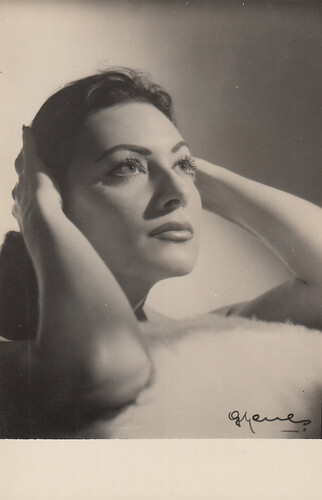
Spanish postcard. Photo: Juan Gyenes.
In the 1950s, Lina Rosales (1928) starred in Spanish movies such as Sierra maldita (1954), El puente del diablo (1956) or El pasado te acusa (1958). After Cancion da cuna (1961), in which she plays a nun who lovingly takes care of an abandoned little girl, she only occasionally acted in films. She also performed on stage.
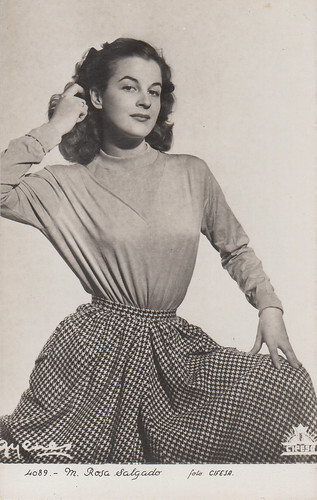
Spanish postcard, no. 4089. Photo: Juan Gyenes / Cifesa.
After having starred at the beginning of the 1950s in Spanish films such as La nina de Luzmela (1950), El hijo de la noche (1950) and El negro que tenia el alma blanca (1951), Maria Rosa Salgado (1929-1995) went to the U.S.A. under the aegis of film producer Alexander Paal, who thought she had the makings of a Hollywood star. She spent several months learning English and a successful screen test soon prompted a movie contract offer. But she preferred to go back to Spain and marry her boyfriend, toreador Pepe Dominguin, in 1953. Later she occasionally appeared again on the screen, for example in Rapsodia de sangre (1958), Fuenteovejuna (1972) or Sonambulos (1978).
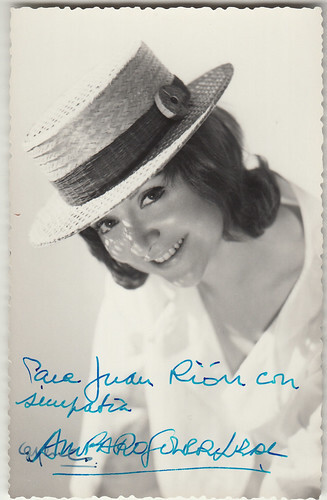
Spanish autographed postcard. Photo: Juan Gyenes.
Amparo Soler Leal (1933-2013) was a popular movie star in the 1960s, 1970s and 1980s. She twice received a Best Actress Award from the 'Circulo de Escritores Cinematograficos' for La gran familia (1962) and Bearn o la sala de las munecas (1983). She also got a Best Supporting Actress Award for Jo, papa! (1975). In 1984, she was directed by Pedro Almodovar in Qué he hecho yo para merecer esto! (1984). She performed on stage as well and formed her own company in the 1960s.
Text and postcards: Marlene Pilaete.

Spanish postcard, no. 443. Photo: Juan Gyenes / Cifesa.
Aurora Bautista (1925-2012) became a film star thanks to Locura de amor (1948), in which she played the mad queen Joanna of Castile. Until the mid-1970s, she was featured in about fifteen movies which include Pequeneces (1950), Condenados (1953), La gata (1956), Teresa de Jesus (1962), La tia Tula (1964), Pepa Doncel (1969) or Los pasajeros (1975). She also had a brilliant career on stage, appearing in plays by, for example, Shakespeare, Garcia Lorca, Tennessee Williams, Fernando Arrabal, ...

Spanish promotional postcard for Zampo y yo/Zampo and Me (Luis Lucia, 1966). Photo: Juan Gyenes /Época Films.
After having gained popularity in radio musical programs, Ana Belen (1951) signed in the mid-1960s a four-picture deal with Epoca Films, which hoped to turn her into a Marisol-like child star. She made her film debut in Zampo y yo (1966), alongside Fernando Rey, but it didn’t meet the expected success and the three other films were never produced. Fortunately, she quickly bounced back by turning to theatre acting under Miguel Narros’ guidance. It was the beginning of a long and impressive stage career. She came back to film in Espanolas in Paris (1971) and, this time, she found success. She then starred in, e.g., Morbo (1972), Vidal conyugal sana (1974), La peticion (1976), La oscura historia de la prima Montse (1977), Demonios en el jardin (1982), La corte de Faraon (1985), Divinas palabras (1987), El vuelo de la Paloma (1989), La pasion turca (1994), El amor prejudica seriamente la salud (1996), Antigua vida mia (2001), Cosas que hacen que la vida vulga la pena (2004), etc. On television, she notably was much appreciated in the big-budgeted series Fortunata y Jacinta (1980). She is also a renowned singer and received an honorary Latin Grammy Award for musical excellence in 2015.

Spanish autographed postcard. Photo: Juan Gyenes.
Argentinian-born Susana Campos (1933-2004) starred in Argentinian and Spanish films. She got most of her leading parts from the mid-1950s to the end of the 1960s. She received a Best Actress Award from the 'Argentinian Film Critic Association' for Rosaura a las diez (1958) and her acting in El dia que me quieras (1969) gained her an Award from the American 'Association of Latin Entertainment Critics'. She also was active on stage.

Spanish autographed postcard. Photo: Juan Gyenes.
Marisa De Leza (1933-2020) starred in Spanish films from the beginning of the 1950s to the beginning of the 1960s. She was featured in Surcos (1951), which is considered one of the best examples of Spanish neorealism, and received a Best Actress Award at the San Sebastian Film Festival for La patrulla (1954). She also performed on stage and on TV.

Spanish autographed postcard. Photo: Juan Gyenes.
Blanca De Silos (1914-2002) starred in Spanish films during the 1940s. They include Orosia (1943), Mariona Rebull (1947) and En un rincon de Espana (1949), which was the first production to use the Spanish Cinefotocolor process. After 1950, she was more active on stage.

Spanish postcard, no. 4093. Photo: Juan Gyenes / Cifesa.
Marujita Diaz (1932-2015) became a film star thanks to Pueblo de las mujeres (1953). Until 1965, she was featured in fifteen more films such as El pescador de coplas (1954), El genio alegre (1957), Pelusa (1960), La casta Susana (1963) or La pergola de las flores (1965). Afterwards, she only appeared occasionally on screen. She was also a very popular stage performer, in variety shows and musicals. Furthermore, her disinhibited personality and her self-confidence enabled her to become a sought-after figure on various TV programs.

Spanish postcard by Ediciones Tarjefher, no. 220. Photo: Juan Gyenes.
Rocio Durcal (1944-2006) became a star thanks to her first film Cancion de juventud (1962), which made the best use of her musical talents. It was followed by other popular musicals such as Rocio de la Mancha (1963), Tengo 17 anos (1964), Mas bonita que ninguna (1965) or Buenos dias, condesita (1967). She played her first dramatic role in Cristina Guzman (1968) and then went back to musicals in Las Leandras (1969) and La novicia rebelde (1972). The dramas Marianela (1972) and Diselo con flores/Dites-le avec des fleurs (1974) were her two first movies in which she didn’t sing. In 1977, she played a lesbian in Me siento extrana, a role she regretted to have accepted. She then decided to give up film and to focus on her singing career. She soon specialised in a popular Mexican style of music known as 'ranchera' and became a true icon in that field, selling millions of records.

Spanish postcard by Ediciones Tarjefher, no. 110. Photo: Juan Gyenes.
Marisol (1948) became a hugely popular child star thanks to her film debut Un rayo de luz (1960), followed by, e.g., Tombola (1962) or Marisol rumbo a Rio (1963). In the second half of the 1960s, she matured into a ravishing young lady, without losing the audiences’ favour, and was featured in films such as Las 4 bodas de Marisol (1967) or Carola de dia, Carola de noche (1969). From 1973 on, she turned to dramatic roles and appeared for instance in La corrupcion de Chris Miller (1973), El poder del deseo (1975) or Los dias del pasado (1977). She retired after Caso cerrado (1985).

Spanish autographed postcard. Photo: Juan Gyenes.
Nati Mistral (1928-2017) was a multi-talented artist who had a brilliant career on stage. She starred in plays such as Garcia Lorca’s 'Bodas y sangre', Cocteau’s 'Les parents terribles', Jacinto Benavente’s 'La malquerida', Fernando de Rojas’ 'La Celestina' and Antonio Gala’s 'Cafe cantante' and in musicals such as Juan Ignacio Luca de Tena’s 'La Perrichola', Dale Wasserman’s 'Man of la Mancha' or Michael Stewart’s 'Hello Dolly'. She was a noted singer as well, with an interesting recording career which began in 1944, and gave poetry recitals. She also appeared in several films, especially at the end of the 1940s and the beginning of the 1950s. She notably was featured in Maria Fernanda, la Jerezana (1947), Currito de la Cruz (1949) and Cabaret (1953).

Spanish autographed postcard. Photo: Juan Gyenes.
Matilde Munoz Sampedro (1900-1969) was a popular character actress in films, from 1944 until her death, and on stage. She was famous director Antonio Juan Bardem’s mother. He gave her roles in several of his films, such as Comicos (1954), Calle Mayor (1956) or Nunca pasa nada (1963).

French postcard by Editions du Globe, Paris, no. 740. Photo: Juan Gyenes.
Italian-born Marisa Pavan (1932-2023) followed her twin sister Pier Angeli’s footsteps and became a star in her own right in the 1950s. Her Hollywood films include Drum Beat (1954), Down Three Dark Streets (1954), The Rose Tattoo (1955), Diane (1956) and The Midnight Story (1957).

Spanish autographed postcard. Photo: Juan Gyenes.
In the 1940s, Pastora Pena (1920-2003) starred in Spanish movies such as Porque te vi llorar (1942), Lecciones de buen amor (1944) or Una noche en blanco (1949). During her long and impressive stage career, she notably had great success in Robert Anderson’s 'Tea and Sympathy' at the end of the 1950s.

Spanish postcard, no. 445. Photo: Juan Gyenes / Cifesa.
Amparo Rivelles (1925-2013) was the daughter of famous actors Maria Teresa Ladron de Guevara and Rafael Rivelles. She followed in her parent’s footsteps and became a star upon her film debut in 1941 in the leading roles of Mari Juana and Alma de Dios. During her long and successful career, she was featured in Spanish and Mexican films. The 'Circulo de Escritores Cinematograficos' gave her a Best Actress Award for her performances in La Fe (1947) and Fuenteovejuna (1947) and she received a Goya Award in the same category for Hay que deshacer la casa (1986). She also played in the Spanish version of Orson Welles’ Mr. Arkadin (1955). She worked to great acclaim as well on stage and on TV.

Spanish postcard. Photo: Juan Gyenes.
In the 1950s, Lina Rosales (1928) starred in Spanish movies such as Sierra maldita (1954), El puente del diablo (1956) or El pasado te acusa (1958). After Cancion da cuna (1961), in which she plays a nun who lovingly takes care of an abandoned little girl, she only occasionally acted in films. She also performed on stage.

Spanish postcard, no. 4089. Photo: Juan Gyenes / Cifesa.
After having starred at the beginning of the 1950s in Spanish films such as La nina de Luzmela (1950), El hijo de la noche (1950) and El negro que tenia el alma blanca (1951), Maria Rosa Salgado (1929-1995) went to the U.S.A. under the aegis of film producer Alexander Paal, who thought she had the makings of a Hollywood star. She spent several months learning English and a successful screen test soon prompted a movie contract offer. But she preferred to go back to Spain and marry her boyfriend, toreador Pepe Dominguin, in 1953. Later she occasionally appeared again on the screen, for example in Rapsodia de sangre (1958), Fuenteovejuna (1972) or Sonambulos (1978).

Spanish autographed postcard. Photo: Juan Gyenes.
Amparo Soler Leal (1933-2013) was a popular movie star in the 1960s, 1970s and 1980s. She twice received a Best Actress Award from the 'Circulo de Escritores Cinematograficos' for La gran familia (1962) and Bearn o la sala de las munecas (1983). She also got a Best Supporting Actress Award for Jo, papa! (1975). In 1984, she was directed by Pedro Almodovar in Qué he hecho yo para merecer esto! (1984). She performed on stage as well and formed her own company in the 1960s.
Text and postcards: Marlene Pilaete.
Published on February 25, 2024 22:00
February 24, 2024
Patrick Dewaere
French actor Patrick Dewaere (1947-1982) was a promising and popular European film star in the 1970s. In 1982, the actor shot himself. He was only 35 years old.
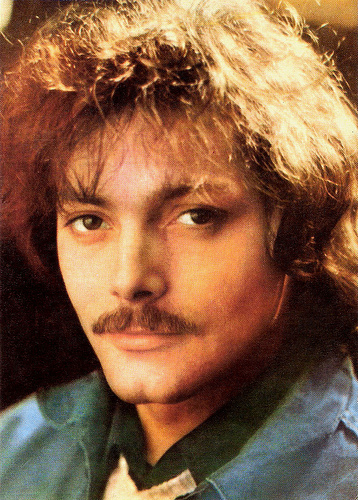
Rumanian postcard by Casa Filmului Acin, no. cd. 43 157.
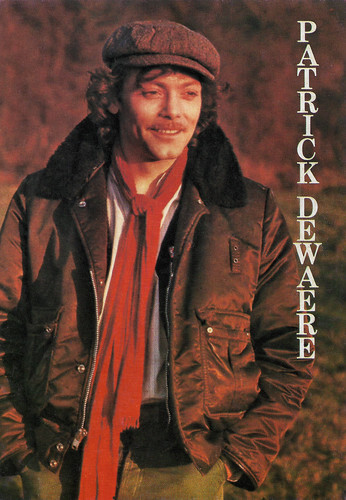
French postcard by Editions F. Nugeron, Tessancourt, no. R 5B.
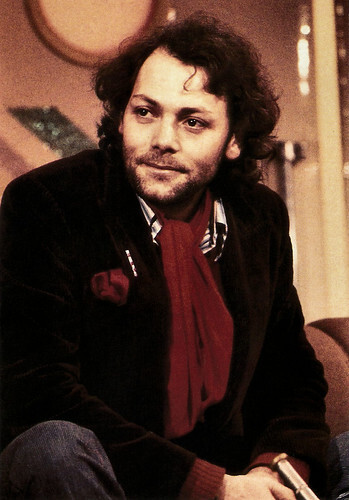
French postcard by Editions Humour à la Carte, Paris, no. 3735.
Sensitivity and isolation
Patrick Dewaere was born Patrick Jean Marie Henri Bourdeaux in Saint-Brieuc in Britanny, in the northwest region of France, in 1947. He was the third of six children of actress Mado Maurin. His five siblings, Jean-Pierre Maurin (1941-1996), Yves-Marie Maurin (1944), Dominique Maurin (1949), Jean-Francois Maurin (1957) and Marie-Veronique Maurin (1960), all became actors, with varying degrees of success.
Patrick made his film debut at the age of four under the name Patrick Maurin in Monsieur Fabre/Amazing Monsieur Fabre (Henri Diamant Berger, 1951) featuring Pierre Fresnay . More small film roles followed in La Madelon (Jean Boyer, 1954) with Line Renaud , and En effeuillant la marguerite/Plucking the Daisy (Marc Allégret, 1956) starring Brigitte Bardot and Daniel Gélin .
Taunted by his schoolyard friends for his young film endeavours, he learned sensitivity and isolation at an early age. Other films during this period included Gene Kelly 's The Happy Road (1957) and the comedy Mimi Pinson (Robert Darène, 1958) with Dany Robin .
As a young adult in the early 1960s, Patrick appeared on French television and in the star-studded war film Paris brûle-t-il?/Is Paris burning? (René Clément, 1966). In 1968, he joined the Café de la Gare, an experimental theatre troupe where he remained for nearly a decade. The performers also included such future stars as Gérard Depardieu and Miou-Miou .
He became romantically involved with Miou-Miou. A child, Angèle Herry-Leclerc, was born to this liaison in 1974, but the couple broke up after only two years. After initially appearing under the pseudonym Patrick Maurin, he finally opted for Dewaere, which was his grandmother's maiden name. In this period he played small parts in films. The best was the art-house hit Themroc (Claude Faraldo, 1973), an absurdist black comedy starring Michel Piccoli as an urban caveman.
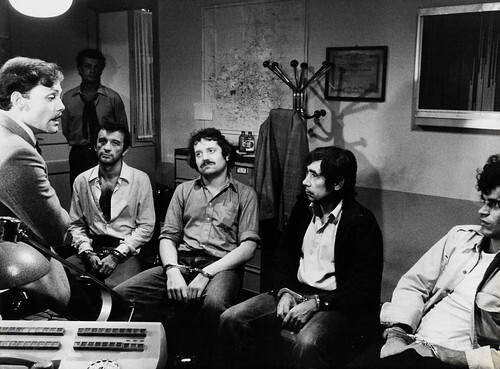
Vintage French press photo. Patrick Dewaere and Philippe Léotard in Le juge Fayard dit le Sheriff/Judge Fayard Called the Sheriff (Yves Boisset, 1977).
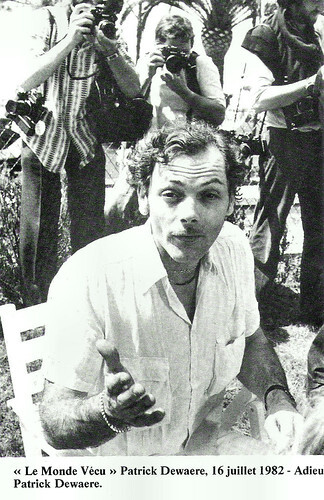
French postcard in the Le Monde Vécu series by Editions SEPPMG, Paris, Serie 3D, no. 000012. Caption. "The Living World". Patrick Dewaere, 16 July 1982. Farewell Patrick Dewaere.
Instant anti-hero stardom
Patrick Dewaere made his breakthrough in the cinema with his major role in Bertrand Blier's anarchic comedy Les Valseuses/Going Places (1974). Gérard Depardieu and Dewaere played two young rebellious petty thugs who team up with Miou-Miou . The three earned instant ‘anti-hero’ stardom with their roles. He followed this with the romantic comedy Lily, aime-moi (Maurice Dugowson, 1975), and the crime drama Adieu, poulet/The French Detective (Pierre Granier-Deferre, 1975) as Lino Ventura 's sidekick.
Despite Dewaere's obvious talent for comedy, he was often successfully cast as a fragile, neurotic individual. He earned marks for his off-balanced role in La meilleure façon de marcher/The Best Way to Walk (Claude Miller, 1976). In Italy he appeared in Marcia trionfale/Victory March (Marco Bellocchio, 1976) with Michele Placido and Franco Nero , and in L'ingorgo - Una storia impossibile/Black Out in Autostrada (Luigi Comencini, 1979) about the biggest traffic jam ever seen.
He starred again with Depardieu in Blier's Oscar-winning cross-over comedy Préparez vos mouchoirs/Get Out Your Handkerchiefs (Bertrand Blier, 1978). Gary Brumburgh writes at IMDb : “Infinitely more interested in searching out complex roles than fame, his work in films were more often than not experimental, low budget and quirky in style. He appeared innately drawn to playing sensitive, scruffy, miserable neurotics, misfits and losers.“ Examples are his characters in the soccer drama Coup de tête/Hothead (Jean-Jacques Annaud, 1979), the detective Série noire (1979, Alain Corneau), Un mauvais fils/A Bad Son (Claude Sautet, 1980), Hôtel des Amériques/Hotel America (André Téchiné, 1981) with Catherine Deneuve , and the critically-acclaimed Beau-père/Stepfather (Bertrand Blier, 1981).
Unlike his counterpart Depardieu, Patrick's fame never branched out to Hollywood, but he was recognized consistently for his superlative portrayals. Amazingly, he was nominated for seven César awards (the French Oscar) but never won. Shortly after the release of Paradis Pour Tous/Paradise for All (Alain Jessua, 1982), a black comedy where his character suffers from depression and commits suicide, the actor shot himself with a rifle in a Paris hotel.
Patrick Dewaere was 35 years old. At the time he was working on Claude Lelouch's film Édith et Marcel/Edith and Marcel (1983). A shocking, inexplicable end to friends, fans and family alike. For eleven years Dewaere was married to French actress Sotha. They had one daughter, Lola. A year after his death, the Patrick Dewaere Award was established in France. The actor was the subject of the French documentary Patrick Dewaere, which was shown at the 1992 Cannes Film Festival.
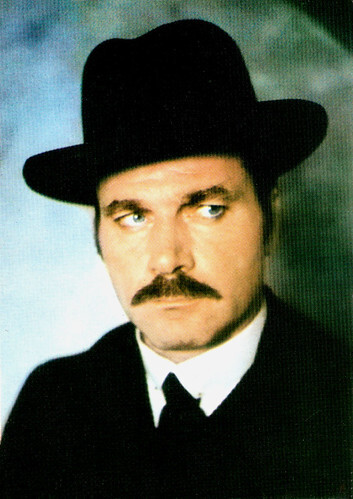
Franco Nero . Rumanian postcard by Casa Filmului Acin.
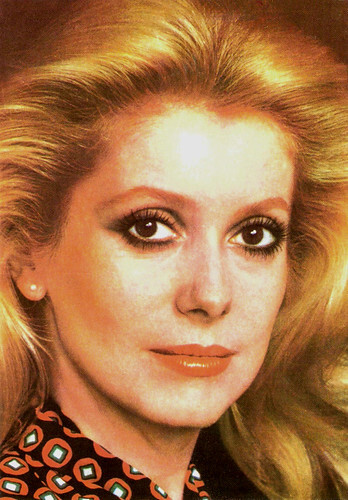
Catherine Deneuve . Rumanian postcard by Casa Filmului Acin.
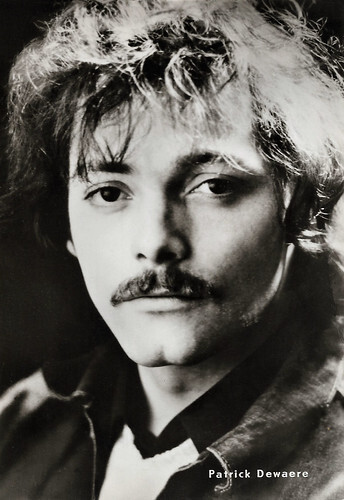
East German postcard by VEB Progress Film-Verleih, Berlin, no. 98/78. Photo: Unifrance.
Sources: Yuri German (AllMovie), (IMDb), Wikipedia and .

Rumanian postcard by Casa Filmului Acin, no. cd. 43 157.

French postcard by Editions F. Nugeron, Tessancourt, no. R 5B.

French postcard by Editions Humour à la Carte, Paris, no. 3735.
Sensitivity and isolation
Patrick Dewaere was born Patrick Jean Marie Henri Bourdeaux in Saint-Brieuc in Britanny, in the northwest region of France, in 1947. He was the third of six children of actress Mado Maurin. His five siblings, Jean-Pierre Maurin (1941-1996), Yves-Marie Maurin (1944), Dominique Maurin (1949), Jean-Francois Maurin (1957) and Marie-Veronique Maurin (1960), all became actors, with varying degrees of success.
Patrick made his film debut at the age of four under the name Patrick Maurin in Monsieur Fabre/Amazing Monsieur Fabre (Henri Diamant Berger, 1951) featuring Pierre Fresnay . More small film roles followed in La Madelon (Jean Boyer, 1954) with Line Renaud , and En effeuillant la marguerite/Plucking the Daisy (Marc Allégret, 1956) starring Brigitte Bardot and Daniel Gélin .
Taunted by his schoolyard friends for his young film endeavours, he learned sensitivity and isolation at an early age. Other films during this period included Gene Kelly 's The Happy Road (1957) and the comedy Mimi Pinson (Robert Darène, 1958) with Dany Robin .
As a young adult in the early 1960s, Patrick appeared on French television and in the star-studded war film Paris brûle-t-il?/Is Paris burning? (René Clément, 1966). In 1968, he joined the Café de la Gare, an experimental theatre troupe where he remained for nearly a decade. The performers also included such future stars as Gérard Depardieu and Miou-Miou .
He became romantically involved with Miou-Miou. A child, Angèle Herry-Leclerc, was born to this liaison in 1974, but the couple broke up after only two years. After initially appearing under the pseudonym Patrick Maurin, he finally opted for Dewaere, which was his grandmother's maiden name. In this period he played small parts in films. The best was the art-house hit Themroc (Claude Faraldo, 1973), an absurdist black comedy starring Michel Piccoli as an urban caveman.

Vintage French press photo. Patrick Dewaere and Philippe Léotard in Le juge Fayard dit le Sheriff/Judge Fayard Called the Sheriff (Yves Boisset, 1977).

French postcard in the Le Monde Vécu series by Editions SEPPMG, Paris, Serie 3D, no. 000012. Caption. "The Living World". Patrick Dewaere, 16 July 1982. Farewell Patrick Dewaere.
Instant anti-hero stardom
Patrick Dewaere made his breakthrough in the cinema with his major role in Bertrand Blier's anarchic comedy Les Valseuses/Going Places (1974). Gérard Depardieu and Dewaere played two young rebellious petty thugs who team up with Miou-Miou . The three earned instant ‘anti-hero’ stardom with their roles. He followed this with the romantic comedy Lily, aime-moi (Maurice Dugowson, 1975), and the crime drama Adieu, poulet/The French Detective (Pierre Granier-Deferre, 1975) as Lino Ventura 's sidekick.
Despite Dewaere's obvious talent for comedy, he was often successfully cast as a fragile, neurotic individual. He earned marks for his off-balanced role in La meilleure façon de marcher/The Best Way to Walk (Claude Miller, 1976). In Italy he appeared in Marcia trionfale/Victory March (Marco Bellocchio, 1976) with Michele Placido and Franco Nero , and in L'ingorgo - Una storia impossibile/Black Out in Autostrada (Luigi Comencini, 1979) about the biggest traffic jam ever seen.
He starred again with Depardieu in Blier's Oscar-winning cross-over comedy Préparez vos mouchoirs/Get Out Your Handkerchiefs (Bertrand Blier, 1978). Gary Brumburgh writes at IMDb : “Infinitely more interested in searching out complex roles than fame, his work in films were more often than not experimental, low budget and quirky in style. He appeared innately drawn to playing sensitive, scruffy, miserable neurotics, misfits and losers.“ Examples are his characters in the soccer drama Coup de tête/Hothead (Jean-Jacques Annaud, 1979), the detective Série noire (1979, Alain Corneau), Un mauvais fils/A Bad Son (Claude Sautet, 1980), Hôtel des Amériques/Hotel America (André Téchiné, 1981) with Catherine Deneuve , and the critically-acclaimed Beau-père/Stepfather (Bertrand Blier, 1981).
Unlike his counterpart Depardieu, Patrick's fame never branched out to Hollywood, but he was recognized consistently for his superlative portrayals. Amazingly, he was nominated for seven César awards (the French Oscar) but never won. Shortly after the release of Paradis Pour Tous/Paradise for All (Alain Jessua, 1982), a black comedy where his character suffers from depression and commits suicide, the actor shot himself with a rifle in a Paris hotel.
Patrick Dewaere was 35 years old. At the time he was working on Claude Lelouch's film Édith et Marcel/Edith and Marcel (1983). A shocking, inexplicable end to friends, fans and family alike. For eleven years Dewaere was married to French actress Sotha. They had one daughter, Lola. A year after his death, the Patrick Dewaere Award was established in France. The actor was the subject of the French documentary Patrick Dewaere, which was shown at the 1992 Cannes Film Festival.

Franco Nero . Rumanian postcard by Casa Filmului Acin.

Catherine Deneuve . Rumanian postcard by Casa Filmului Acin.

East German postcard by VEB Progress Film-Verleih, Berlin, no. 98/78. Photo: Unifrance.
Sources: Yuri German (AllMovie), (IMDb), Wikipedia and .
Published on February 24, 2024 22:00
February 23, 2024
Sally Field
American screen and stage actress Sally Field (1946) has received many accolades throughout her career spanning over five decades, including two Academy Awards, two Golden Globe Awards, and three Primetime Emmy Awards, in addition to nominations for a Tony Award and two British Academy Film Awards. She began her career on television, starring in the comedies Gidget (1965–1966), The Flying Nun (1967–1970), and The Girl with Something Extra (1973–1974).

British postcard by Klasik Kards, London, no. 1589. Sally Field in the TV series The Flying Nun (1967-1970).
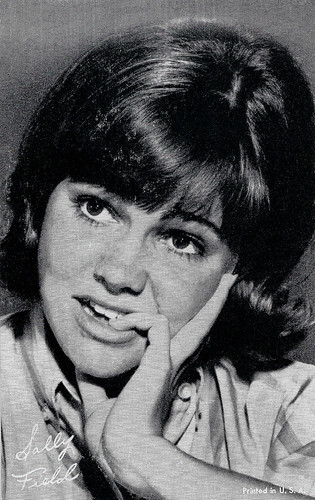
American Arcade card.
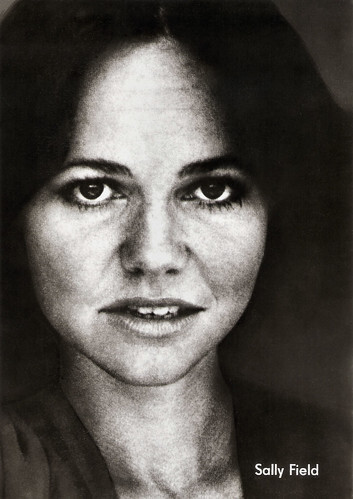
Big East German Starfoto by VEB Progress Film-Verleih, Berlin, no. 71/80s.
Sister Bertrille
Sally Margaret Field was born in 1946, in Pasadena, California, to Margaret Field (née Morlan), an actress, and Richard Dryden Field, who served in the Army during World War II. Her brother is Richard D. Field, a physicist and an academic. Her parents were divorced in 1950. In 1952, her mother married Jock Mahoney, an actor and a stuntman. Field said in her 2018 memoir that she was sexually abused by Mahoney during her childhood.
As a teen, Field attended Portola Middle School and Birmingham High School in Van Nuys, where she was a cheerleader. Her film debut was as an extra (a Beatnik girl) in Moon Pilot (James Neilson, 1962). Field got her start on television as the boy-crazy surfer girl in the sitcom Gidget (1965–1966). The show was not an initial success and was cancelled after a single season; however, summer reruns garnered respectable ratings, making the show a belated success.
Wanting to find a new starring vehicle for Field, ABC produced The Flying Nun with Field cast as Sister Bertrille. Field found the concept of the show silly and refused the role at first, only to resettle on it after her stepfather, Jock Mahoney, warned her that she might not work again in show business if she did not accept the role. Screen Gems dismissed its second choice, Ronne Troup, who had already begun filming the pilot. Field recalled hanging from a crane and being humiliated by a parade of episodic television directors, one of whom grabbed her shoulders and moved her into position as if she were a prop.
The Flying Nun (1967-1970) centred on the adventures of a community of nuns in the Convent San Tanco in San Juan, Puerto Rico. The comic elements of the storyline were provided by the flying ability of the 90-pound novice Sister Bertrille, whose large headgear, enables her to fly in any stiff breeze. Her gift enables her to aid others, whether they wish it or not. The sitcom produced by Screen Gems for ABC was based on the 1965 book 'The Fifteenth Pelican', written by Tere Rios. The series was developed by Bernard Slade. The Flying Nun originally ran on ABC from 7 September 1967 to 3 April 1970, producing 82 episodes, including a one-hour pilot episode. Field credits co-star Madeleine Sherwood for encouraging her to enrol in acting classes. She also later commented that she has great affection for her young Gidget persona and was proud of her work on that show, but she has also admitted that she disliked and was embarrassed with The Flying Nun.
Phil Lindholm at IMDb : "Watching a show like The Flying Nun is like experiencing part of a 60's time capsule (in the best sense) because it's light years away from today's television fare. Starring the young Sally Field as a novice at the Convent San Tanco in Puerto Rico (who, incidentally, can fly) and co-starring such worthies as Madeleine Sherwood (as Mother Superior), Alejandro Rey (as playboy Carlos Ramirez) and Marge Redmond (as Sister Jacqueline), the makers of the show actually triumphed over its admittedly outrageous premise and crafted a series full of humor and heart. Field was ideally cast as Sister Bertrille (the former Elsie Etherington) who eventually wins over even the staid Mother Superior with her undeniable charm, high spirits and always good intentions. The gradual way in which she endears herself to The Reverend Mother (beautifully played by the gifted Sherwood) and the often exasperated Carlos, is unexpectedly moving."
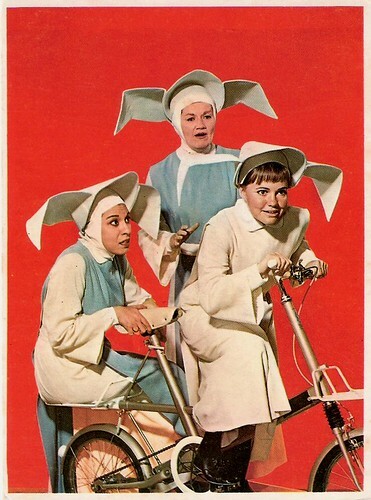
Dutch postcard, no. 2. Marge Redmond, Madeleine Sherwood and Sally Field in The Flying Nun (1967-1970).
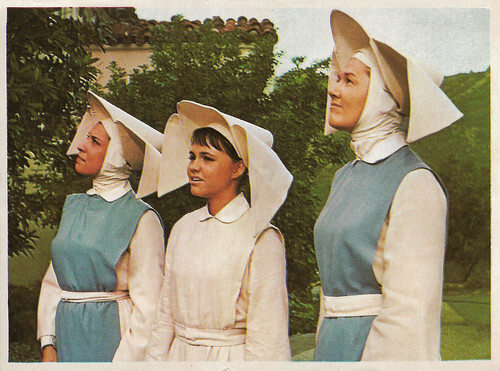
Dutch postcard, no. 6. Marge Redmond, Sally Fieldand Madeleine Sherwood in The Flying Nun (1967-1970).
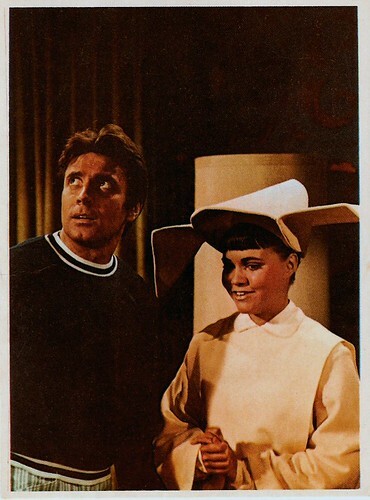
Dutch postcard, no. 9. Sally Field and Alejandro Rey in The Flying Nun (1967-1970).
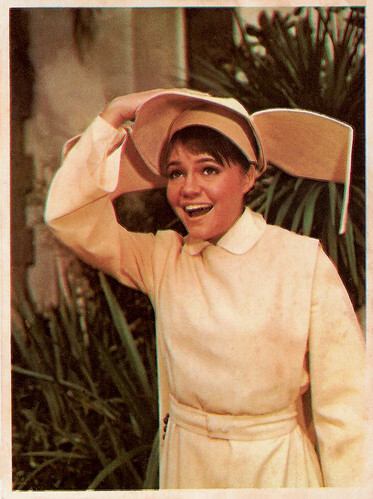
Dutch postcard, no. 10. Sally Field in The Flying Nun (1967-1970).
Moving past her television image of the girl next door
In 1973, Sally Field was cast in a starring role opposite John Davidson in the short-lived series The Girl with Something Extra (1973-1974). Following the series' cancellation, Field studied at the Actors Studio with acting teacher Lee Strasberg. Strasberg became a mentor to Field, helping her move past her television image of the girl next door. During this period, Field divorced her first husband in 1975.
Soon after studying with Strasberg, Field landed the title role in the television film Sybil (Daniel Petrie, 1976), based on the book by Flora Rheta Schreiber. Her dramatic portrayal of a young woman afflicted with dissociative identity disorder earned her an Emmy Award in 1977 and enabled her to break through the typecasting of her sitcom work.
It was followed by starring roles in the films Stay Hungry (Bob Rafelson, 1976) with Jeff Bridges and Arnold Schwarzenegger , Smokey and the Bandit (Hal Needham, 1977) with Burt Reynolds , Heroes (Jeremy Kagan, 1977), The End (Burt Reynolds, 1978), and Hooper (Hal Needham, 1978).She won two Academy Awards for Best Actress for Norma Rae (Martin Ritt, 1979), and Places in the Heart (Robert Benton, 1984). She also played notable roles in Smokey and the Bandit II (Hal Needham, 1980), Absence of Malice (Sydney Pollack, 1981) starring Paul Newman , Murphy's Romance (Martin Ritt, 1985), Steel Magnolias (Herbert Ross, 1989), Soapdish (Michael Hoffman, 1991), Mrs. Doubtfire (Chris Columbus, 1993) starring Robin Wiliams , and Forrest Gump (Robert Zemeckis, 1994) with Tom Hanks .
In the 2000s, Field returned to television with a recurring role on the medical drama ER, for which she won the Primetime Emmy Award for Outstanding Guest Actress in a Drama Series in 2001. For her role as Nora Walker in the ABC drama series Brothers & Sisters (2006-2011), Field won the Primetime Emmy Award for Outstanding Lead Actress in a Drama Series. She portrayed Mary Todd Lincoln in Lincoln (Steven Spielberg, 2012) starring Daniel Day-Lewis , for which she received an Academy Award for Best Supporting Actress nomination. She portrayed Aunt May in The Amazing Spider-Man (Marc Webb, 2012) and its sequel, The Amazing Spider-Man 2 (Marc Webb, 2014).
Sally Field also appeared in the films Hello, My Name Is Doris (Michael Showalter, 2015), and Spoiler Alert (Michael Showalter, 2022), as well as in the Netflix limited series Maniac (Cary Joji Fukunaga, 2018) with Emma Stone. She made her professional stage debut in the Broadway revival of Edward Albee's 'The Goat, or Who Is Sylvia?' in 2002. Field returned to the stage after an absence of 15 years with the 2017 revival of Tennessee Williams's 'The Glass Menagerie', for which she received a nomination for the Tony Award for Best Actress in a Play. She made her debut on the West End theatre in the revival of Arthur Miller's 'All My Sons' in 2019.
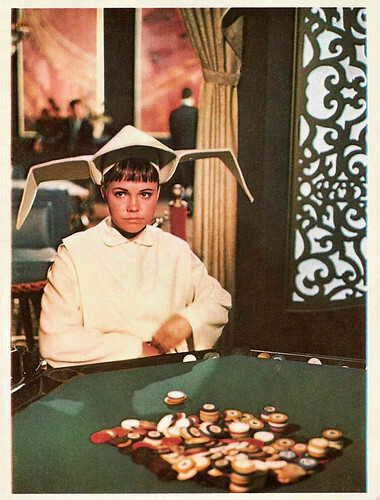
Dutch postcard, no. 12. Sally Field in The Flying Nun (1967-1970).
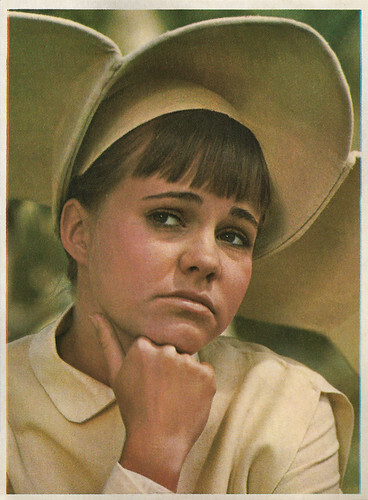
Dutch postcard, no. 14. Sally Field in The Flying Nun (1967-1970).
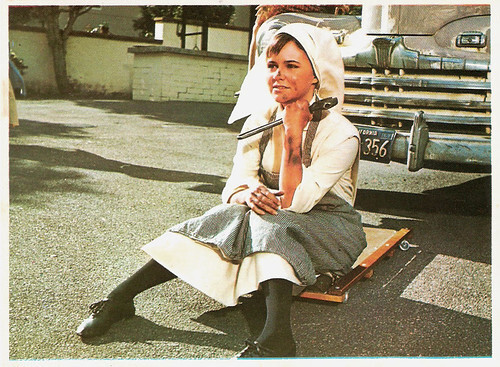
Dutch postcard, no. 22. Sally Field in The Flying Nun (1967-1970).
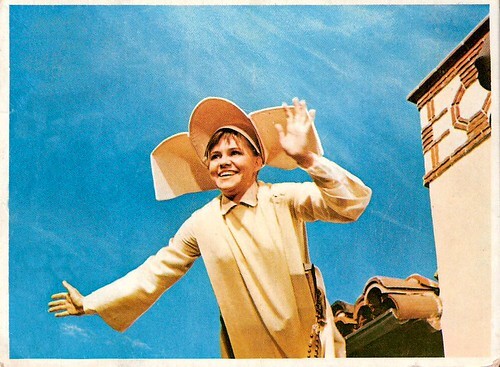
Dutch postcard, no. 24. Sally Field in The Flying Nun (1967-1970).
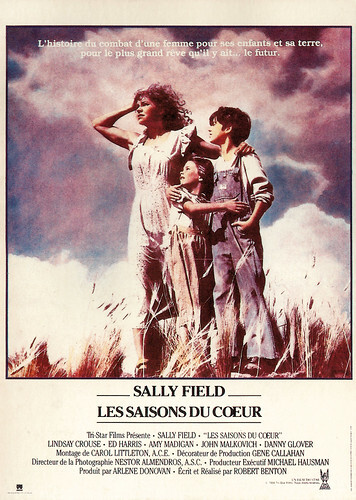
French postcard by Editions F. Nugeron, no. E 225. Image: Tristar. French affiche for Places in the Heart (Robert Benton, 1984) with Sally Field, Gennie James and Yankton Hatten.
Sources: (IMDb), Wikipedia and .

British postcard by Klasik Kards, London, no. 1589. Sally Field in the TV series The Flying Nun (1967-1970).

American Arcade card.

Big East German Starfoto by VEB Progress Film-Verleih, Berlin, no. 71/80s.
Sister Bertrille
Sally Margaret Field was born in 1946, in Pasadena, California, to Margaret Field (née Morlan), an actress, and Richard Dryden Field, who served in the Army during World War II. Her brother is Richard D. Field, a physicist and an academic. Her parents were divorced in 1950. In 1952, her mother married Jock Mahoney, an actor and a stuntman. Field said in her 2018 memoir that she was sexually abused by Mahoney during her childhood.
As a teen, Field attended Portola Middle School and Birmingham High School in Van Nuys, where she was a cheerleader. Her film debut was as an extra (a Beatnik girl) in Moon Pilot (James Neilson, 1962). Field got her start on television as the boy-crazy surfer girl in the sitcom Gidget (1965–1966). The show was not an initial success and was cancelled after a single season; however, summer reruns garnered respectable ratings, making the show a belated success.
Wanting to find a new starring vehicle for Field, ABC produced The Flying Nun with Field cast as Sister Bertrille. Field found the concept of the show silly and refused the role at first, only to resettle on it after her stepfather, Jock Mahoney, warned her that she might not work again in show business if she did not accept the role. Screen Gems dismissed its second choice, Ronne Troup, who had already begun filming the pilot. Field recalled hanging from a crane and being humiliated by a parade of episodic television directors, one of whom grabbed her shoulders and moved her into position as if she were a prop.
The Flying Nun (1967-1970) centred on the adventures of a community of nuns in the Convent San Tanco in San Juan, Puerto Rico. The comic elements of the storyline were provided by the flying ability of the 90-pound novice Sister Bertrille, whose large headgear, enables her to fly in any stiff breeze. Her gift enables her to aid others, whether they wish it or not. The sitcom produced by Screen Gems for ABC was based on the 1965 book 'The Fifteenth Pelican', written by Tere Rios. The series was developed by Bernard Slade. The Flying Nun originally ran on ABC from 7 September 1967 to 3 April 1970, producing 82 episodes, including a one-hour pilot episode. Field credits co-star Madeleine Sherwood for encouraging her to enrol in acting classes. She also later commented that she has great affection for her young Gidget persona and was proud of her work on that show, but she has also admitted that she disliked and was embarrassed with The Flying Nun.
Phil Lindholm at IMDb : "Watching a show like The Flying Nun is like experiencing part of a 60's time capsule (in the best sense) because it's light years away from today's television fare. Starring the young Sally Field as a novice at the Convent San Tanco in Puerto Rico (who, incidentally, can fly) and co-starring such worthies as Madeleine Sherwood (as Mother Superior), Alejandro Rey (as playboy Carlos Ramirez) and Marge Redmond (as Sister Jacqueline), the makers of the show actually triumphed over its admittedly outrageous premise and crafted a series full of humor and heart. Field was ideally cast as Sister Bertrille (the former Elsie Etherington) who eventually wins over even the staid Mother Superior with her undeniable charm, high spirits and always good intentions. The gradual way in which she endears herself to The Reverend Mother (beautifully played by the gifted Sherwood) and the often exasperated Carlos, is unexpectedly moving."

Dutch postcard, no. 2. Marge Redmond, Madeleine Sherwood and Sally Field in The Flying Nun (1967-1970).

Dutch postcard, no. 6. Marge Redmond, Sally Fieldand Madeleine Sherwood in The Flying Nun (1967-1970).

Dutch postcard, no. 9. Sally Field and Alejandro Rey in The Flying Nun (1967-1970).

Dutch postcard, no. 10. Sally Field in The Flying Nun (1967-1970).
Moving past her television image of the girl next door
In 1973, Sally Field was cast in a starring role opposite John Davidson in the short-lived series The Girl with Something Extra (1973-1974). Following the series' cancellation, Field studied at the Actors Studio with acting teacher Lee Strasberg. Strasberg became a mentor to Field, helping her move past her television image of the girl next door. During this period, Field divorced her first husband in 1975.
Soon after studying with Strasberg, Field landed the title role in the television film Sybil (Daniel Petrie, 1976), based on the book by Flora Rheta Schreiber. Her dramatic portrayal of a young woman afflicted with dissociative identity disorder earned her an Emmy Award in 1977 and enabled her to break through the typecasting of her sitcom work.
It was followed by starring roles in the films Stay Hungry (Bob Rafelson, 1976) with Jeff Bridges and Arnold Schwarzenegger , Smokey and the Bandit (Hal Needham, 1977) with Burt Reynolds , Heroes (Jeremy Kagan, 1977), The End (Burt Reynolds, 1978), and Hooper (Hal Needham, 1978).She won two Academy Awards for Best Actress for Norma Rae (Martin Ritt, 1979), and Places in the Heart (Robert Benton, 1984). She also played notable roles in Smokey and the Bandit II (Hal Needham, 1980), Absence of Malice (Sydney Pollack, 1981) starring Paul Newman , Murphy's Romance (Martin Ritt, 1985), Steel Magnolias (Herbert Ross, 1989), Soapdish (Michael Hoffman, 1991), Mrs. Doubtfire (Chris Columbus, 1993) starring Robin Wiliams , and Forrest Gump (Robert Zemeckis, 1994) with Tom Hanks .
In the 2000s, Field returned to television with a recurring role on the medical drama ER, for which she won the Primetime Emmy Award for Outstanding Guest Actress in a Drama Series in 2001. For her role as Nora Walker in the ABC drama series Brothers & Sisters (2006-2011), Field won the Primetime Emmy Award for Outstanding Lead Actress in a Drama Series. She portrayed Mary Todd Lincoln in Lincoln (Steven Spielberg, 2012) starring Daniel Day-Lewis , for which she received an Academy Award for Best Supporting Actress nomination. She portrayed Aunt May in The Amazing Spider-Man (Marc Webb, 2012) and its sequel, The Amazing Spider-Man 2 (Marc Webb, 2014).
Sally Field also appeared in the films Hello, My Name Is Doris (Michael Showalter, 2015), and Spoiler Alert (Michael Showalter, 2022), as well as in the Netflix limited series Maniac (Cary Joji Fukunaga, 2018) with Emma Stone. She made her professional stage debut in the Broadway revival of Edward Albee's 'The Goat, or Who Is Sylvia?' in 2002. Field returned to the stage after an absence of 15 years with the 2017 revival of Tennessee Williams's 'The Glass Menagerie', for which she received a nomination for the Tony Award for Best Actress in a Play. She made her debut on the West End theatre in the revival of Arthur Miller's 'All My Sons' in 2019.

Dutch postcard, no. 12. Sally Field in The Flying Nun (1967-1970).

Dutch postcard, no. 14. Sally Field in The Flying Nun (1967-1970).

Dutch postcard, no. 22. Sally Field in The Flying Nun (1967-1970).

Dutch postcard, no. 24. Sally Field in The Flying Nun (1967-1970).

French postcard by Editions F. Nugeron, no. E 225. Image: Tristar. French affiche for Places in the Heart (Robert Benton, 1984) with Sally Field, Gennie James and Yankton Hatten.
Sources: (IMDb), Wikipedia and .
Published on February 23, 2024 22:00
February 22, 2024
Micheline Presle (1922-2024)
On 21 February, French actress Micheline Presle (1922-2024) passed away at 101. In the 1940s and 1950s, she formed the queen trio of French cinema with Michèle Morgan and Danielle Darrieux. The chic and elegant star gained worldwide attention for Le diable au corps/Devil in the Flesh (Claude Autant-Lara, 1947). The success of this film also earned Presle three roles in a Hollywood production, under the name Micheline Prelle. Over nine decades, La Presle made more than one hundred and fifty films.

French postcard by Edition du Globe (EDUG), Paris, no. 163. Photo: Studio Harcourt.
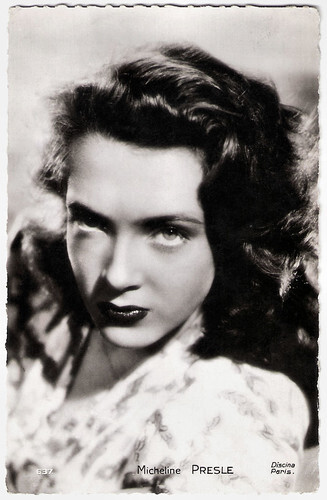
French postcard by Collection Chantal, Paris, no. 637. Photo: Discina, Paris.
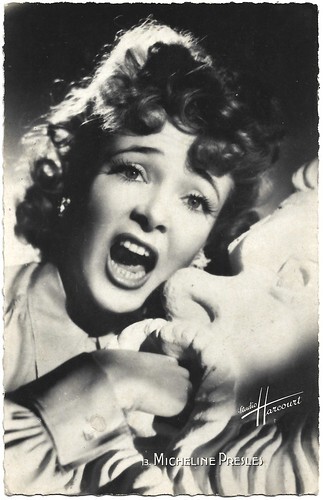
French postcard, no. 13. Photo: Studio Harcourt.
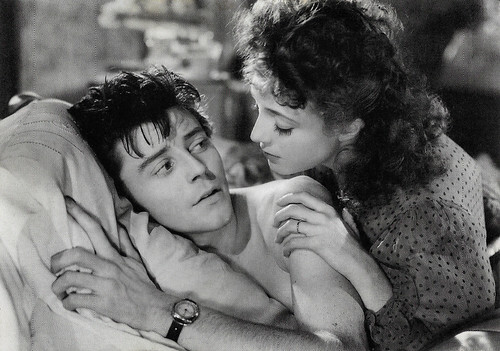
French postcard by Editions La Malibran, Paris, no. CF 23, 1990. Gérard Philipe and Micheline Presle in Le Diable au corps/Devil in the Flesh (Claude Autant-Lara, 1947).
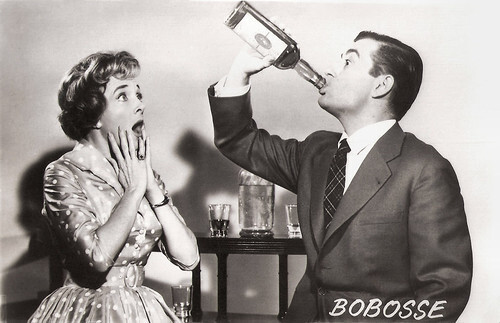
French postcard by Editions P.I., Paris, no. S-1147. Photo: Paramount. Micheline Presle and François Périer in Bobosse (Etienne Périer, 1959).

French postcard by Editions d'art Yvon, Paris, no. 40-110-07. Photo: Parc Film / KIM. Micheline Presle and Jacques Perrin in Peau d'âne/Donkey Skin (Jacques Demy, 1970). Caption: Peau d'âne. Un Conte de Charles Perrault. Un film écrit et réalisé par Jacques Demi (sic). Ma mère, je désire que Peau d'Ane me fasse un gâteau. (Donkey Skin. A Tale by Charles Perrault. A film written and directed by Jacques Demi (sic). My mother, I want Donkey Skin to make me a cake.)
French postcard by Editions P.I., Paris. no. 22. Photo: Studio Carlet Ainé.
Most promising actress
Micheline Presle (sometimes Presles or Prelle) was born Micheline Nicole Julia Émilienne Chassagne in Paris in 1922. She was the daughter of a businessman and took acting classes as a teen. Her film debut was La Fessée/The Buttock (Pierre Caron, 1937) with Albert Préjean . In 1938 she was awarded the Prix Suzanne Bianchetti for the most promising actress. She took the name of Presle after her character's name Jacqueline Presle in Jeune fille en détresse/Girls in Distress (Georg Wilhelm Pabst, 1939).
In the 1930s and the war years, Presle often played the lively young and naive girl. Examples are La nuit fantastique/Fantastic Night (Marcel L'Herbier, 1942) and Falbalas/Paris Frills (Jacques Becker, 1944) with Raymond Rouleau.
Presle became a 'vedette' of French cinema. After the war she played more serious roles as the streetwise young woman, such as the prostitute in Boule de suif/Angel and Sinner (Christian-Jaque, 1946), the adultress in Le diable au corps/Devil in the Flesh (Claude Autant-Lara, 1947), and the ethereal woman coming back from the dead in Les jeux sont faits/Second Chance (Jean Delannoy, 1947).
At the same time, she also played the female lead of Helene/Jone in the major Franco-Italian epic Gli ultimi giorni di Pompei/Sins of Pompei (1950) by Paolo Moffa and Marcel L'Herbier, in whose films she was often performing during the 1940s.
At the summit of her French career, Presle went to the US. She was offered a contract by 20th Century Fox and she worked in Hollywood under the name Prelle. She was first cast in Under My Skin (Jean Negulesco, 1950) with John Garfield, and then in American Guerrilla in the Philipines (Fritz Lang, 1950) with Tyrone Power. She was married to actor-turned-producer William Marshall (1950-54), who directed her in The Adventures of Captain Fabian (William Marshall, 1951), opposite Errol Flynn. The film flopped, Presle disliked Hollywood, divorced Marshall, and returned to France.
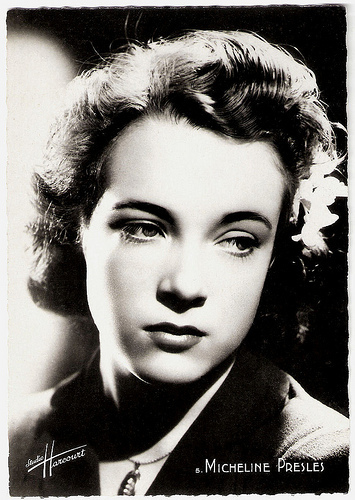
French postcard by SERP, Paris, no. 5. Photo: Studio Harcourt.
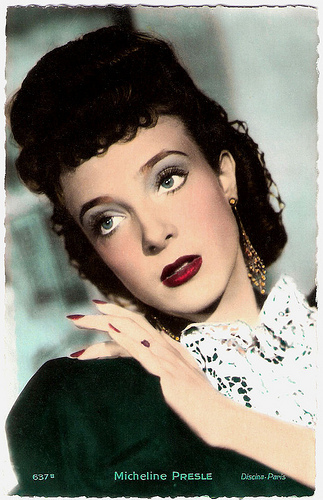
French postcard by Editions Chantal, Rueil, no. 637B. Photo: Discina, Paris.
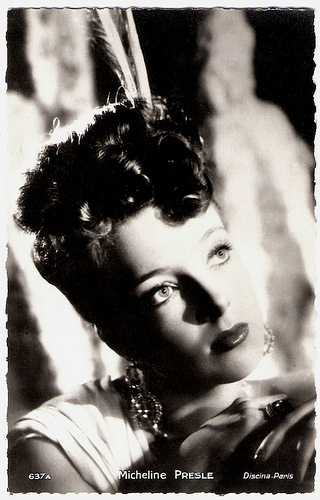
French postcard by Editions Chantal, Rueil, no. 637A. Photo: Discina, Paris.
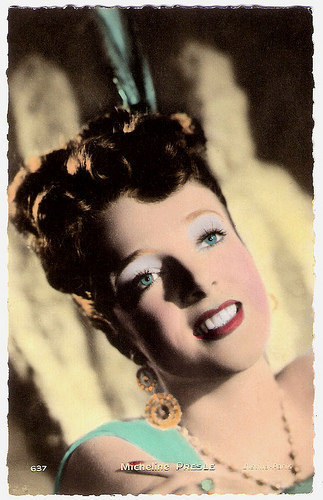
French postcard by Collection Chantal, Paris. no. 637. Photo: Discina, Paris.
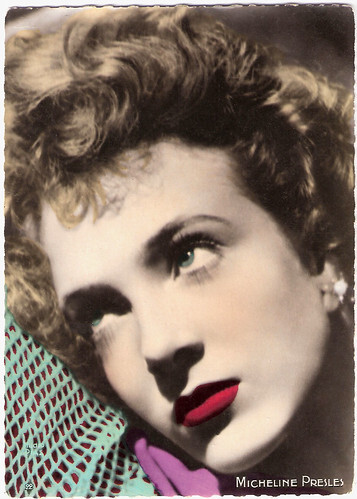
French postcard by Editions P.I., Paris. no. 22. Photo: Studio Piaz.
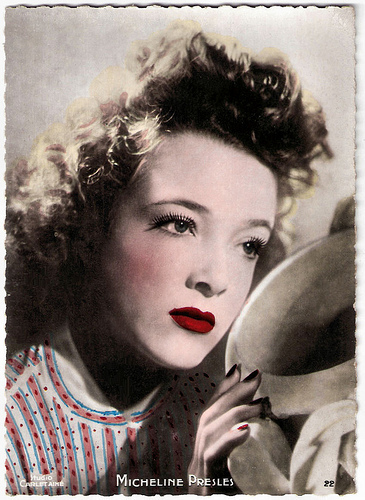
Blind date
Back in France, Micheline Presle played in many films, such as Si Versailles m'était conté/Royal Affairs in Versailles (Sacha Guitry, 1953), Napoléon (Sacha Guitry, 1955), La mariée est trop belle/Her Bridal Night (Pierre Gaspard-Huit, 1956) opposite young Brigitte Bardot , and Christine (Pierre Gaspard-Huit, 1958) with Alain Delon and Romy Schneider .
Presle also performed in Italy in Casa Ricordi/House Ricordi (Carmine Gallone, 1954), Beatrice Cenci/Castle of the Banned Lovers (Riccardo Freda, 1956) and she had a smaller part in Villa Borghese/It Happened in the Park (Gianni Franciolini, Vittorio de Sica, 1953).
In 1959 she played opposite Hardy Kruger in Blind Date (Joseph Losey, 1959) and in 1962 Presle returned to Hollywood to play in the Bobby Darin and Sandra Dee vehicle If a Man Answers (Henry Levin, 1962), and subsequently in The Prize (Mark Robson, 1963) with Paul Newman.
During the 1960s she played in such popular films as Philippe de Broca's Le roi de coeur/The King of Hearts (1965), but also in the art films L'Assassino/The Assassin (Elio Petri, 1961), La Religieuse/The Nun (Jacques Rivette, 1965), Peau d'ane/Monkey Skin (Jacques Demy, 1970), I Want to Go Home (Alain Resnais, 1989), and Mignon è partita/Mignon Has Come to Stay (Francesca Archibugi, 1989). From the early 1960s on, Presle also played in several French TV series, such as the long-running comedy Les saintes chéries (1965-1970). She has appeared frequently on the stage as well.
Presle was nominated for a César as the best supporting actress in I Want to Go Home (Alain Resnais, 1989). Since then, Presle performed regularly in film again. She was very visible in the films of her daughter, Tonie Marshall, such as in Pas très catholique/Something Fishy (Tonie Marshall, 1994) and France boutique (Tonie Marshall, 2003). In 2004, she received a special César for her entire oeuvre. At a very high age, Micheline Presle appeared in Thelma, Louise et Chantal (Benoît Pétré, 2010) starring Jane Birkin , and in the short family drama Je montrerai mes seins/I Show My Tits (Eduardo Sosa Soria, 2013). Her last cameo was in the film Tu veux... ou tu veux pas? (Tonie Marshall, 2014).Micheline Presle died of natural causes in 2024 in Nogent-sur-Marne (Val-de-Marne). She was 101. Her daughter Tonie Marshall passed away four years earlier.
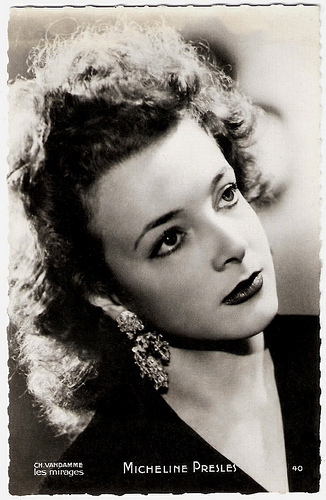
French postcard by Editions P.I., Paris. no. 40. Photo: Charles Vandamme, Les Mirages.
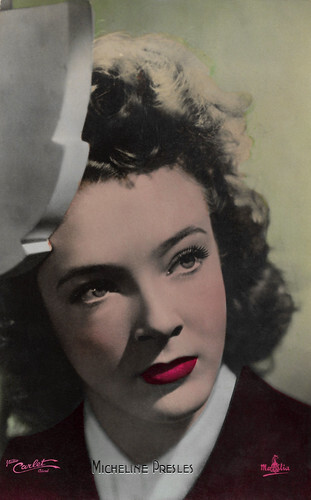
French postcard by Massilia. Photo: Studio Carlet Ainé.
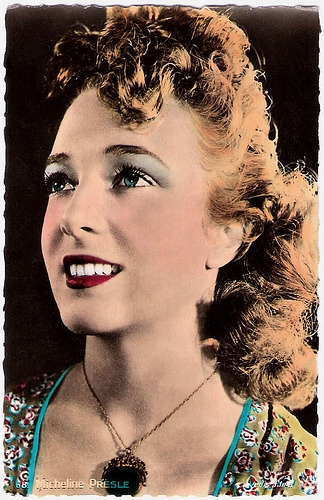
French postcard by Edit. Chantal, Rueil. no. 68. Photo: Védis Films.
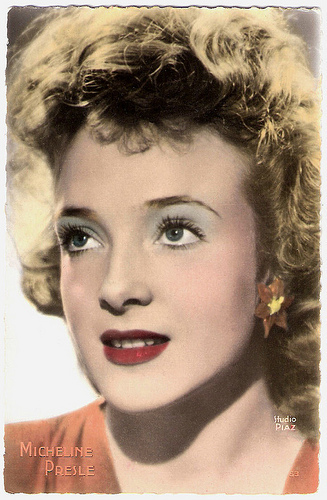
French postcard by Edit. O.P., Paris. no. 53. Photo: Studio Piaz.
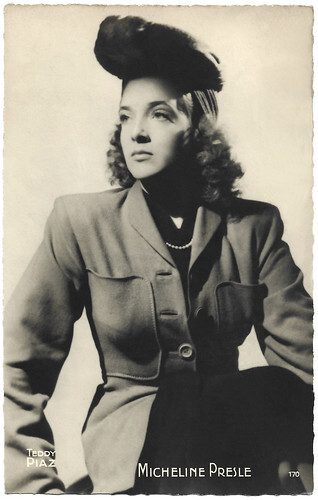
French postcard by Editions O.P., Paris, no. 170. Photo: Teddy Piaz.
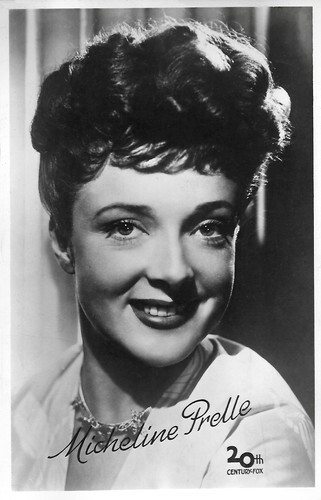
Dutch postcard, no. 3140. Photo: 20th Century Fox. Presle's stage name in Hollywood was Micheline Prelle.
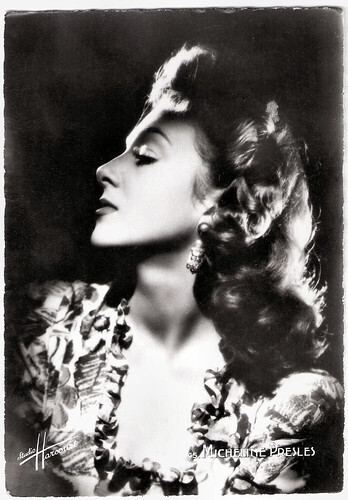
French postcard by Greff Editeur, Paris, no. 45. Photo: Studio Harcourt.
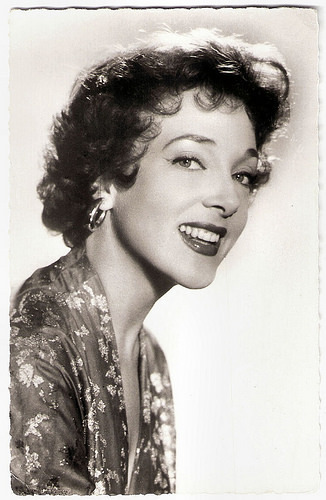
French postcard by Editions du Globe, Paris. no. 619. Photo: Sam Lévin , Paris.
Sources: Hans Beerekamp (Het Schimmenrijk - Ducth), (IMDb), Allociné, Wikipedia, and .

French postcard by Edition du Globe (EDUG), Paris, no. 163. Photo: Studio Harcourt.

French postcard by Collection Chantal, Paris, no. 637. Photo: Discina, Paris.

French postcard, no. 13. Photo: Studio Harcourt.

French postcard by Editions La Malibran, Paris, no. CF 23, 1990. Gérard Philipe and Micheline Presle in Le Diable au corps/Devil in the Flesh (Claude Autant-Lara, 1947).

French postcard by Editions P.I., Paris, no. S-1147. Photo: Paramount. Micheline Presle and François Périer in Bobosse (Etienne Périer, 1959).

French postcard by Editions d'art Yvon, Paris, no. 40-110-07. Photo: Parc Film / KIM. Micheline Presle and Jacques Perrin in Peau d'âne/Donkey Skin (Jacques Demy, 1970). Caption: Peau d'âne. Un Conte de Charles Perrault. Un film écrit et réalisé par Jacques Demi (sic). Ma mère, je désire que Peau d'Ane me fasse un gâteau. (Donkey Skin. A Tale by Charles Perrault. A film written and directed by Jacques Demi (sic). My mother, I want Donkey Skin to make me a cake.)
French postcard by Editions P.I., Paris. no. 22. Photo: Studio Carlet Ainé.
Most promising actress
Micheline Presle (sometimes Presles or Prelle) was born Micheline Nicole Julia Émilienne Chassagne in Paris in 1922. She was the daughter of a businessman and took acting classes as a teen. Her film debut was La Fessée/The Buttock (Pierre Caron, 1937) with Albert Préjean . In 1938 she was awarded the Prix Suzanne Bianchetti for the most promising actress. She took the name of Presle after her character's name Jacqueline Presle in Jeune fille en détresse/Girls in Distress (Georg Wilhelm Pabst, 1939).
In the 1930s and the war years, Presle often played the lively young and naive girl. Examples are La nuit fantastique/Fantastic Night (Marcel L'Herbier, 1942) and Falbalas/Paris Frills (Jacques Becker, 1944) with Raymond Rouleau.
Presle became a 'vedette' of French cinema. After the war she played more serious roles as the streetwise young woman, such as the prostitute in Boule de suif/Angel and Sinner (Christian-Jaque, 1946), the adultress in Le diable au corps/Devil in the Flesh (Claude Autant-Lara, 1947), and the ethereal woman coming back from the dead in Les jeux sont faits/Second Chance (Jean Delannoy, 1947).
At the same time, she also played the female lead of Helene/Jone in the major Franco-Italian epic Gli ultimi giorni di Pompei/Sins of Pompei (1950) by Paolo Moffa and Marcel L'Herbier, in whose films she was often performing during the 1940s.
At the summit of her French career, Presle went to the US. She was offered a contract by 20th Century Fox and she worked in Hollywood under the name Prelle. She was first cast in Under My Skin (Jean Negulesco, 1950) with John Garfield, and then in American Guerrilla in the Philipines (Fritz Lang, 1950) with Tyrone Power. She was married to actor-turned-producer William Marshall (1950-54), who directed her in The Adventures of Captain Fabian (William Marshall, 1951), opposite Errol Flynn. The film flopped, Presle disliked Hollywood, divorced Marshall, and returned to France.

French postcard by SERP, Paris, no. 5. Photo: Studio Harcourt.

French postcard by Editions Chantal, Rueil, no. 637B. Photo: Discina, Paris.

French postcard by Editions Chantal, Rueil, no. 637A. Photo: Discina, Paris.

French postcard by Collection Chantal, Paris. no. 637. Photo: Discina, Paris.

French postcard by Editions P.I., Paris. no. 22. Photo: Studio Piaz.

Blind date
Back in France, Micheline Presle played in many films, such as Si Versailles m'était conté/Royal Affairs in Versailles (Sacha Guitry, 1953), Napoléon (Sacha Guitry, 1955), La mariée est trop belle/Her Bridal Night (Pierre Gaspard-Huit, 1956) opposite young Brigitte Bardot , and Christine (Pierre Gaspard-Huit, 1958) with Alain Delon and Romy Schneider .
Presle also performed in Italy in Casa Ricordi/House Ricordi (Carmine Gallone, 1954), Beatrice Cenci/Castle of the Banned Lovers (Riccardo Freda, 1956) and she had a smaller part in Villa Borghese/It Happened in the Park (Gianni Franciolini, Vittorio de Sica, 1953).
In 1959 she played opposite Hardy Kruger in Blind Date (Joseph Losey, 1959) and in 1962 Presle returned to Hollywood to play in the Bobby Darin and Sandra Dee vehicle If a Man Answers (Henry Levin, 1962), and subsequently in The Prize (Mark Robson, 1963) with Paul Newman.
During the 1960s she played in such popular films as Philippe de Broca's Le roi de coeur/The King of Hearts (1965), but also in the art films L'Assassino/The Assassin (Elio Petri, 1961), La Religieuse/The Nun (Jacques Rivette, 1965), Peau d'ane/Monkey Skin (Jacques Demy, 1970), I Want to Go Home (Alain Resnais, 1989), and Mignon è partita/Mignon Has Come to Stay (Francesca Archibugi, 1989). From the early 1960s on, Presle also played in several French TV series, such as the long-running comedy Les saintes chéries (1965-1970). She has appeared frequently on the stage as well.
Presle was nominated for a César as the best supporting actress in I Want to Go Home (Alain Resnais, 1989). Since then, Presle performed regularly in film again. She was very visible in the films of her daughter, Tonie Marshall, such as in Pas très catholique/Something Fishy (Tonie Marshall, 1994) and France boutique (Tonie Marshall, 2003). In 2004, she received a special César for her entire oeuvre. At a very high age, Micheline Presle appeared in Thelma, Louise et Chantal (Benoît Pétré, 2010) starring Jane Birkin , and in the short family drama Je montrerai mes seins/I Show My Tits (Eduardo Sosa Soria, 2013). Her last cameo was in the film Tu veux... ou tu veux pas? (Tonie Marshall, 2014).Micheline Presle died of natural causes in 2024 in Nogent-sur-Marne (Val-de-Marne). She was 101. Her daughter Tonie Marshall passed away four years earlier.

French postcard by Editions P.I., Paris. no. 40. Photo: Charles Vandamme, Les Mirages.

French postcard by Massilia. Photo: Studio Carlet Ainé.

French postcard by Edit. Chantal, Rueil. no. 68. Photo: Védis Films.

French postcard by Edit. O.P., Paris. no. 53. Photo: Studio Piaz.

French postcard by Editions O.P., Paris, no. 170. Photo: Teddy Piaz.

Dutch postcard, no. 3140. Photo: 20th Century Fox. Presle's stage name in Hollywood was Micheline Prelle.

French postcard by Greff Editeur, Paris, no. 45. Photo: Studio Harcourt.

French postcard by Editions du Globe, Paris. no. 619. Photo: Sam Lévin , Paris.
Sources: Hans Beerekamp (Het Schimmenrijk - Ducth), (IMDb), Allociné, Wikipedia, and .
Published on February 22, 2024 22:00
February 21, 2024
Tamara Desni
Exotic, brunette actress Tamara Desni (1910–2008) was the daughter of Ukrainian-born film star Xenia Desni. Tamara started her stage and film career as a child in Berlin and appeared in several British films during the 1930s and 1940s.
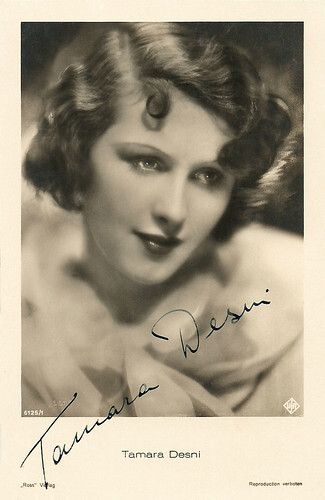
German postcard by Ross Verlag, Berlin, no. 6125/1, 1931-1932. Photo: Ufa. Collection: Didier Hanson.
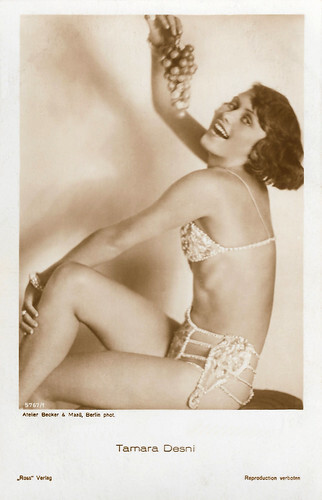
German postcard by Ross Verlag, no. 5767/1, 1930-1931. Photo: Becker & Maas, Berlin.
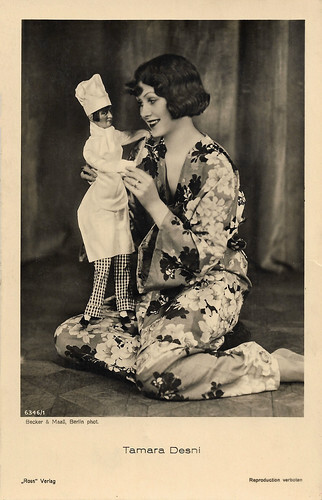
German postcard by Ross Verlag, no. 6346/1, 1931-1932. Photo: Becker & Maas, Berlin.
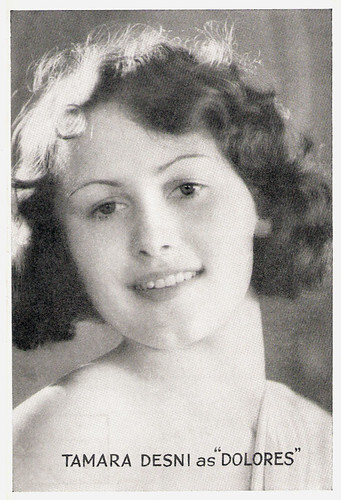
British postcard for Coliseum Theatre, London. Photo: publicity still for the play 'Casanova'.
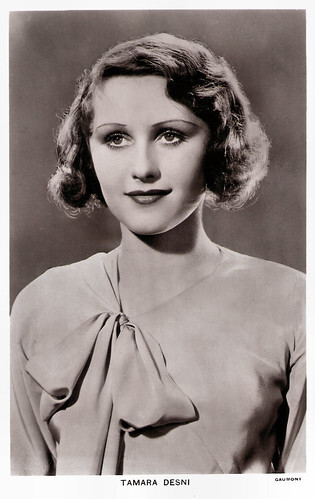
British postcard in the Picturegoer Series, London, no. 795. Photo: Gaumont.
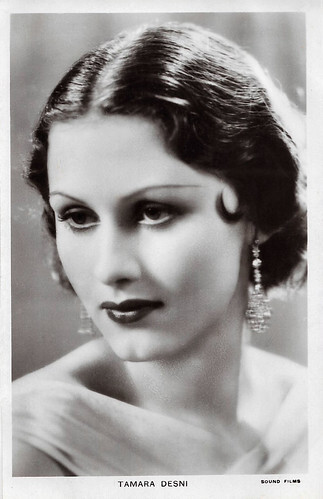
British postcard in the Picturegoer Series, London, no. 795a. Photo: Sound Films.
Fire Over England
Tamara Desni was born Tamara Brodsky, in Berlin in 1910 (some sources say 1913). She was the daughter of Ukrainian-born film star Xenia Desni . She took her mother's surname as her stage name. Her father, James Brodsky, left his family to settle in the United States. Tamara studied ballet as a child and appeared on stage.
In 1929, while a teenager, she married Hans Wilhelm, a dentist, but they divorced a year later. She also played in German films like the comedy Der Schrecken der Garnison/Terror of the Garrison (Carl Boese, 1931) with Felix Bressart , and Im Geheimdienst/In the Employ of the Secret Service (Gustav Ucicky, 1931) starring Brigitte Helm .
That same year she came with her mother to London for a stage role in the operetta 'White Horse Inn' (1931). For this spectacular production, credited with saving the Coliseum, which was faltering as a music hall, the entire theatre was transformed into the Tyrol. The production was based on the German operetta 'Im weissen Roessl', which had been a great success in her then home town, Berlin, the year before. 'White Horse Inn' was a smash hit and ran for 500 performances at the Coliseum Theatre. She followed this up with another leading role at the Coliseum in a German import, the musical 'Casanova', featuring music by Johann Strauss, Jr. His music was adapted by Ralph Benatsky, who had done much the same kind of thing for 'White Horse Inn' with music from various Viennese composers, including Robert Stolz.
Desni's British film career took off with the comedy Falling for You (Robert Stevenson, Jack Hulbert, 1933), supporting the popular musical comedy team of Jack Hulbert and Cicely Courtneidge . Her next films were the thriller Forbidden Territory (Phil Rosen, 1934) starring Gregory Ratoff, another Jack Hulbert comedy Jack Ahoy (Walter Forde, 1935) and the musical romance Bypass to Happiness/The Diplomatic Lover (Anthony Kimmins, 1934) starring Harold French. She played the lead in Dark World (Bernard Vorhaus, 1935), but the film, released by Fox Film Corporation, is now considered lost.
Desni played a supporting part in the historical drama Fire Over England (William K. Howard, 1937), notable for providing the first pairing of Laurence Olivier and Vivien Leigh . Leigh's performance in the film helped to convince David O. Selznick to cast her as Scarlett O'Hara in his production of Gone with the Wind. Mike Cummings at AllMovie : "But what really sets the film apart is the outstanding performance of Flora Robson as a stout-hearted, quick-tongued Queen Elizabeth I. Robson delivers barbs at court as sharp as the crossed swords on the field of battle. In private, though, she exhibits a gentle side, even spoon-feeding broth to her ailing counsellor, Baron Burleigh, portrayed with grandfatherly benignity by Morton Selten. The plot moves swiftly, depicting battles, captures, narrow escapes, and wooing on the fly -- all enhanced by the stunning black-and-white cinematography of James Wong Howe. Richard Addinsell serves up a rousing music score, and two of early filmdom's exquisite beauties -- Tamara Desni (Elena) and Vivien Leigh (Cynthia) -- turn strait-laced Elizabethan gowns into fashion statements."
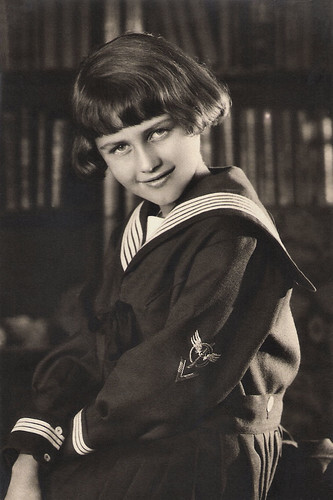
Vintage photo, ca. 1920. A gift from Tatiana.
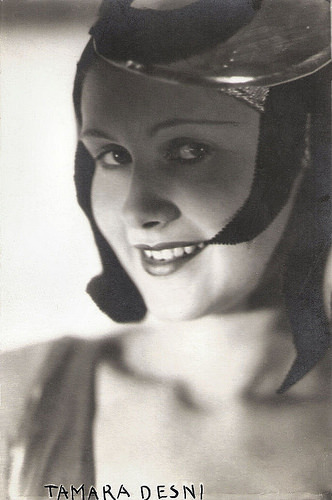
German postcard. Photo: Otto Kurt Vogelsang Lichtbildner, Berlin. From Tatiana.
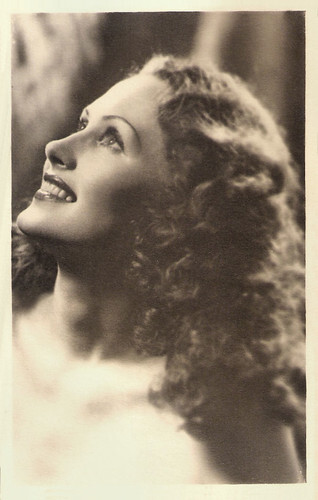
British photo by Vivienne / 20th Century Studios Ltd, London. From Tatiana.
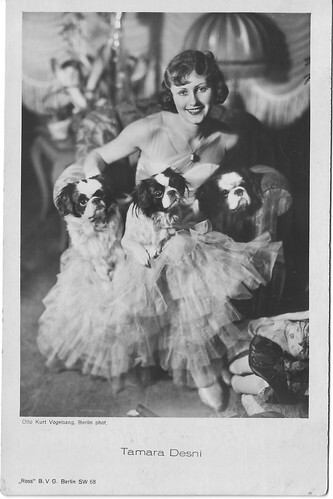
German postcard by Ross Verlag, Berlin. Photo: Otto Kurt Vogelsang, Berlin. From Tatiana.
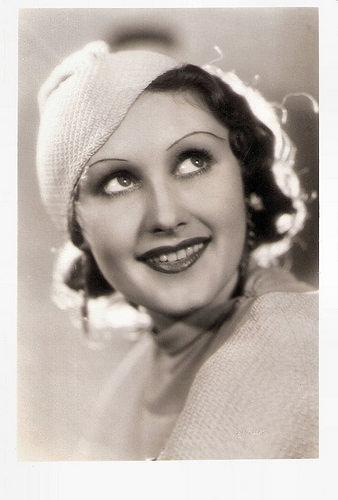
Vintage postcard. From Tatiana.
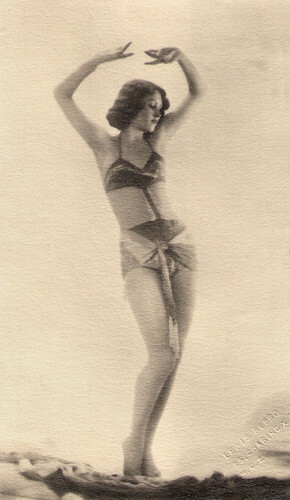
British postcard by Lewis Repro, Charing Cross. From Tatiana.
Lithe steps and high-kicks
Tamara Desni’s film career continued through 1950. She played the lover of a small-time crook in Edgar Wallace's mystery The Squeaker (William K. Howard, 1937), with Robert Newton, Edmund Lowe and Ann Todd . Tom Valance in his obituary in The Independent : "Playing a cabaret performer named Tamara in The Squeaker, she sang two songs, 'He's Gone' and 'I Don't Get Along Without You', in a light, sub-Dietrich voice, and performed some lithe steps and high-kicks wearing a see-through evening gown."
In the wartime thriller Traitor Spy (Walter Summers, 1939) she co-starred with Bruce Cabot. Other film credits include the musical comedy Flight from Folly (Herbert Mason, 1945), the crime film Send for Paul Temple (John Argyle, 1946) featuring Anthony Hulme, and her final film, Dick Barton Strikes Back (Godfrey Grayson, 1950) about special agent Dick Barton (Don Stannard).
Tom Vallance: "The radio show Dick Barton – Special Agent (1946) had built an audience of 15 million within a year and was the third most popular radio show of its time after Radio Forfeits and Woman's Hour, but the investigator's screen adventures were lamentably low-budget, poorly written and weakly acted. Desni was second-billed to its star Don Stannard in Dick Barton at Bay, but as Madame Anna, one of the leaders of a gang out to steal a death ray, she had little to do but accept compliments for her beauty and make observations about her cohorts (‘You're getting jumpy, Fingers’)." Dick Barton Strikes Back was the second of three films Hammer Film Productions made about the British agent, although it was the last released. A fourth Barton film was scheduled, Dick Barton in Africa, but Don Stannard was killed in a car crash driving back from the wrap party and Hammer elected not to continue the series.
At the time, Tamara Desni was separating from her fourth husband. Her second husband had been actor Bruce Seton, whom she had met on the set of the forgettable film Blue Smoke (Ralph Ince, 1935) in 1934. They married in 1936 and divorced in 1940. Husband three was film producer Bill Gillet, who served in WWII as a naval flyer. The strains of that ended the marriage in 1945. Husband four was Canadian-born actor Raymond Lovell. They married in 1947, and separated in 1951. Her stepdaughter during this short marriage was the actress Simone Lovell.
After her divorce, Desni moved to the South of France, where she became romantically involved with Albert Lavagna, a builder. Given her track record, she did not wish to marry him initially, but when she became pregnant Albert insisted due to his strong religious faith. It was his first marriage and it would last for half a century. They built 'L'Auberge Chez Tamara', a restaurant and bar which became a popular attraction around Grasse in the Alpes Maritimes. The couple had two daughters. While in her late eighties, Tamara Desni’s health began declining. Aged 97 and a widow, she died in Valence d'Agen, France in 2008.
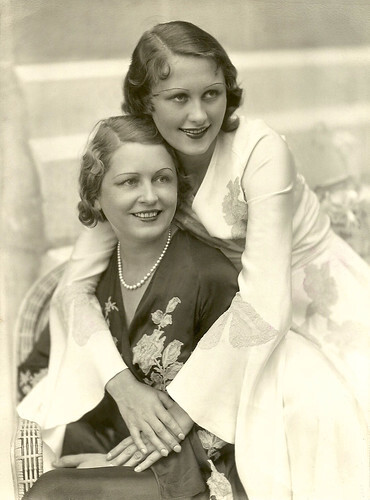
Tamara and Xenia Desni. Photo. Collection: Didier Hanson. Given to Didier by Madeleine, Tamara's daughter.
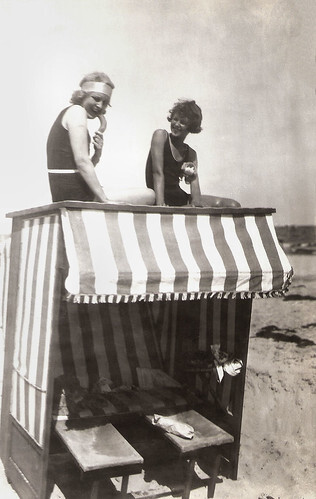
Tamara Desni, Xenia Desni. Vintage photo. From Tatiana.
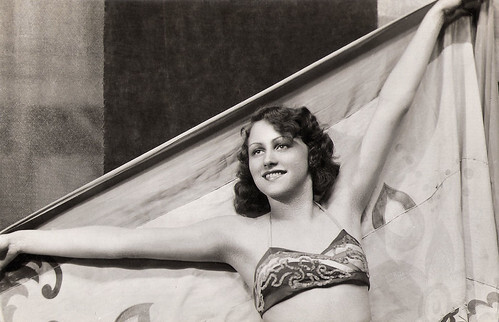
Vintage photo, ca. 1930. A gift from Tatiana.
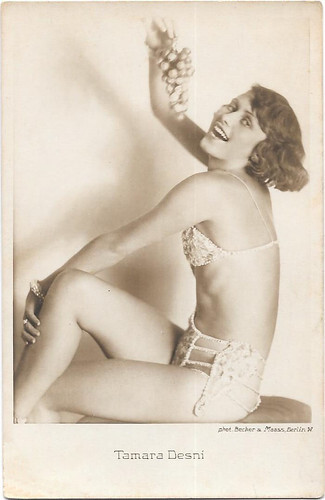
German postcard. Photo: Becker & Maass, Berlin. Collection: Didier Hanson.
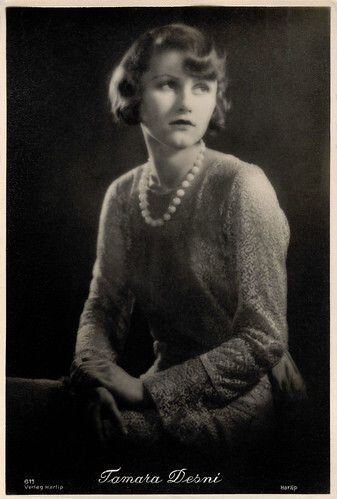
German postcard by Verlag Harlip, no. 611. Photo: Harlip.
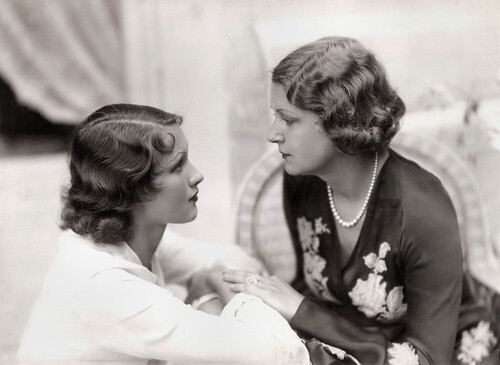
Vintage photo. From Tatiana.
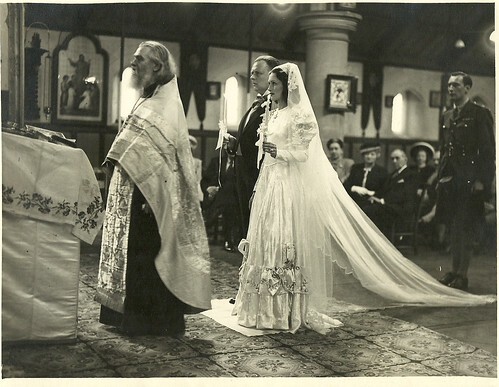
Photo. Collection: Didier Hanson. Tamara Desni and Raymond Lovell's wedding in 1946. Given to Didier by her daughter.
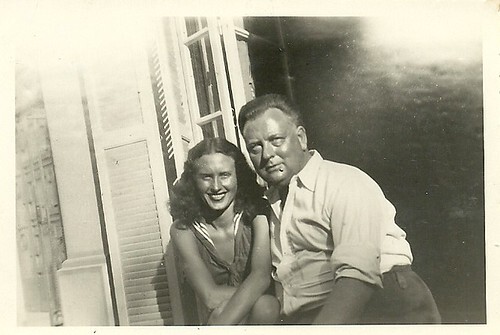
Vintage photo of Tamara Desni and Raymond Lovell. Collection: Didier Hanson. Given to Didier by Tamara's daughter.
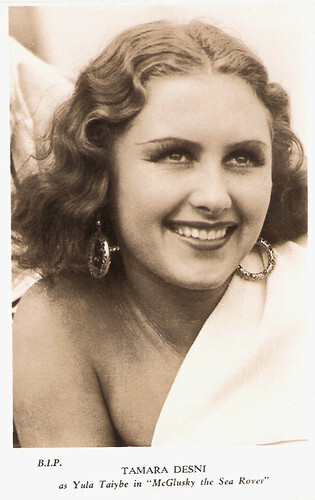
British card. Photo: B.I.P. Publicity still for McGlusky the Sea Rover (Walter Summers, 1935).
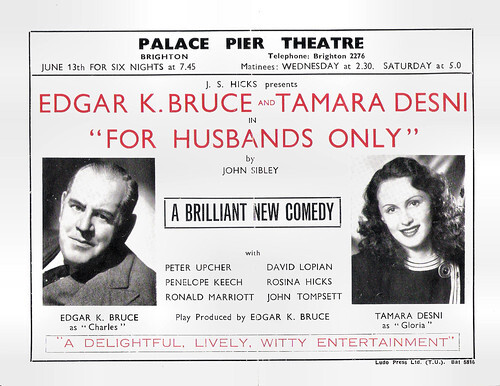
British flyer by Ludo Press Ltd. for Palace Pier Theatre, Brighton, 1949. Photos: publicity stills for the play 'For Husbands Only' by John Sibley, starring Edgar K. Bruce and Tamara Desni. A gift from Tatiana.
Thank you, Tatiana and Didier, for sharing your postcards and photos with us!
Sources: Tom Vallance (The Independent), Mike Cummings (AllMovie), The Telegraph, AllMovie, Wikipedia and .

German postcard by Ross Verlag, Berlin, no. 6125/1, 1931-1932. Photo: Ufa. Collection: Didier Hanson.

German postcard by Ross Verlag, no. 5767/1, 1930-1931. Photo: Becker & Maas, Berlin.

German postcard by Ross Verlag, no. 6346/1, 1931-1932. Photo: Becker & Maas, Berlin.

British postcard for Coliseum Theatre, London. Photo: publicity still for the play 'Casanova'.

British postcard in the Picturegoer Series, London, no. 795. Photo: Gaumont.

British postcard in the Picturegoer Series, London, no. 795a. Photo: Sound Films.
Fire Over England
Tamara Desni was born Tamara Brodsky, in Berlin in 1910 (some sources say 1913). She was the daughter of Ukrainian-born film star Xenia Desni . She took her mother's surname as her stage name. Her father, James Brodsky, left his family to settle in the United States. Tamara studied ballet as a child and appeared on stage.
In 1929, while a teenager, she married Hans Wilhelm, a dentist, but they divorced a year later. She also played in German films like the comedy Der Schrecken der Garnison/Terror of the Garrison (Carl Boese, 1931) with Felix Bressart , and Im Geheimdienst/In the Employ of the Secret Service (Gustav Ucicky, 1931) starring Brigitte Helm .
That same year she came with her mother to London for a stage role in the operetta 'White Horse Inn' (1931). For this spectacular production, credited with saving the Coliseum, which was faltering as a music hall, the entire theatre was transformed into the Tyrol. The production was based on the German operetta 'Im weissen Roessl', which had been a great success in her then home town, Berlin, the year before. 'White Horse Inn' was a smash hit and ran for 500 performances at the Coliseum Theatre. She followed this up with another leading role at the Coliseum in a German import, the musical 'Casanova', featuring music by Johann Strauss, Jr. His music was adapted by Ralph Benatsky, who had done much the same kind of thing for 'White Horse Inn' with music from various Viennese composers, including Robert Stolz.
Desni's British film career took off with the comedy Falling for You (Robert Stevenson, Jack Hulbert, 1933), supporting the popular musical comedy team of Jack Hulbert and Cicely Courtneidge . Her next films were the thriller Forbidden Territory (Phil Rosen, 1934) starring Gregory Ratoff, another Jack Hulbert comedy Jack Ahoy (Walter Forde, 1935) and the musical romance Bypass to Happiness/The Diplomatic Lover (Anthony Kimmins, 1934) starring Harold French. She played the lead in Dark World (Bernard Vorhaus, 1935), but the film, released by Fox Film Corporation, is now considered lost.
Desni played a supporting part in the historical drama Fire Over England (William K. Howard, 1937), notable for providing the first pairing of Laurence Olivier and Vivien Leigh . Leigh's performance in the film helped to convince David O. Selznick to cast her as Scarlett O'Hara in his production of Gone with the Wind. Mike Cummings at AllMovie : "But what really sets the film apart is the outstanding performance of Flora Robson as a stout-hearted, quick-tongued Queen Elizabeth I. Robson delivers barbs at court as sharp as the crossed swords on the field of battle. In private, though, she exhibits a gentle side, even spoon-feeding broth to her ailing counsellor, Baron Burleigh, portrayed with grandfatherly benignity by Morton Selten. The plot moves swiftly, depicting battles, captures, narrow escapes, and wooing on the fly -- all enhanced by the stunning black-and-white cinematography of James Wong Howe. Richard Addinsell serves up a rousing music score, and two of early filmdom's exquisite beauties -- Tamara Desni (Elena) and Vivien Leigh (Cynthia) -- turn strait-laced Elizabethan gowns into fashion statements."

Vintage photo, ca. 1920. A gift from Tatiana.

German postcard. Photo: Otto Kurt Vogelsang Lichtbildner, Berlin. From Tatiana.

British photo by Vivienne / 20th Century Studios Ltd, London. From Tatiana.

German postcard by Ross Verlag, Berlin. Photo: Otto Kurt Vogelsang, Berlin. From Tatiana.

Vintage postcard. From Tatiana.

British postcard by Lewis Repro, Charing Cross. From Tatiana.
Lithe steps and high-kicks
Tamara Desni’s film career continued through 1950. She played the lover of a small-time crook in Edgar Wallace's mystery The Squeaker (William K. Howard, 1937), with Robert Newton, Edmund Lowe and Ann Todd . Tom Valance in his obituary in The Independent : "Playing a cabaret performer named Tamara in The Squeaker, she sang two songs, 'He's Gone' and 'I Don't Get Along Without You', in a light, sub-Dietrich voice, and performed some lithe steps and high-kicks wearing a see-through evening gown."
In the wartime thriller Traitor Spy (Walter Summers, 1939) she co-starred with Bruce Cabot. Other film credits include the musical comedy Flight from Folly (Herbert Mason, 1945), the crime film Send for Paul Temple (John Argyle, 1946) featuring Anthony Hulme, and her final film, Dick Barton Strikes Back (Godfrey Grayson, 1950) about special agent Dick Barton (Don Stannard).
Tom Vallance: "The radio show Dick Barton – Special Agent (1946) had built an audience of 15 million within a year and was the third most popular radio show of its time after Radio Forfeits and Woman's Hour, but the investigator's screen adventures were lamentably low-budget, poorly written and weakly acted. Desni was second-billed to its star Don Stannard in Dick Barton at Bay, but as Madame Anna, one of the leaders of a gang out to steal a death ray, she had little to do but accept compliments for her beauty and make observations about her cohorts (‘You're getting jumpy, Fingers’)." Dick Barton Strikes Back was the second of three films Hammer Film Productions made about the British agent, although it was the last released. A fourth Barton film was scheduled, Dick Barton in Africa, but Don Stannard was killed in a car crash driving back from the wrap party and Hammer elected not to continue the series.
At the time, Tamara Desni was separating from her fourth husband. Her second husband had been actor Bruce Seton, whom she had met on the set of the forgettable film Blue Smoke (Ralph Ince, 1935) in 1934. They married in 1936 and divorced in 1940. Husband three was film producer Bill Gillet, who served in WWII as a naval flyer. The strains of that ended the marriage in 1945. Husband four was Canadian-born actor Raymond Lovell. They married in 1947, and separated in 1951. Her stepdaughter during this short marriage was the actress Simone Lovell.
After her divorce, Desni moved to the South of France, where she became romantically involved with Albert Lavagna, a builder. Given her track record, she did not wish to marry him initially, but when she became pregnant Albert insisted due to his strong religious faith. It was his first marriage and it would last for half a century. They built 'L'Auberge Chez Tamara', a restaurant and bar which became a popular attraction around Grasse in the Alpes Maritimes. The couple had two daughters. While in her late eighties, Tamara Desni’s health began declining. Aged 97 and a widow, she died in Valence d'Agen, France in 2008.

Tamara and Xenia Desni. Photo. Collection: Didier Hanson. Given to Didier by Madeleine, Tamara's daughter.

Tamara Desni, Xenia Desni. Vintage photo. From Tatiana.

Vintage photo, ca. 1930. A gift from Tatiana.

German postcard. Photo: Becker & Maass, Berlin. Collection: Didier Hanson.

German postcard by Verlag Harlip, no. 611. Photo: Harlip.

Vintage photo. From Tatiana.

Photo. Collection: Didier Hanson. Tamara Desni and Raymond Lovell's wedding in 1946. Given to Didier by her daughter.

Vintage photo of Tamara Desni and Raymond Lovell. Collection: Didier Hanson. Given to Didier by Tamara's daughter.

British card. Photo: B.I.P. Publicity still for McGlusky the Sea Rover (Walter Summers, 1935).

British flyer by Ludo Press Ltd. for Palace Pier Theatre, Brighton, 1949. Photos: publicity stills for the play 'For Husbands Only' by John Sibley, starring Edgar K. Bruce and Tamara Desni. A gift from Tatiana.
Thank you, Tatiana and Didier, for sharing your postcards and photos with us!
Sources: Tom Vallance (The Independent), Mike Cummings (AllMovie), The Telegraph, AllMovie, Wikipedia and .
Published on February 21, 2024 22:00
February 20, 2024
Xenia Desni
Ukrainian actress Xenia Desni (1894-1962) was a star of the German silent cinema. She appeared in many films by Johannes Guter for Ufa. A highlight in her career was the silent Operetta Ein Walzertraum/A Waltz Dream (1925) by Ludwig Berger.
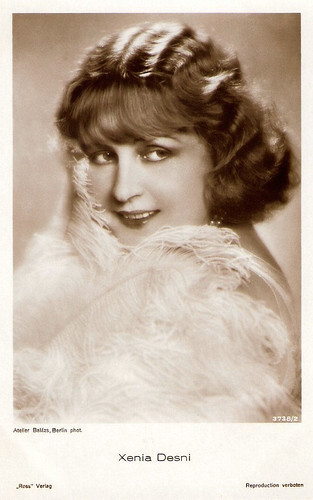
German postcard by Ross Verlag, no. 3738/2, 1928-1929. Photo: Atelier Balázs, Berlin.
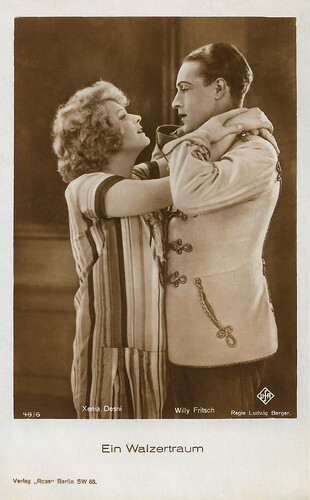
German postcard by Ross Verlag, no. 48/6. Photo: Ufa. Xenia Desni and Willy Fritsch in Ein Walzertraum/The Waltz Dream (Ludwig Berger, 1925), adapted from the Oscar Straus operetta.
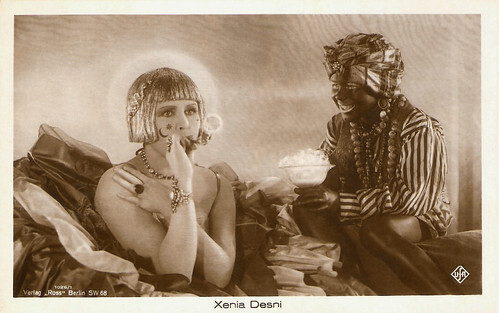
German postcard by Ross Verlag, Berlin, no. 1026/1, 1927-1928. Photo: Ufa. Xenia Desni in Die gefundene Braut/The Found Bride (Rochus Gliese, 1925).
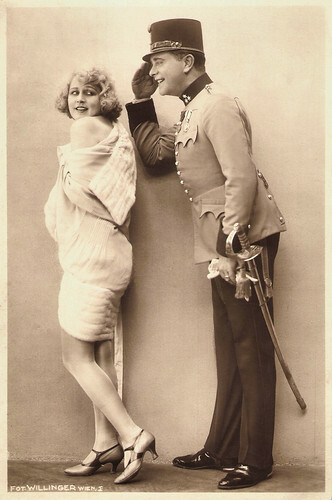
Austrian photo by Willinger, Wien. Xenia Desni and Livio Pavanelli in the German silent film Die letzte Einquartierung aka Küssen ist keine Sünd'/Kissing is no sin (Rudolf Walther-Fein, Rudolf Dworsky, 1926). A gift from their niece Tatiana .
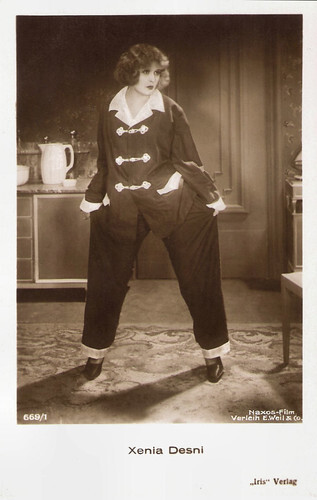
Austrian postcard by Iris Verlag, no. 669/1. Photo: Naxos-Film / Verleih E. Weil & Co. Xenia Desni in the comedy Nixchen (Curt Blachnitzky, 1926).
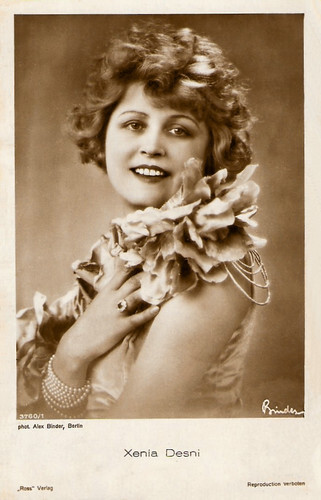
German postcard by Ross Verlag, no. 3760/1, 1928-1929. Photo: Alex Binder, Berlin.
A successful but short film career in Berlin
Xenia Desni (Ukrainian: Ксенія Десні) was born Ksenia Desnytska in 1894 in the town of Oster near Kyiv, then part of the Russian Empire and now Ukraine. Her artistic talent was evident from an early age, and her passion for dance in particular was supported and encouraged by her parents. In 1911 she gave birth to her daughter, the future stage and film actress of the 1930s and 1950s, Tamara Desni . During the turmoil of the First World War and the Russian Revolution, Desni and her family fled to Constantinople (now Istanbul) where she worked as a variety dancer.
She travelled to Berlin where she had a successful but short film career in the 1920s. Several sources claim that she made her film debut with Sappho (Dimitri Buchowetzki, 1921) starring Pola Negri , but there is no evidence of this. Desni's name first appeared in 1921 in the credits of Weib und Palette/The Call of Fate (1921), directed by Johannes Guter, who later cast her in many of his films.
Their next film was Die Schwarze Pantherin/The Black Panther (Johannes Guter, 1921) starring Yelena Polevitskaya and produced by Erich Pommer. The film was produced by Russo Film, a small production outfit associated with Decla-Bioscop, which had been set up to produce films based on literature. Die Schwarze Pantherin/The Black Panther was adapted from a play by Volodymyr Vynnychenko, a Ukrainian statesman, political activist, writer, playwright and artist who served as the first prime minister of the Ukrainian People's Republic. Xenia signed a contract with the Ufa.
With Guter she worked on such films as Bardame/Barmaid (1922) with Paul Hartmann , Der Ruf des Schicksals/The Call of Destiny (Johannes Guter, 1922) with Fritz Kortner and Ernst Hofmann , Die Prinzessin Suwarin/Princess Suwarin (Johannes Guter, 1923) starring Lil Dagover and based on the novel by Ludwig Wolff, which had previously appeared in the Berliner Illustrierte Zeitung. She played Hedwig Tell the wife of the title figure in Wilhelm Tell (Rudolf Dworsky, Rudolf Walther-Fein, 1923). The film portrays the story of the legendary Swiss national hero William Tell. Other successful productions were Die Andere/The Other Woman (Gerhard Lamprecht, 1924), Der Sprung ins Leben (Johannes Guter, 1924) and the German-British costume film Dekameron-Nächte/Decameron Nights (Herbert Wilcox, 1924) based on two stories from the 'Decameron' by Giovanni Boccaccio with Lionel Barrymore as Prince Saladin. It was followed by Der Turm des Schweigens/The Tower of Silence (Johannes Guter, 1925) based on the play 'The Tempest' by William Shakespeare . Many films by Johannes Guter are considered lost, but this film was restored by the Friedrich Wilhelm Murnau Foundation in 2006 and was screened at the Berlin International Film Festival in 2007.
Desni played the beautiful violinist/conductor Franzi Steingruber alongside Mady Christians (Princess Alix von Flausenthurn) and Willy Fritsch (Prince Consort Nikolaus Count Preyn) in Ein Walzertraum/A Waltz Dream (Ludwig Berger, 1925). Ein Walzertraum was based on the 1907 operetta 'Ein Walzertraum' composed by Oscar Straus. At first, Berger had not wanted to film Straus' operetta because an operetta as a silent film seemed an absurd idea to him. Stephanie D'heil at Steffi-Line : "But then he realised: 'Here is new territory! Silent film from the spirit of music. Melody in every face, rhythm in every movement and shot. This is the only way to artistically realise the banal story of a puritanically educated princess who learns from a violinist how to make her husband happy. With actors who first have to be "renovated". Berger becomes an obsessive, a tamer. He transforms the elegiac Russian Xenia Desny into a lively personality." Ein Walzertraum/A Waltz Dream became a worldwide success. Unlike many of Ufa's ambitious productions of the 1920s, Ein Walzertraum managed to recover its production cost in the domestic market alone and was influential in the development of later Viennese operetta films.
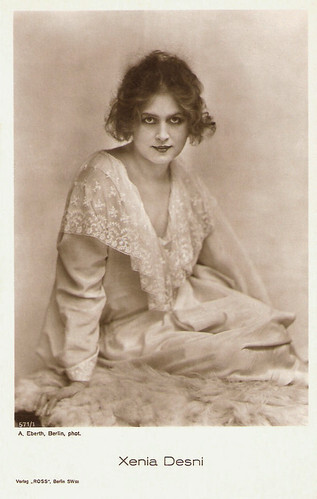
German postcard by Ross Verlag, no. 571/1, 1919-1924. Photo: A. Eberth, Berlin.
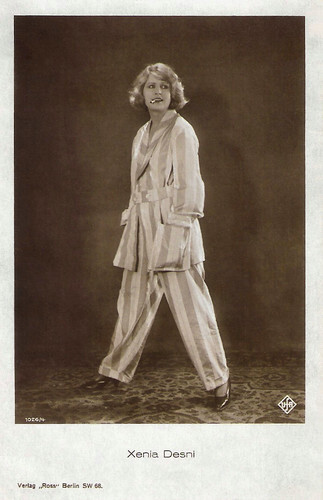
German postcard by Ross Verlag, no. 1026/4, 1927-1928. Photo: Ufa. Xenia Desni in Die gefundene Braut/The Found Bride (Rochus Gliese, 1925). From Tatiana .
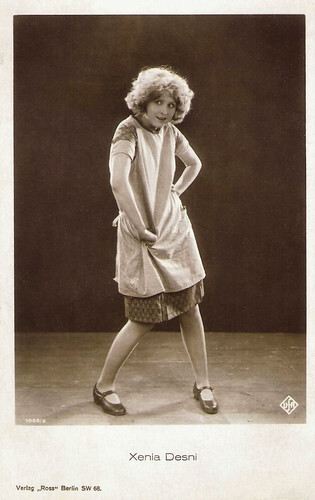
German postcard by Ross Verlag, no. 1028/2, 1927-1928. Photo: Ufa. From Tatiana .
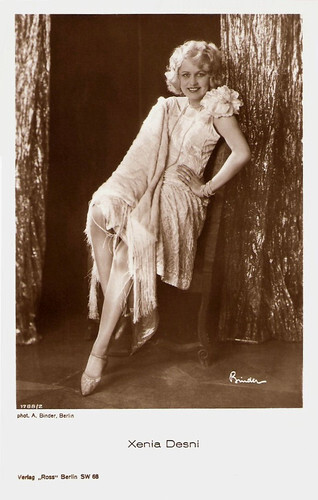
German postcard by Ross Verlag, no. 1788/2, 1927-1928. Photo: Alex Binder, Berlin.
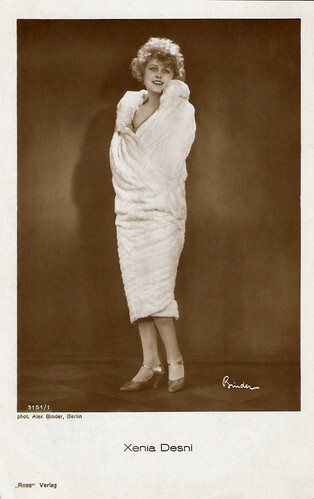
German postcard by Ross Verlag, no. 3151/1, 1928-1929. Photo: Alex Binder, Berlin.
Managing her daughter
Xenia Desni's film career flourished in the years 1926-1927. She made one film after another, including Der rosa Diamant/The Pink Diamond (Rochus Gliese, 1926) with Rudolf Klein-Rogge , the comedy Familie Schimeck/The Schimeck Family (Alfred Halm, Rudolf Dworsky, 1926) with Livio Pavanelli and Max Hansen , and Madame wagt einen Seitensprung (Hans Otto, 1927). With Harry Liedtke and Hans Albers, she co-starred in the cheerful Nixchen (1926) based on the novel by Helene Keßler alias Hans von Kahlenberg. She reunited with Willy Fritsch for Die Boxerbraut/The Boxer's Bride (Johannes Guter, 1926).
In France, she appeared with Louise Lagrange and Ricardo Cortez in the silent drama La danseuse Orchidée/The Orchid Dancer (Léonce Perret, 1928). It was shot at the Victorine Studios in Nice. Her last silent film was the Austrian historical drama Erzherzog Johann/Archduke John (Max Neufeld, 1929) starring Igo Sym as Archduke John of Austria, a nineteenth-century member of the Habsburg Dynasty. After the advent of sound film, Xenia Desni's screen career came to an end, probably due to a lack of voice technique.
Between 1924 and 1926, Xenia Desni had a summer residence built in Bansin, which she lived in with her daughter for several years until the house became the property of the industrial magnate Gerdes. According to IMDb and English Wikipedia , she appeared in one more film, the German crime film Kriminalkommissar Eyck (Milo Harbich, 1940) starring Anneliese Uhlig and Paul Klinger .
Her daughter Tamara Desni (1911-2008) acted in a half dozen German sound films. In 1931, Xenia and Tamara settled in London. There Tamara worked for decades as an actress in the British film industry. She was married to Canadian actor Raymond Lovell (1900-1953).
In 1950, Tamara moved with Lovell to France. In 1956, she and her fifth husband, Albert Lavagna, opened a successful hotel and restaurant, L'Auberge Chez Tamara, on the Cote d'Azur in Grasse. Xenia eventually moved in with them. Xenia Desni died in 1962 in Roquefort-les-Pins on the Côte d'Azur. She was 68.
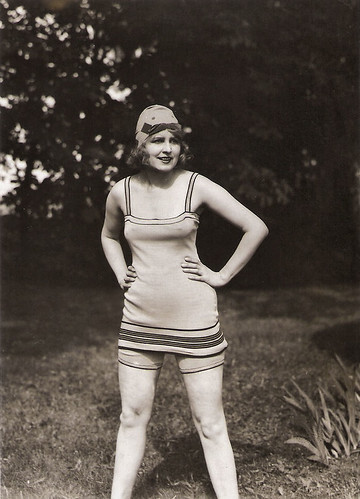
German photo by Ufa.

Vintage photo. Xenia Desni and her daughter Tamara having fun at the beach, in the early 1920s. From Tatiana .
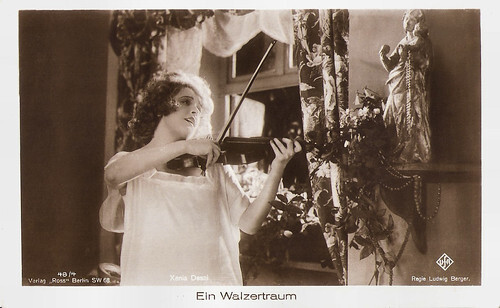
German postcard by Ross Verlag, no. 48/4. Photo: Ufa. Xenia Desni in Ein Walzertraum/The Waltz Dream (Ludwig Berger, 1925), based on the Oscar Straus operetta.
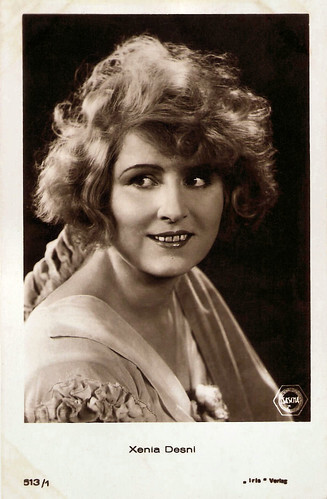
Austrian postcard by Iris Verlag, no. 513/1. Photo: Sascha.
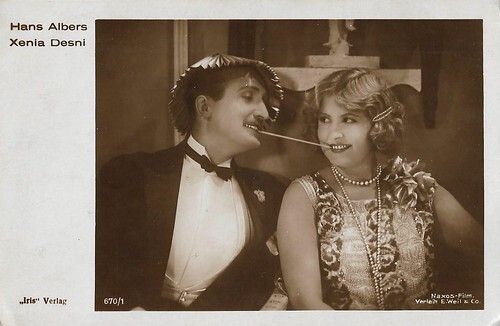
Austrian postcard by Iris Verlag, no. 670/1. Photo: Naxos-Film / Austrian distr. E. Weil. Hans Albers and Xenia Desni in Nixchen (Kurt Blachnitzky, 1926).

Austrian postcard by Iris Verlag, no. 669/2. Photo: Naxos-Film / distr. E. Weil & Co. Probably also a postcard for the German silent film comedy Nixchen (Curt Blachnitzky, 1926), as this was Naxos' only production with Desni.
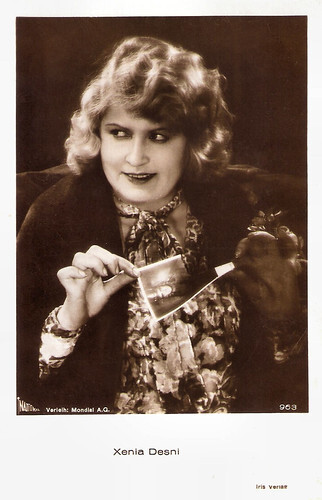
Austrian postcard by Iris Verlag, no. 963. Photo: National Film. / Distr. Mondial A.G. Probably a card for the National Film production Die Bräutigame der Babette Bomberling/The Grooms of Babette Bomberling (Viktor Janson, 1927).
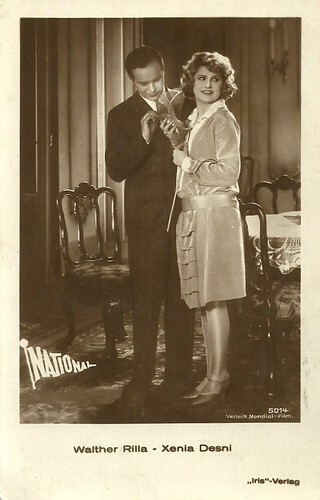
Austrian postcard by Iris Verlag, no. 5014. Photo: National Film / Verleih Mondial-Film. Xenia Desni in the National Film production Die Bräutigame der Babette Bomberling/The Grooms of Babette Bomberling (Vikor Janson, 1927). N.B. Walter Rilla does not act in this film so the actor is probably Egon von Jordan .
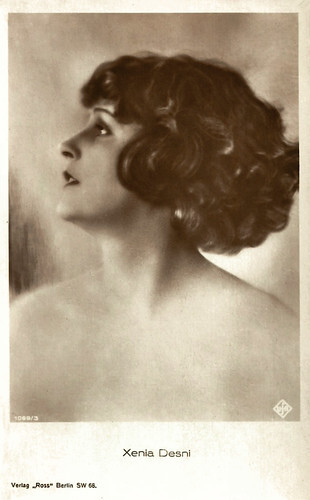
German postcard by Ross Verlag, Berlin, no. 1069/3, 1927-1928. Photo: Ufa.
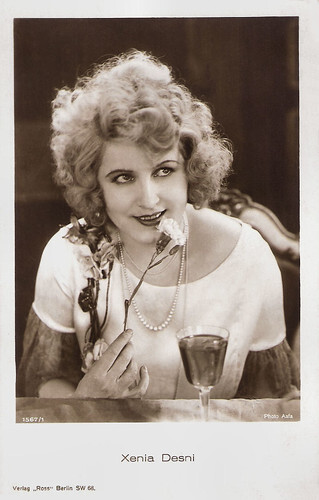
German postcard by Ross Verlag. Berlin, no. 1567/1, 1927-1928. Photo: Aafa.
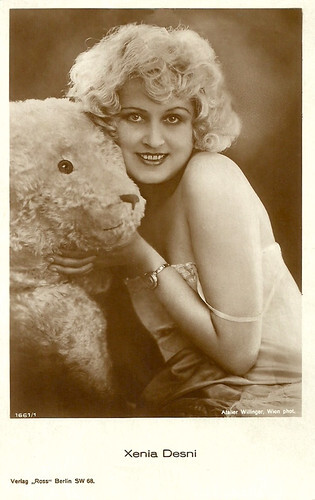
German postcard by Ross Verlag, Berlin, no. 1661/1, 1927-1928. Photo: Atelier Willinger, Wien.
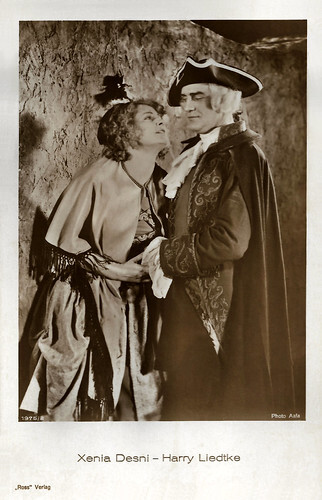
German postcard by Ross Verlag, no. 1975/2, 1927-1928. Photo: Aafa. Xenia Desni and Harry Liedtke in Ein Mädel aus dem Volke/A girl from the people (Jacob Fleck, Luise Fleck, 1927).
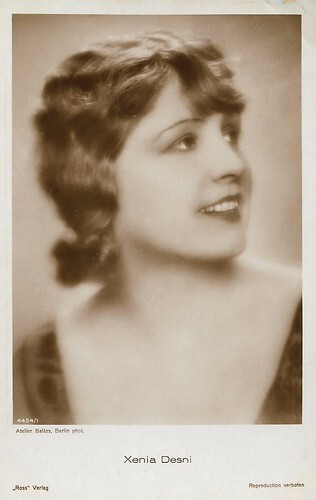
German postcard by Ross Verlag, no. 4454/1, 1929-1930. Photo: Atelier Balázs, Berlin.

Vintage photo of Tamara and Xenia Desni. From Tatiana .
Source: Stephanie D'heil (Steffi-Line - German), Thomas Staedeli (Cyranos), Find A Grave, Wikipedia (English, Ukranian and ) and .

German postcard by Ross Verlag, no. 3738/2, 1928-1929. Photo: Atelier Balázs, Berlin.

German postcard by Ross Verlag, no. 48/6. Photo: Ufa. Xenia Desni and Willy Fritsch in Ein Walzertraum/The Waltz Dream (Ludwig Berger, 1925), adapted from the Oscar Straus operetta.

German postcard by Ross Verlag, Berlin, no. 1026/1, 1927-1928. Photo: Ufa. Xenia Desni in Die gefundene Braut/The Found Bride (Rochus Gliese, 1925).

Austrian photo by Willinger, Wien. Xenia Desni and Livio Pavanelli in the German silent film Die letzte Einquartierung aka Küssen ist keine Sünd'/Kissing is no sin (Rudolf Walther-Fein, Rudolf Dworsky, 1926). A gift from their niece Tatiana .

Austrian postcard by Iris Verlag, no. 669/1. Photo: Naxos-Film / Verleih E. Weil & Co. Xenia Desni in the comedy Nixchen (Curt Blachnitzky, 1926).

German postcard by Ross Verlag, no. 3760/1, 1928-1929. Photo: Alex Binder, Berlin.
A successful but short film career in Berlin
Xenia Desni (Ukrainian: Ксенія Десні) was born Ksenia Desnytska in 1894 in the town of Oster near Kyiv, then part of the Russian Empire and now Ukraine. Her artistic talent was evident from an early age, and her passion for dance in particular was supported and encouraged by her parents. In 1911 she gave birth to her daughter, the future stage and film actress of the 1930s and 1950s, Tamara Desni . During the turmoil of the First World War and the Russian Revolution, Desni and her family fled to Constantinople (now Istanbul) where she worked as a variety dancer.
She travelled to Berlin where she had a successful but short film career in the 1920s. Several sources claim that she made her film debut with Sappho (Dimitri Buchowetzki, 1921) starring Pola Negri , but there is no evidence of this. Desni's name first appeared in 1921 in the credits of Weib und Palette/The Call of Fate (1921), directed by Johannes Guter, who later cast her in many of his films.
Their next film was Die Schwarze Pantherin/The Black Panther (Johannes Guter, 1921) starring Yelena Polevitskaya and produced by Erich Pommer. The film was produced by Russo Film, a small production outfit associated with Decla-Bioscop, which had been set up to produce films based on literature. Die Schwarze Pantherin/The Black Panther was adapted from a play by Volodymyr Vynnychenko, a Ukrainian statesman, political activist, writer, playwright and artist who served as the first prime minister of the Ukrainian People's Republic. Xenia signed a contract with the Ufa.
With Guter she worked on such films as Bardame/Barmaid (1922) with Paul Hartmann , Der Ruf des Schicksals/The Call of Destiny (Johannes Guter, 1922) with Fritz Kortner and Ernst Hofmann , Die Prinzessin Suwarin/Princess Suwarin (Johannes Guter, 1923) starring Lil Dagover and based on the novel by Ludwig Wolff, which had previously appeared in the Berliner Illustrierte Zeitung. She played Hedwig Tell the wife of the title figure in Wilhelm Tell (Rudolf Dworsky, Rudolf Walther-Fein, 1923). The film portrays the story of the legendary Swiss national hero William Tell. Other successful productions were Die Andere/The Other Woman (Gerhard Lamprecht, 1924), Der Sprung ins Leben (Johannes Guter, 1924) and the German-British costume film Dekameron-Nächte/Decameron Nights (Herbert Wilcox, 1924) based on two stories from the 'Decameron' by Giovanni Boccaccio with Lionel Barrymore as Prince Saladin. It was followed by Der Turm des Schweigens/The Tower of Silence (Johannes Guter, 1925) based on the play 'The Tempest' by William Shakespeare . Many films by Johannes Guter are considered lost, but this film was restored by the Friedrich Wilhelm Murnau Foundation in 2006 and was screened at the Berlin International Film Festival in 2007.
Desni played the beautiful violinist/conductor Franzi Steingruber alongside Mady Christians (Princess Alix von Flausenthurn) and Willy Fritsch (Prince Consort Nikolaus Count Preyn) in Ein Walzertraum/A Waltz Dream (Ludwig Berger, 1925). Ein Walzertraum was based on the 1907 operetta 'Ein Walzertraum' composed by Oscar Straus. At first, Berger had not wanted to film Straus' operetta because an operetta as a silent film seemed an absurd idea to him. Stephanie D'heil at Steffi-Line : "But then he realised: 'Here is new territory! Silent film from the spirit of music. Melody in every face, rhythm in every movement and shot. This is the only way to artistically realise the banal story of a puritanically educated princess who learns from a violinist how to make her husband happy. With actors who first have to be "renovated". Berger becomes an obsessive, a tamer. He transforms the elegiac Russian Xenia Desny into a lively personality." Ein Walzertraum/A Waltz Dream became a worldwide success. Unlike many of Ufa's ambitious productions of the 1920s, Ein Walzertraum managed to recover its production cost in the domestic market alone and was influential in the development of later Viennese operetta films.

German postcard by Ross Verlag, no. 571/1, 1919-1924. Photo: A. Eberth, Berlin.

German postcard by Ross Verlag, no. 1026/4, 1927-1928. Photo: Ufa. Xenia Desni in Die gefundene Braut/The Found Bride (Rochus Gliese, 1925). From Tatiana .

German postcard by Ross Verlag, no. 1028/2, 1927-1928. Photo: Ufa. From Tatiana .

German postcard by Ross Verlag, no. 1788/2, 1927-1928. Photo: Alex Binder, Berlin.

German postcard by Ross Verlag, no. 3151/1, 1928-1929. Photo: Alex Binder, Berlin.
Managing her daughter
Xenia Desni's film career flourished in the years 1926-1927. She made one film after another, including Der rosa Diamant/The Pink Diamond (Rochus Gliese, 1926) with Rudolf Klein-Rogge , the comedy Familie Schimeck/The Schimeck Family (Alfred Halm, Rudolf Dworsky, 1926) with Livio Pavanelli and Max Hansen , and Madame wagt einen Seitensprung (Hans Otto, 1927). With Harry Liedtke and Hans Albers, she co-starred in the cheerful Nixchen (1926) based on the novel by Helene Keßler alias Hans von Kahlenberg. She reunited with Willy Fritsch for Die Boxerbraut/The Boxer's Bride (Johannes Guter, 1926).
In France, she appeared with Louise Lagrange and Ricardo Cortez in the silent drama La danseuse Orchidée/The Orchid Dancer (Léonce Perret, 1928). It was shot at the Victorine Studios in Nice. Her last silent film was the Austrian historical drama Erzherzog Johann/Archduke John (Max Neufeld, 1929) starring Igo Sym as Archduke John of Austria, a nineteenth-century member of the Habsburg Dynasty. After the advent of sound film, Xenia Desni's screen career came to an end, probably due to a lack of voice technique.
Between 1924 and 1926, Xenia Desni had a summer residence built in Bansin, which she lived in with her daughter for several years until the house became the property of the industrial magnate Gerdes. According to IMDb and English Wikipedia , she appeared in one more film, the German crime film Kriminalkommissar Eyck (Milo Harbich, 1940) starring Anneliese Uhlig and Paul Klinger .
Her daughter Tamara Desni (1911-2008) acted in a half dozen German sound films. In 1931, Xenia and Tamara settled in London. There Tamara worked for decades as an actress in the British film industry. She was married to Canadian actor Raymond Lovell (1900-1953).
In 1950, Tamara moved with Lovell to France. In 1956, she and her fifth husband, Albert Lavagna, opened a successful hotel and restaurant, L'Auberge Chez Tamara, on the Cote d'Azur in Grasse. Xenia eventually moved in with them. Xenia Desni died in 1962 in Roquefort-les-Pins on the Côte d'Azur. She was 68.

German photo by Ufa.

Vintage photo. Xenia Desni and her daughter Tamara having fun at the beach, in the early 1920s. From Tatiana .

German postcard by Ross Verlag, no. 48/4. Photo: Ufa. Xenia Desni in Ein Walzertraum/The Waltz Dream (Ludwig Berger, 1925), based on the Oscar Straus operetta.

Austrian postcard by Iris Verlag, no. 513/1. Photo: Sascha.

Austrian postcard by Iris Verlag, no. 670/1. Photo: Naxos-Film / Austrian distr. E. Weil. Hans Albers and Xenia Desni in Nixchen (Kurt Blachnitzky, 1926).

Austrian postcard by Iris Verlag, no. 669/2. Photo: Naxos-Film / distr. E. Weil & Co. Probably also a postcard for the German silent film comedy Nixchen (Curt Blachnitzky, 1926), as this was Naxos' only production with Desni.

Austrian postcard by Iris Verlag, no. 963. Photo: National Film. / Distr. Mondial A.G. Probably a card for the National Film production Die Bräutigame der Babette Bomberling/The Grooms of Babette Bomberling (Viktor Janson, 1927).

Austrian postcard by Iris Verlag, no. 5014. Photo: National Film / Verleih Mondial-Film. Xenia Desni in the National Film production Die Bräutigame der Babette Bomberling/The Grooms of Babette Bomberling (Vikor Janson, 1927). N.B. Walter Rilla does not act in this film so the actor is probably Egon von Jordan .

German postcard by Ross Verlag, Berlin, no. 1069/3, 1927-1928. Photo: Ufa.

German postcard by Ross Verlag. Berlin, no. 1567/1, 1927-1928. Photo: Aafa.

German postcard by Ross Verlag, Berlin, no. 1661/1, 1927-1928. Photo: Atelier Willinger, Wien.

German postcard by Ross Verlag, no. 1975/2, 1927-1928. Photo: Aafa. Xenia Desni and Harry Liedtke in Ein Mädel aus dem Volke/A girl from the people (Jacob Fleck, Luise Fleck, 1927).

German postcard by Ross Verlag, no. 4454/1, 1929-1930. Photo: Atelier Balázs, Berlin.

Vintage photo of Tamara and Xenia Desni. From Tatiana .
Source: Stephanie D'heil (Steffi-Line - German), Thomas Staedeli (Cyranos), Find A Grave, Wikipedia (English, Ukranian and ) and .
Published on February 20, 2024 22:00
February 19, 2024
Terra-Color
Film stars and pin-pups were popular subjects of the Terra-Color postcards. These cards were published in West Germany during the 1950s and 1960s. Many of the photos were hand-coloured, a style that was already quite old-fashioned after World War II. Sometimes the result is beautiful, but more often it gives the Terra-Color cards a trashy look.
The film stars
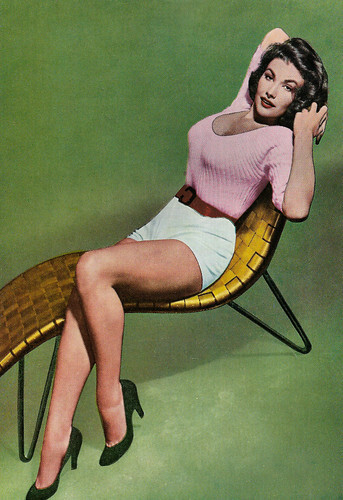
German postcard by Terra-Color, no. PU 8. Photo: Warner Bros. Pictures, Inc.
American actress Mara Corday (1930) was also a popular showgirl, model and Playboy Playmate of the 1950s.
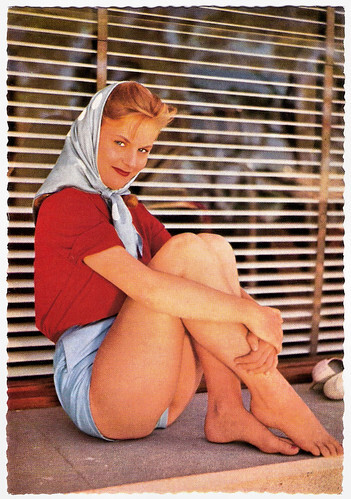
West German postcard by Terra-Color, no. F 123.
Blonde, blue-eyed schlager singer and film star Heidi Brühl (1942-1991) was called 'the Doris Day of Germany'. In 1963 she was a German participant in the Eurovision Song Contest.
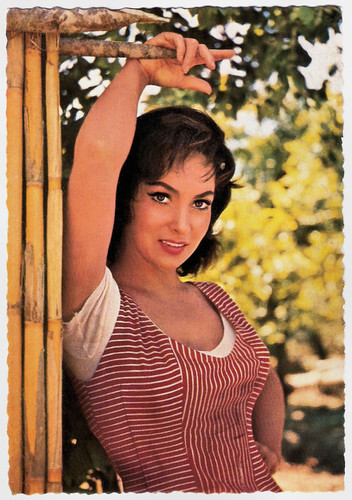
West German postcard by Terra-Color, no. F 130. Photo: Morris, Rome.
Gorgeous Italian actress and photojournalist Gina Lollobrigida (1927-2023) was one of the first European sex symbols of the post-war years. ‘La Lollo’ paved the way into Hollywood for her younger colleagues Sophia Loren and Claudia Cardinale.
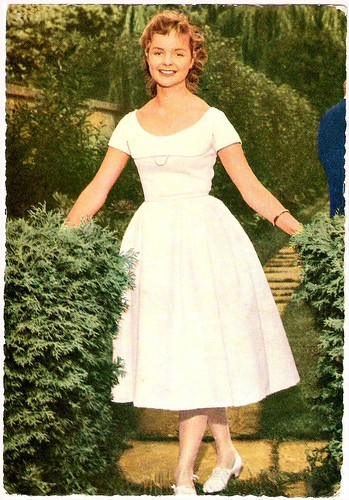
West German postcard by Terra-Color, no. F 150. Photo: private.
German Stage and film actress Sabine Sinjen (1942-1995) was a teenage star of the 1950s, who became a protagonist of the Neue Deutsche Film in the 1960s.
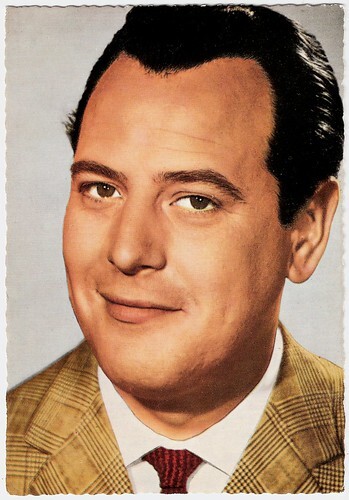
German postcard by Terra-Color, no. F 170. Photo: Electrola / Melodie / Gloria / Sascha / Appelt.
German singer and actor Fred Bertelmann 's biggest hit was the song 'Der lachende Vagabund', which he also sang in the Schlager film Der lachende Vagabund/The Laughing Rover (Thomas Engel, 1958).
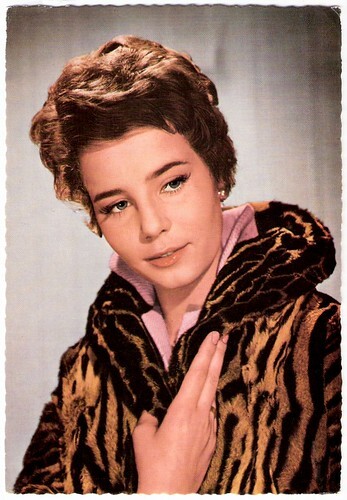
West German postcard by Terra-Color, no. F 173. Photo: Omega.
Delicate German stage and film actress Corny Collins (1933) was a popular teenage star in entertainment films of the late 1950s.
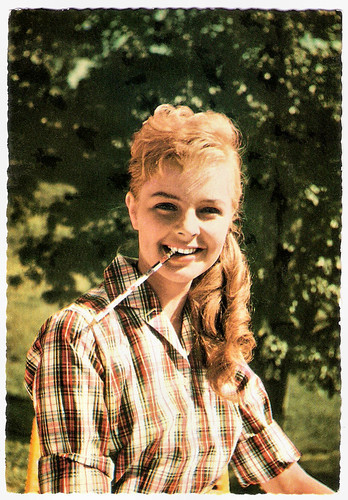
German postcard by Terra-Color, no. F 183.
German Stage and film actress Sabine Sinjen (1942-1995) was a teenage star of the 1950s, who became a protagonist of the Neue Deutsche Film in the 1960s.
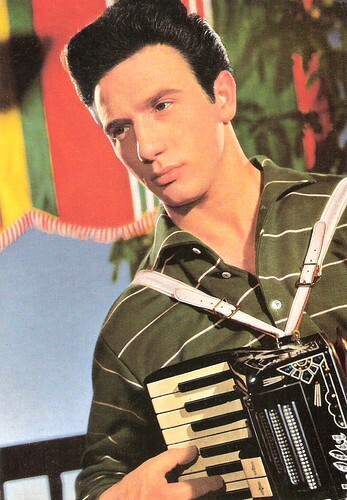
West German postcard by Terra-Color, no. F 188.
Rocco Granata (1938) is a Belgian-Italian singer and an occasional actor. He was born in Italy and his parents emigrated to Belgium when he was 10. His father was a coal miner, but Rocco pursued music instead.
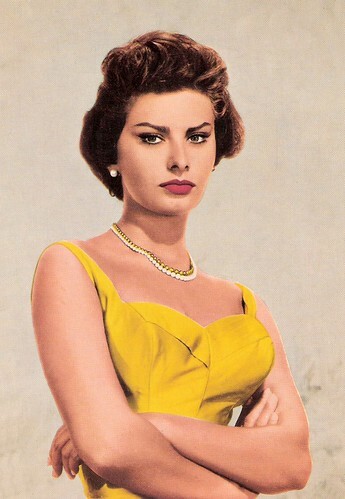
West German postcard by Terra-Color, no. F 190. Sent by mail in 1962.
Academy Award-winning film actress Sophia Loren (1934) rose to fame in post-war Italy as a voluptuous sex goddess. She became one of the most successful international stars of the 20th Century and is still a major sex symbol.
The pin-ups
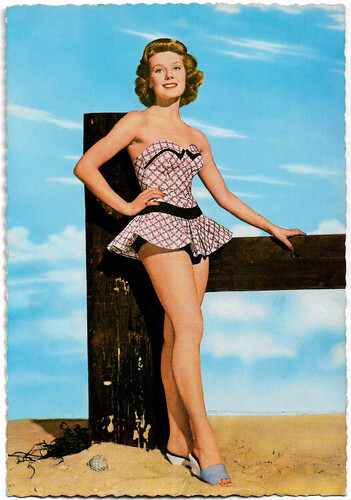
West German postcard by Terra-Color, no. PU 1.
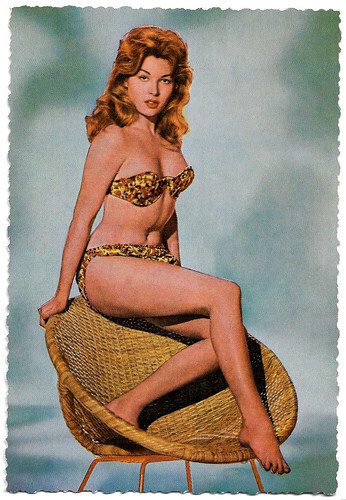
West German postcard by Terra-Color, no. PU 2.
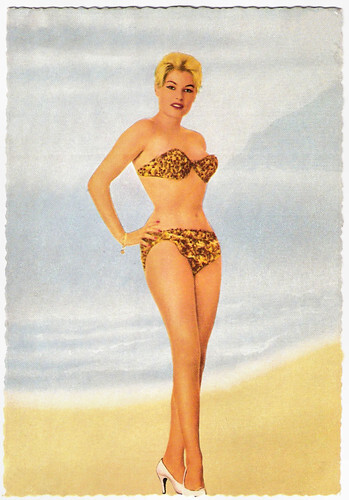
West German postcard by Terra-Color, no. PU 11.
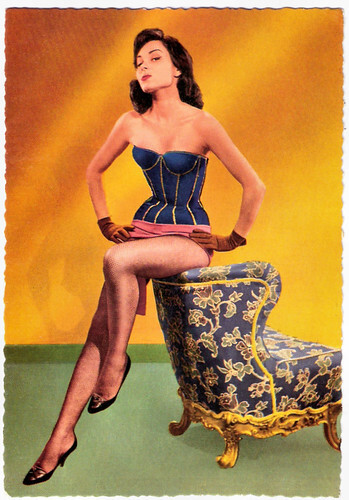
West German postcard by Terra-Color, no. PU 14.
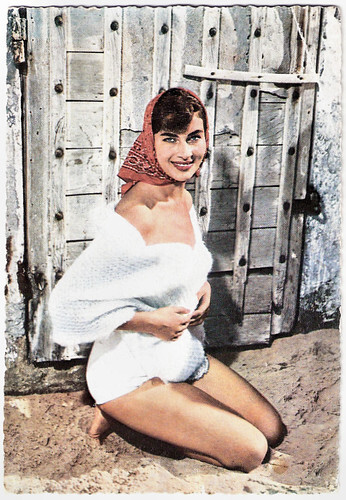
West German postcard by Terra-Color, no. PU 19.
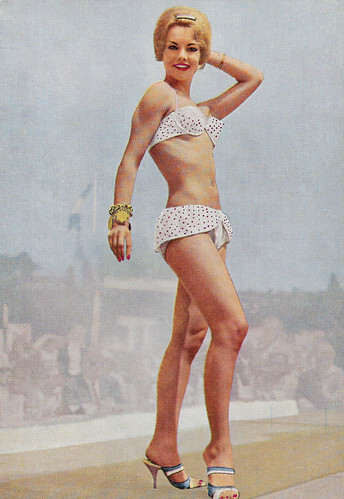
West German postcard by Terra-Color, no. PU 30.
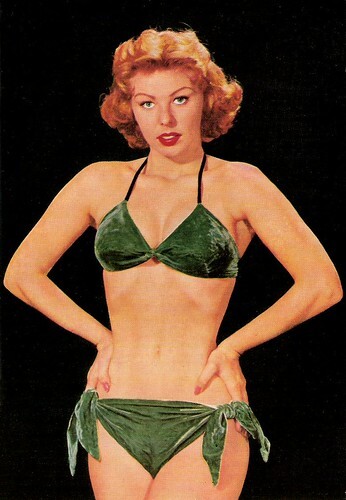
West German postcard by Terra-Color, no. PU 31.
The film stars

German postcard by Terra-Color, no. PU 8. Photo: Warner Bros. Pictures, Inc.
American actress Mara Corday (1930) was also a popular showgirl, model and Playboy Playmate of the 1950s.

West German postcard by Terra-Color, no. F 123.
Blonde, blue-eyed schlager singer and film star Heidi Brühl (1942-1991) was called 'the Doris Day of Germany'. In 1963 she was a German participant in the Eurovision Song Contest.

West German postcard by Terra-Color, no. F 130. Photo: Morris, Rome.
Gorgeous Italian actress and photojournalist Gina Lollobrigida (1927-2023) was one of the first European sex symbols of the post-war years. ‘La Lollo’ paved the way into Hollywood for her younger colleagues Sophia Loren and Claudia Cardinale.

West German postcard by Terra-Color, no. F 150. Photo: private.
German Stage and film actress Sabine Sinjen (1942-1995) was a teenage star of the 1950s, who became a protagonist of the Neue Deutsche Film in the 1960s.

German postcard by Terra-Color, no. F 170. Photo: Electrola / Melodie / Gloria / Sascha / Appelt.
German singer and actor Fred Bertelmann 's biggest hit was the song 'Der lachende Vagabund', which he also sang in the Schlager film Der lachende Vagabund/The Laughing Rover (Thomas Engel, 1958).

West German postcard by Terra-Color, no. F 173. Photo: Omega.
Delicate German stage and film actress Corny Collins (1933) was a popular teenage star in entertainment films of the late 1950s.

German postcard by Terra-Color, no. F 183.
German Stage and film actress Sabine Sinjen (1942-1995) was a teenage star of the 1950s, who became a protagonist of the Neue Deutsche Film in the 1960s.

West German postcard by Terra-Color, no. F 188.
Rocco Granata (1938) is a Belgian-Italian singer and an occasional actor. He was born in Italy and his parents emigrated to Belgium when he was 10. His father was a coal miner, but Rocco pursued music instead.

West German postcard by Terra-Color, no. F 190. Sent by mail in 1962.
Academy Award-winning film actress Sophia Loren (1934) rose to fame in post-war Italy as a voluptuous sex goddess. She became one of the most successful international stars of the 20th Century and is still a major sex symbol.
The pin-ups

West German postcard by Terra-Color, no. PU 1.

West German postcard by Terra-Color, no. PU 2.

West German postcard by Terra-Color, no. PU 11.

West German postcard by Terra-Color, no. PU 14.

West German postcard by Terra-Color, no. PU 19.

West German postcard by Terra-Color, no. PU 30.

West German postcard by Terra-Color, no. PU 31.
Published on February 19, 2024 22:00
February 18, 2024
Gérard Barray (1931-2024)
French film and television actor Gérard Barray (1931-2024) died on 15 February in Marbella, Andalucia. He was once called 'the most handsome man in the world' and became one of the swashbuckling heroes of French cinema. During the 1960s, he starred as D’Artagnan and Scaramouche but also starred in many Eurospy films. He then married his Spanish co-star, flamenco dancer Teresa Lorca, and settled in Andalusia. Barray was 92.

East-German postcard by Progress Film-Verleih, Berlin, no. 2915, 1967.
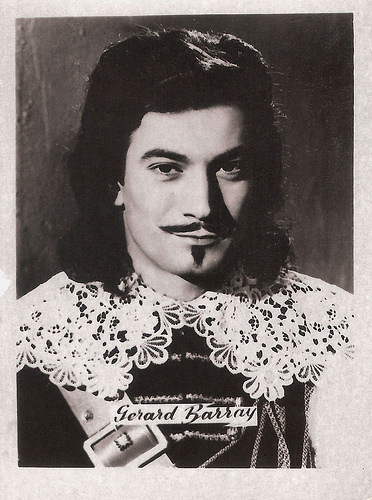
Small Romanian collectors card. Photo: publicity still for Les trois mousquetaires/The Three Musketeers (Bernard Borderie, 1961).
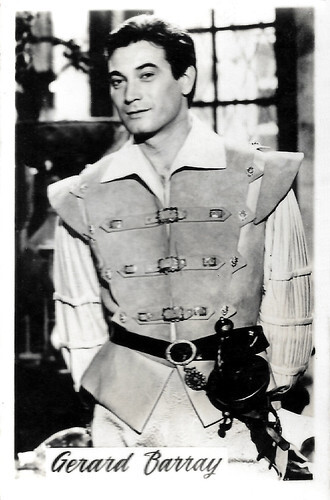
Romanian collector card. Gérard Barray in Le chevalier de Pardaillan/The Knight from Pardaillan (Bernard Borderie, 1962).
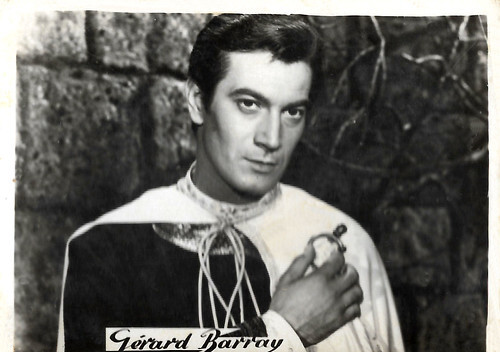
Romanian collector card. Gérard Barray in Le chevalier de Pardaillan/The Knight from Pardaillan (Bernard Borderie, 1962).
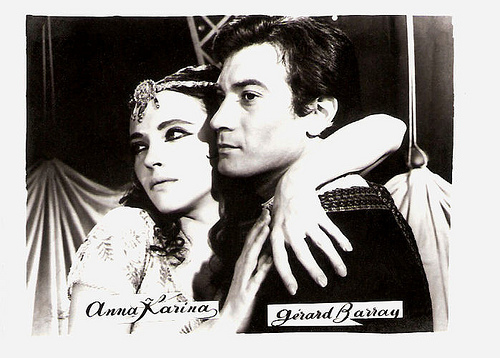
Small Romanian collectors card. Photo: publicity still for Sheherazade (Pierre-Gaspard-Huit, 1963) with Anna Karina .
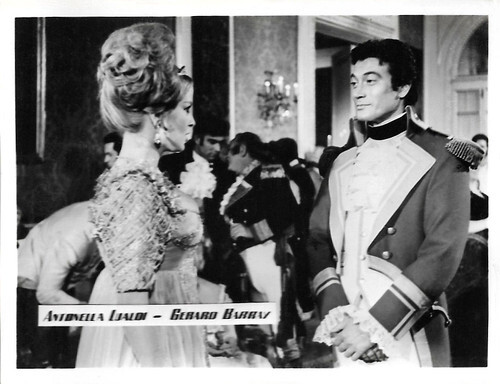
Small Romanian collectors card. Photo: Antonella Lualdi and Gerard Barray in Surcouf, l'eroe dei sette mari/The Fighting Corsair (Sergio Bergonzelli, Roy Rowland, 1966).
The Three Musketeers
Gérard Barray was born Gérard Marcel Louis Baraillé in Toulouse, France, in 1931. Barray's parents split up quickly and his mother, who came from Montauban decided to return to her hometown with her little boy. Around the age of 15, he discovered a passion for jazz. Barray participated in a few shows in nightclubs while pursuing his studies and obtained a bachelor's degree at the Faculty of Toulouse.
Camille Ricard, an actress and teacher at the Conservatory of Toulouse, advised him to go to Paris. She gave him a letter of recommendation for a friend, actor Noel Roquevert. Barray enrolled at the Cours Simon, a drama school in Paris and four years later, he won the Jury Prize. In 1955, he played his first small film roles as a gigolo in Chantage/Blackmail (Guy Lefranc, 1955) and as a gangster in the Film Noir Série noire/The Infiltrator (Pierre Foucaud, 1955) with Henri Vidal and Erich von Stroheim .
His first major film role was as the Duke of Vallombreuse in the historical adventure film Le Capitaine Fracasse/Captain Fracasse (Pierre Gaspard-Huit, 1961), starring Jean Marais and based on a novel by Théophile Gautier. The film and Barray’s supporting role were a success and next, he played the lead in another prestigious historical adventure, Les trois mousquetaires/The Three Musketeers (Bernard Borderie, 1961), a film adaption of the classic novel by Alexandre Dumas, père .
Reviewer jrjcat at IMDb: “This is a wonderful faithful version of Alexandre Dumas ' The Three Musketeers. Gerard Barray is excellent as D'Artagnan and Mylene Demongeot is not only one of the most beautiful screen Milady de Winters rivalling that of Lana Turner but also excellent in the part as well.” Les trois mousquetaires became the sixth-biggest French box office in 1961. A star was born.
During the 1960s Barray excelled in roles of knights with a big heart such as D'Artagnan, Scaramouche and Surcouf. These films include the Italian-French Alexandre Dumas adaptation I fratelli Corsi/The Corsican Brothers (Anton Giulio Majano, 1961) also starring Geoffrey Horne and Valérie Lagrange , Shéhérazade (Pierre Gaspard-Huit, 1963) starring Anna Karina , La máscara de Scaramouche/The Adventures of Scaramouche (Antonio Isasi-Isasmendi, 1963) and Le chevalier de Pardaillan/Clash of Steel (Bernard Borderie, 1962) plus its sequel Hardi Pardaillan!/The Gallant Musketeer (Bernard Borderie, 1964).
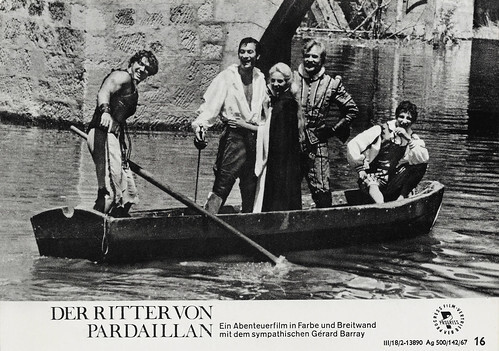
Big East-German card by VEB Progress Film-Vertrieb, Berlin, 1967, no. 16. Gérard Barray, Kirk Morris and Michèle Grellier in Le Chevalier de Pardaillan/The Knight from Pardaillan (Bernard Borderie, 1962).
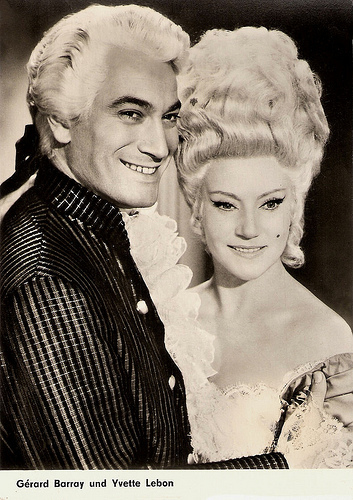
East-German postcard by Progress Film-Verleih, Berlin, no. 3034 1968. Photo: publicity still for La máscara de Scaramouche/The Adventures of Scaramouche (Antonio Isasi-Isasmendi, 1963) with Yvette Lebon .
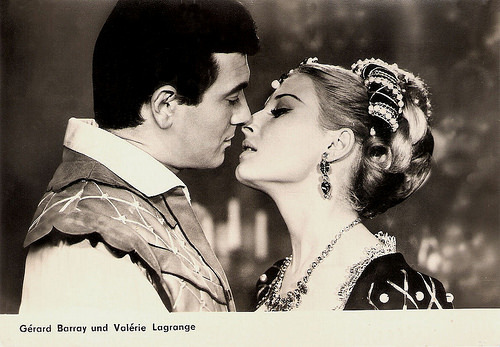
East-German postcard by Progress Film-Verleih, Berlin, no. 2961, 1967. Photo: publicity still for Hardi Pardaillan!/The Gallant Musketeer (Bernard Borderie, 1964) with Valérie Lagrange .
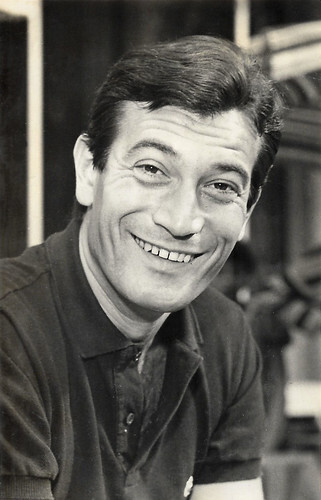
Czech collector card by Pressfoto, Praha (Prague), 1964, no. S 58/7.
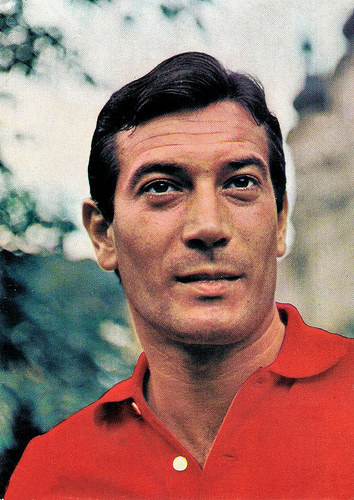
East-German postcard by Progress Film-Verleih, Berlin, no. 2260, 1965. Photo: Schwarz.
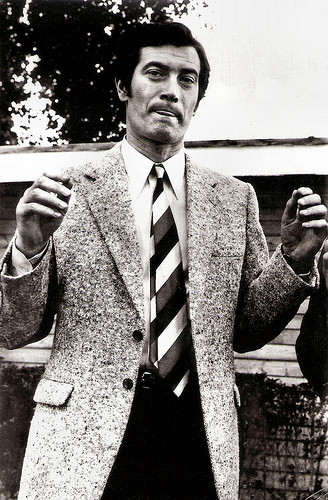
Romanian postcard by Casa Filmului Acin, no. 454. Photo: publicity still for Béru et ces dames/Beru and These Women (Guy Lefranc, 1968).
Next Time I'll Kill You
During the 1960s, Gérard Barray starred in a dozen feature films, most of which were box-office successes and widely known abroad. Besides Swashbucklers, he became one of the Eurospy stars with his roles in thrillers like Gibraltar (Pierre Gaspard-Huit, 1964) with Hildegard Knef and Baraka sur X 13/Agent X-77 Orders to Kill (Maurice Cloche, 1966) opposite Sylva Koscina .
He also starred as police commissioner San Antonio in the thrillers Sale temps pour les mouches/Next Time I'll Kill You (Guy Lefranc, 1966) and Béru et ces dames/Beru and These Women (Guy Lefranc, 1966), both with Jean Richard. He continued to play in popular Swashbucklers such as the French-Italian-Spanish adventure film Surcouf, le tigre des sept mers/The Sea Pirate (Sergio Bergonzelli, Roy Rowland, 1966) with Antonella Lualdi .
In 1969, he played a mysterious museum curator who seduces a young English teacher ( Claude Jade ) in Le Témoin/The Witness (Anne Walter, 1969). It was his last major role. Daniel Denner at IMDb: “he changed his profile to the dark side as Van Britten - his most interesting part but without great success.” Barray appeared in the supporting role of Richard, a rather temperamental star actor in Le cinéma de papa (Claude Berri, 1970), but mostly he worked for TV.
Decades later he made a comeback in the cinema opposite Eduardo Noriega and Penélope Cruz in Abre los ojos/Open Your Eyes (Alejandro Amenabar. 1997), the original version of Vanilla Sky (Cameron Crowe, 2001) with Tom Cruise . Barray appeared in more Spanish films and TV series and also played a small part in the thriller Sexy Beast (Jonathan Glazer, 2000).
In 2010, Gérard Barray was appointed an Officer in the Order of Arts and Letters. Barray died in 2024 in Marbella in the south of Spain at 92. Since 1965, he was married to his former co-star, flamenco dancer Theresa Lorca and they had two children and three grandchildren.
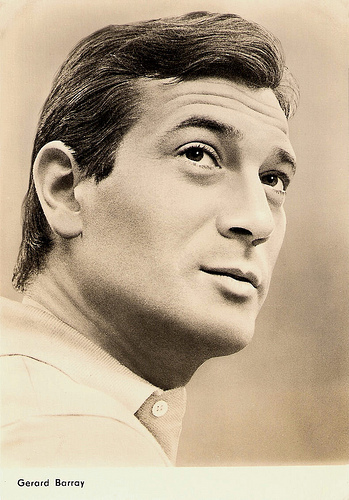
East-German postcard by Progress Film-Verleih, Berlin, no. 2216, 1965. Photo: Schwarz.
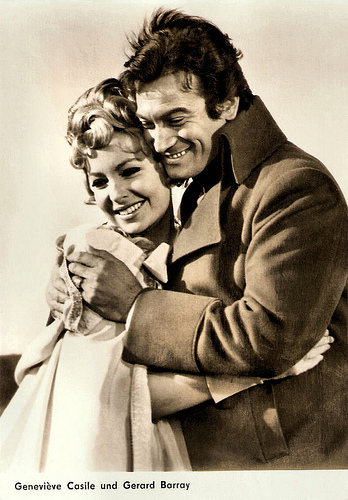
East-German postcard by Progress Film-Verleih, Berlin, no. 2828, 1967. Photo: publicity still for Surcouf, l'eroe dei sette mari/The Sea Pirate (Sergio Bergonzelli, Roy Rowland, 1966) with Geneviève Casile.
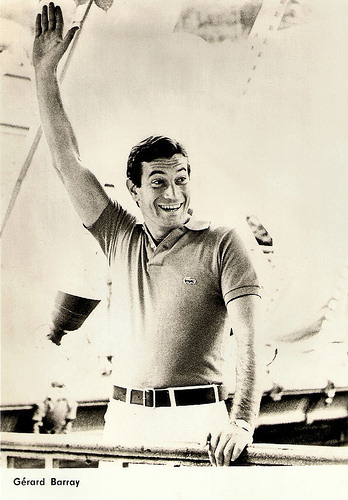
East-German postcard by Progress Film-Verleih, Berlin, no. 3018, 1967. Photo: Schwarz.
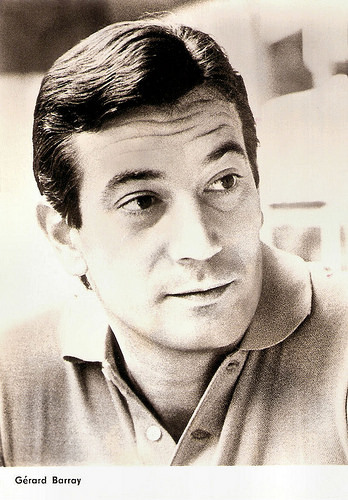
East-German postcard by Progress Film-Verleih, Berlin, no. 3033, 1968. Photo: Schwarz.
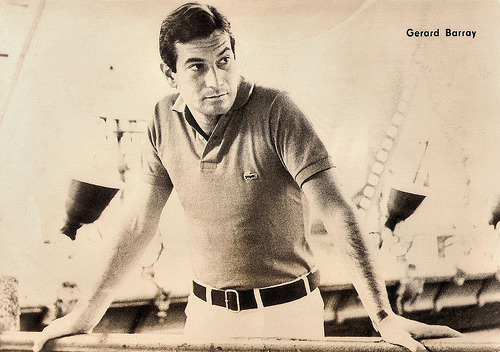
East-German postcard by Progress Film-Verleih, Berlin, no. 21, 1970. Photo: Schwarz.
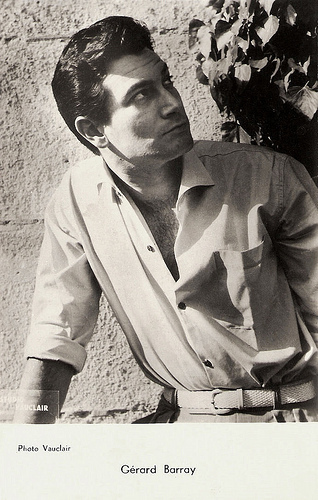
French postcard by Editions P.I., Paris, no. 1138. Photo: Vauclair.
Sources: Hans Beerekamp (Het Schimmenrijk - Dutch), Donatienne (L’encinematheque – French), (IMDb), Wikipedia and .

East-German postcard by Progress Film-Verleih, Berlin, no. 2915, 1967.

Small Romanian collectors card. Photo: publicity still for Les trois mousquetaires/The Three Musketeers (Bernard Borderie, 1961).

Romanian collector card. Gérard Barray in Le chevalier de Pardaillan/The Knight from Pardaillan (Bernard Borderie, 1962).

Romanian collector card. Gérard Barray in Le chevalier de Pardaillan/The Knight from Pardaillan (Bernard Borderie, 1962).

Small Romanian collectors card. Photo: publicity still for Sheherazade (Pierre-Gaspard-Huit, 1963) with Anna Karina .

Small Romanian collectors card. Photo: Antonella Lualdi and Gerard Barray in Surcouf, l'eroe dei sette mari/The Fighting Corsair (Sergio Bergonzelli, Roy Rowland, 1966).
The Three Musketeers
Gérard Barray was born Gérard Marcel Louis Baraillé in Toulouse, France, in 1931. Barray's parents split up quickly and his mother, who came from Montauban decided to return to her hometown with her little boy. Around the age of 15, he discovered a passion for jazz. Barray participated in a few shows in nightclubs while pursuing his studies and obtained a bachelor's degree at the Faculty of Toulouse.
Camille Ricard, an actress and teacher at the Conservatory of Toulouse, advised him to go to Paris. She gave him a letter of recommendation for a friend, actor Noel Roquevert. Barray enrolled at the Cours Simon, a drama school in Paris and four years later, he won the Jury Prize. In 1955, he played his first small film roles as a gigolo in Chantage/Blackmail (Guy Lefranc, 1955) and as a gangster in the Film Noir Série noire/The Infiltrator (Pierre Foucaud, 1955) with Henri Vidal and Erich von Stroheim .
His first major film role was as the Duke of Vallombreuse in the historical adventure film Le Capitaine Fracasse/Captain Fracasse (Pierre Gaspard-Huit, 1961), starring Jean Marais and based on a novel by Théophile Gautier. The film and Barray’s supporting role were a success and next, he played the lead in another prestigious historical adventure, Les trois mousquetaires/The Three Musketeers (Bernard Borderie, 1961), a film adaption of the classic novel by Alexandre Dumas, père .
Reviewer jrjcat at IMDb: “This is a wonderful faithful version of Alexandre Dumas ' The Three Musketeers. Gerard Barray is excellent as D'Artagnan and Mylene Demongeot is not only one of the most beautiful screen Milady de Winters rivalling that of Lana Turner but also excellent in the part as well.” Les trois mousquetaires became the sixth-biggest French box office in 1961. A star was born.
During the 1960s Barray excelled in roles of knights with a big heart such as D'Artagnan, Scaramouche and Surcouf. These films include the Italian-French Alexandre Dumas adaptation I fratelli Corsi/The Corsican Brothers (Anton Giulio Majano, 1961) also starring Geoffrey Horne and Valérie Lagrange , Shéhérazade (Pierre Gaspard-Huit, 1963) starring Anna Karina , La máscara de Scaramouche/The Adventures of Scaramouche (Antonio Isasi-Isasmendi, 1963) and Le chevalier de Pardaillan/Clash of Steel (Bernard Borderie, 1962) plus its sequel Hardi Pardaillan!/The Gallant Musketeer (Bernard Borderie, 1964).

Big East-German card by VEB Progress Film-Vertrieb, Berlin, 1967, no. 16. Gérard Barray, Kirk Morris and Michèle Grellier in Le Chevalier de Pardaillan/The Knight from Pardaillan (Bernard Borderie, 1962).

East-German postcard by Progress Film-Verleih, Berlin, no. 3034 1968. Photo: publicity still for La máscara de Scaramouche/The Adventures of Scaramouche (Antonio Isasi-Isasmendi, 1963) with Yvette Lebon .

East-German postcard by Progress Film-Verleih, Berlin, no. 2961, 1967. Photo: publicity still for Hardi Pardaillan!/The Gallant Musketeer (Bernard Borderie, 1964) with Valérie Lagrange .

Czech collector card by Pressfoto, Praha (Prague), 1964, no. S 58/7.

East-German postcard by Progress Film-Verleih, Berlin, no. 2260, 1965. Photo: Schwarz.

Romanian postcard by Casa Filmului Acin, no. 454. Photo: publicity still for Béru et ces dames/Beru and These Women (Guy Lefranc, 1968).
Next Time I'll Kill You
During the 1960s, Gérard Barray starred in a dozen feature films, most of which were box-office successes and widely known abroad. Besides Swashbucklers, he became one of the Eurospy stars with his roles in thrillers like Gibraltar (Pierre Gaspard-Huit, 1964) with Hildegard Knef and Baraka sur X 13/Agent X-77 Orders to Kill (Maurice Cloche, 1966) opposite Sylva Koscina .
He also starred as police commissioner San Antonio in the thrillers Sale temps pour les mouches/Next Time I'll Kill You (Guy Lefranc, 1966) and Béru et ces dames/Beru and These Women (Guy Lefranc, 1966), both with Jean Richard. He continued to play in popular Swashbucklers such as the French-Italian-Spanish adventure film Surcouf, le tigre des sept mers/The Sea Pirate (Sergio Bergonzelli, Roy Rowland, 1966) with Antonella Lualdi .
In 1969, he played a mysterious museum curator who seduces a young English teacher ( Claude Jade ) in Le Témoin/The Witness (Anne Walter, 1969). It was his last major role. Daniel Denner at IMDb: “he changed his profile to the dark side as Van Britten - his most interesting part but without great success.” Barray appeared in the supporting role of Richard, a rather temperamental star actor in Le cinéma de papa (Claude Berri, 1970), but mostly he worked for TV.
Decades later he made a comeback in the cinema opposite Eduardo Noriega and Penélope Cruz in Abre los ojos/Open Your Eyes (Alejandro Amenabar. 1997), the original version of Vanilla Sky (Cameron Crowe, 2001) with Tom Cruise . Barray appeared in more Spanish films and TV series and also played a small part in the thriller Sexy Beast (Jonathan Glazer, 2000).
In 2010, Gérard Barray was appointed an Officer in the Order of Arts and Letters. Barray died in 2024 in Marbella in the south of Spain at 92. Since 1965, he was married to his former co-star, flamenco dancer Theresa Lorca and they had two children and three grandchildren.

East-German postcard by Progress Film-Verleih, Berlin, no. 2216, 1965. Photo: Schwarz.

East-German postcard by Progress Film-Verleih, Berlin, no. 2828, 1967. Photo: publicity still for Surcouf, l'eroe dei sette mari/The Sea Pirate (Sergio Bergonzelli, Roy Rowland, 1966) with Geneviève Casile.

East-German postcard by Progress Film-Verleih, Berlin, no. 3018, 1967. Photo: Schwarz.

East-German postcard by Progress Film-Verleih, Berlin, no. 3033, 1968. Photo: Schwarz.

East-German postcard by Progress Film-Verleih, Berlin, no. 21, 1970. Photo: Schwarz.

French postcard by Editions P.I., Paris, no. 1138. Photo: Vauclair.
Sources: Hans Beerekamp (Het Schimmenrijk - Dutch), Donatienne (L’encinematheque – French), (IMDb), Wikipedia and .
Published on February 18, 2024 22:00
February 17, 2024
Johanna von Koczian (1933-2024)
On 13 February, German actress, singer and author Johanna von Koczian (1933-2024) passed away in Berlin. During the late 1950s and early 1960s, she was one of Germany’s most popular film stars. Later, she evolved into a stage actress, a popular Schlager singer, a TV presenter, and a successful author of novels and children's books. Johanna von Koczian was 90.
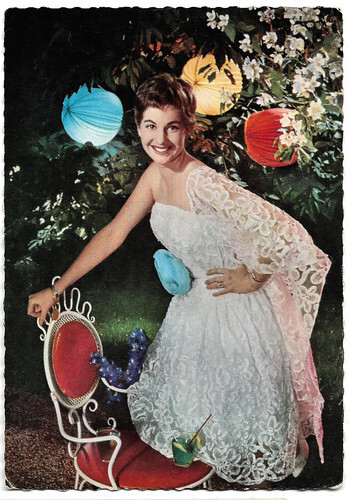
West-German postcard by AFA, Berlin-Tempelhof, no. CK-323. Photo: Ringpress / Vogelmann.
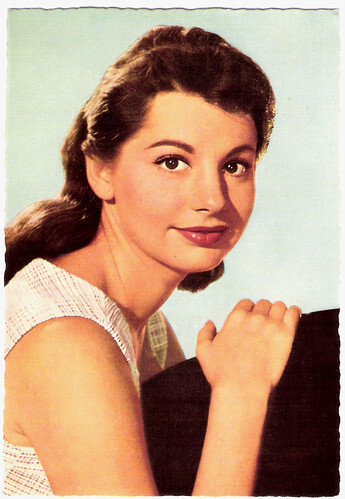
German postcard by WS-Druck, Wanne-Eickel, no. F 125. Photo: Constantin.
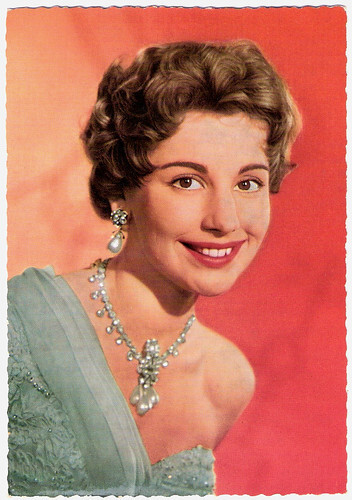
German postcard by Ufa, Berlin-Tempelhof, no. CK-60. Photo: Arthur Grimm / Central Europa Film.
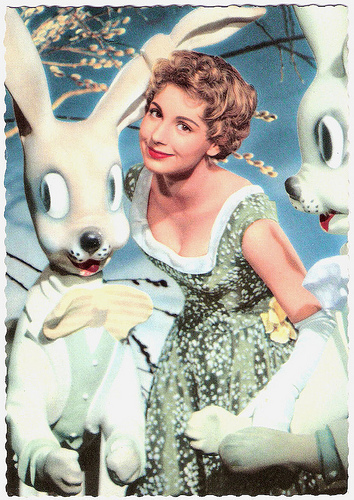
German postcard by Ufa, Berlin-Tempelhof, no. CK-64. Photo: Arthur Grimm / Central Europa Film.
Crossdressing comedy
Johanna von Koczian was born in Berlin as Johanna von Miskoczy in Berlin in 1933. She was the daughter of Gustav von Koczian-Miskolcy, a German soldier, and his wife Lydia Alexandra.
Johanna grew up in Austria, where she studied at the University of Music and Dramatic Arts Mozarteum in Salzburg.
Here, she was discovered by director Gustaf Gründgens, who gave her a role at the Salzburg Theater Festival. Her breakthrough in the theatre was her role as Anne Frank at the Schiller Theatre in Berlin.
Her first film role was the lead in the remake of the famous cross-dressing comedy Viktor und Viktoria/Viktor and Viktoria (Karl Anton, 1957) with Georg Thomalla and Johannes Heesters .
The next year she played the female lead in the box office hit Wir Wunderkinder/Aren't We Wonderful? (Kurt Hoffmann, 1958) with Hansjörg Felmy . For her role, she was awarded the Bundesfilmpreis (Federal Film Prize).
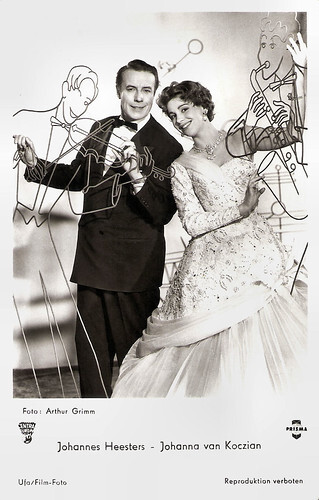
German postcard by Ufa, Berlin-Tempelhof, no. CK-60. Photo: Arthur Grimm / Central Europa Film / Prisma. Johannes Heesters and Johanna von Koczian in Viktor und Viktoria/Viktor and Viktoria (Karl Anton, 1957).
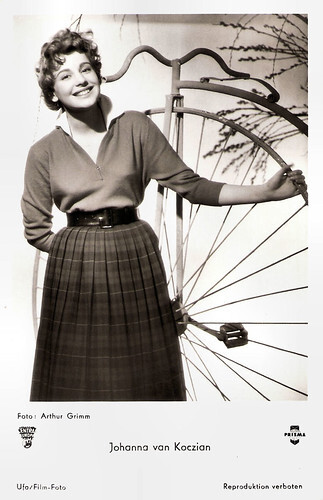
West-German postcard by Ufa/Film-Foto, no. FK 3552. Photo: Arthur Grimm / Central Europa / Prisma Film. Johanna von Koczian in Viktor und Viktoria/Viktor and Viktoria (Karl Anton, 1957).
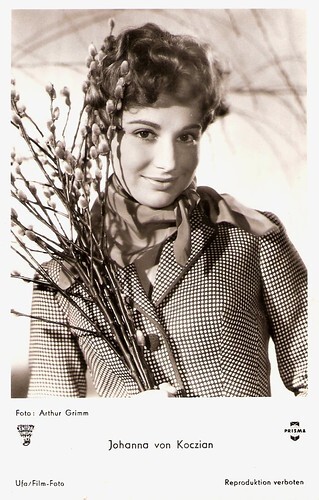
German postcard by Ufa/Film-Foto (Universum-Film Aktiengesellschaft), Berlin, no. FK 3553. Retail price: 25 Pfg. Photo: Arthur Grimm / Prisma Film. Publicity still for Viktor und Viktoria/Viktor and Viktoria (Karl Anton, 1957).
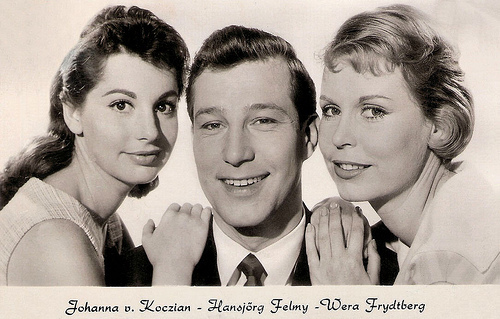
Dutch postcard by Gebr. Spanjersberg N.V., Rotterdam, no. 5338. Sent by mail in the Netherlands in 1960. Photo: HAFBO-film. Johanna von Koczian, Hansjörg Felmy and Wera Frydtberg in Wir Wunderkinder/Aren't We Wonderful? (Kurt Hoffmann, 1958).
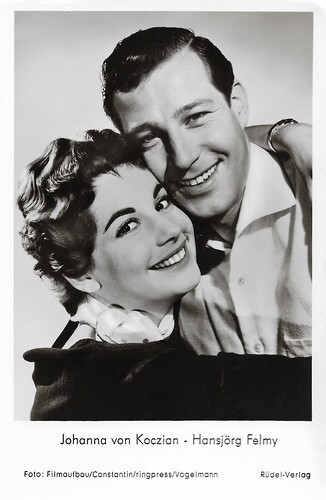
West German postcard by Frans Josef Rüdel, Filmpostkarenverlag, Hamburg-Bergedorf, no. 2466. Photo: Filmaufbau / Constantin / Ringpress / Vogelman.Johanna von Koczian and Hansjörg Felmy in Wir Wunderkinder/Aren't We Wonderful? (Kurt Hoffmann, 1958).
One of the most popular German film stars
In the later 1950s, Johanna von Koczian was one of the most popular German film stars and played in films like Petersburger Nächte/Petersburg Nights (Paul Martin, 1958) with Ewald Balser, Ivan Desny and Claus Biederstaedt , Bezaubernde Arabella/Enchanting Arabella (Axel von Ambesser, 1959) based on a novel by Georgette Heyer, Menschen im Netz/People in the Net (Franz Peter Wirth, 1959) again with Hansjörg Felmy and the musical Jacqueline (Wolfgang Liebeneiner, 1959).
She played Anastasia in the Friedrich Dürrenmatt adaptation Die Ehe des Herrn Mississippi/The Marriage of Mr. Mississippi (Kurt Hoffmann, 1961) with O.E. Hasse . That year, she also appeared in Unser Haus in Kamerun/Our House in Cameroun (Alfred Vohrer, 1961) with Götz George and the drama Straße der Verheißung/Street of Temptation (Imo Moszkowicz, 1961) with Mario Adorf and Karin Baal .
From 1962 on, Von Koczian was mainly working on stage for several different companies. She often starred in Boulevard comedies.
She also appeared in popular TV series like Praxis Bülowbogen/Practice Bülowbogen (1987-1988) and as Dr. Cora in the satire show Fragen Sie Frau Dr. Cora/Ask Doctor Cora (1989).
She only made two more feature films, the episodic film Das Liebeskarussell/The Daisy Chain (Rolf Thiele, Axel von Ambesser, Alfred Weidenmann, 1965) and Käpt'n Rauhbein aus St. Pauli/Nurses for Sale (Rolf Olsen, 1971) with Curd Jürgens .
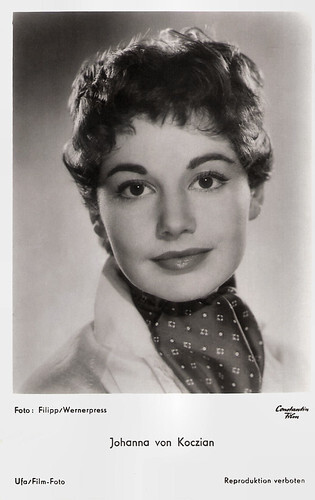
Austrian postcard by Verlag Hubmann, Wien, licence holder of Ufa for Austria. Photo: Filipp / Wernerpress / Constantin Film / Ufa/Film-Foto.
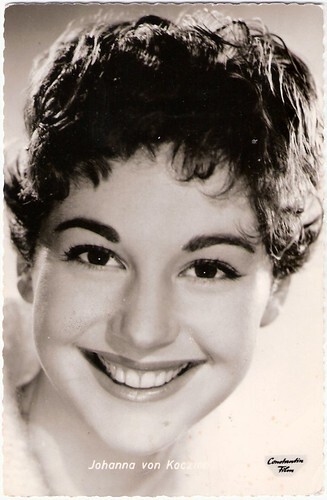
German postcard by Kolibri-Verlag G.m.b.H., Minden / Westfalen, ca. 1959-1960. Photo: Corona / Constantin / Filipp. Publicity postcard for Serenade einer Grossen Liebe/For the First Time (Rudolph Maté, 1959). This musical was an American/German/Italian coproduction starring opera singer Mario Lanza .
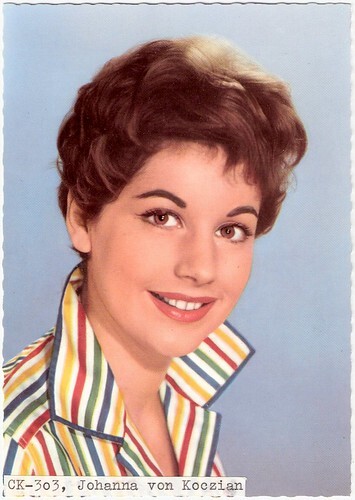
German postcard by Universum-Film Aktiengesellschaft, Berlin Tempelhof (UFA), no. CK 303. Photo: Klaus Collignon / UFA.
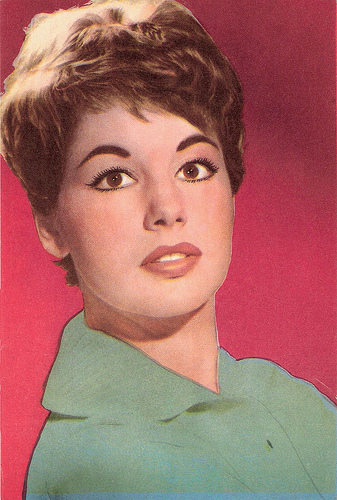
Belgian postcard by Cox, no. 23.
Successful children books
During her career, Johanna von Koczian appeared on the stages of the Schauspielhaus in Wuppertal, the Staatlichen Schauspielbühnen (State Theatre) in Berlin, the Bayerische Staatsschauspiel (Bavarian State Theatre) in Munich, the Theater in der Josefstadt in Vienna and the Hamburg Thalia Theatre under the direction of Boy Gobert.
In 1977 she had a major hit single in Germany and Austria with her song 'Das bißchen Haushalt' (The Little Bit of Homemaking), mocking a macho husband's attitude towards a homemaker's duties. Other popular Schlagers of her include 'Keinen Pfennig' (No Penny)(1974), 'Aufsteh'n ist schön' (Getting Up Is Beautiful) (1978) and 'Karl, gib' mal den Hammer rüber' (Karl, Hand Me the Hammer)(1979), which she often performed on TV.
For German public television, she also presented the music quiz Erkennen Sie die Melodie?/Do You Recognize This Melody? She appeared in popular Krimis like Derrick (1975-1978), Der Alte/The Old Fox (1983), Tatort/Crime Scene (1986-1987) and SOKO 5113 (2002). She played in the popular TV film Single Bells (Xaver Schwarzenberger, 1998) and its sequel O Palmenbaum/O Palm Tree (Xaver Schwarzenberger, 2000).
More recently she appeared in the popular series Die Landärztin/The Country Doctor (2005-2009). Since the 1980s she wrote successful children's books and such novels as 'Sommerschatten' (Summer Shadows, 1989) and 'Das Narrenspiel' (The Fool's Game, 1992).
She was married twice, first shortly to director Dietrich Haugk who directed her in the films Heldinnen/Heroes (1960) and Agatha, laß das Morden sein!/Agatha, stop killing! (1960), and after their divorce she was married to music producer Wolf Kabitzky till his death in 2004. She moved to a nursing home in the Grunewald district in 2017, withdrawing from public life. Johanna von Koczian died in 2024, at the age of 90. She was the mother of actress Alexandra von Koczian.
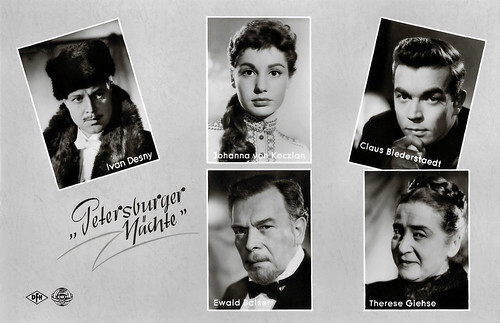
West-German postcard by Franz Josef Rüdel, Filmpostkartenverlag, Hamburg-Bergedorf, no. M 2485. Photo: CCC / Deutsche Film Hansa (FDH) / Arthur Grimm. Ivan Desny , Johanna von Koczian, Claus Biederstaedt , Therese Giehse and Ewald Balser in Petersburger Nächte/Petersburg Nights (Paul Martin, 1958).
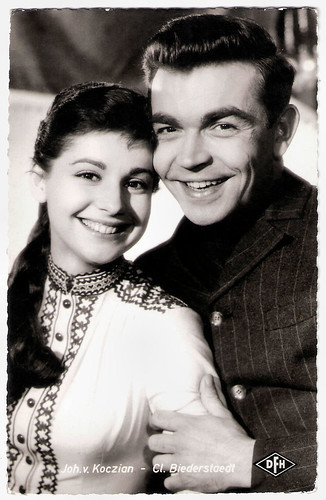
German postcard by Kolibri-Verlag G.m.b.H., Minden/Westf., no. 308. Photo: Arthur Grimm / CCC / DFH. Johanna von Koczian and Claus Biederstaedt in Petersburger Nächte/Petersburg Nights (Paul Martin, 1958).
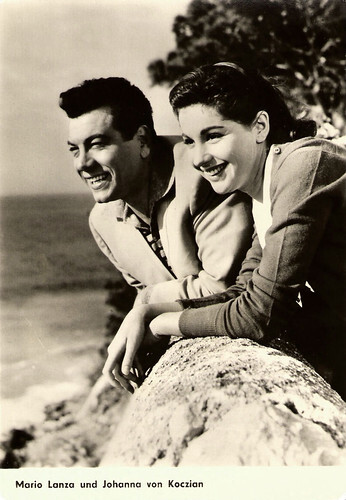
East-German postcard by VEB Progress Film-Vertrieb, Berlin, no. 2106, 1964. Photo: Mario Lanza and Johanna von Koczian in For the First Time (Rudolph Maté, 1959).
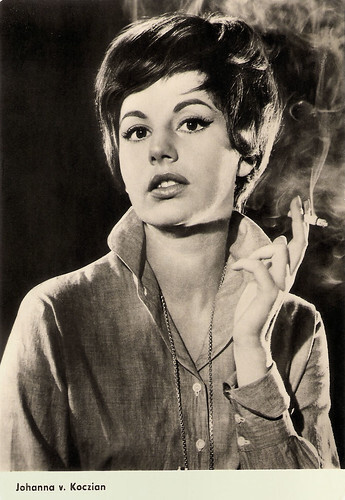
East German postcard by VEB Progress Film-Vetrieb, Berlin, no. 1583, 1961. Johanna von Koczian in Agatha, lass das Morden sein!/Agatha, stop killing! (Dieter Haugk, 1960).
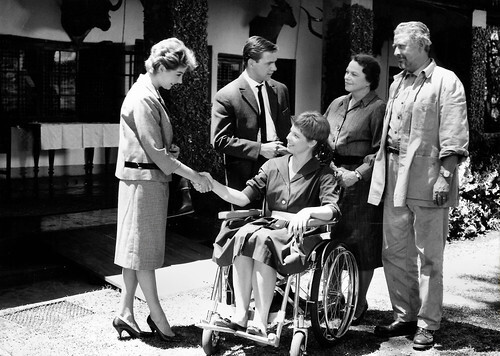
Belgian press photo by Elan Film, Brussels. Johanna von Koczian, Götz George , Katrin Schaake, Hans Söhnker and Bertha Drews in Unser Haus in Kamerun/Our House in Cameroun (Alfred Vohrer, 1961).
Trailer Wir Wunderkinder/Aren't We Wonderful? (1958). Source: Trailer Tracker Classic (YouTube).
Sources: Stephanie D'heil (Steffi-Line - German), Wikipedia (German and English) and .

West-German postcard by AFA, Berlin-Tempelhof, no. CK-323. Photo: Ringpress / Vogelmann.

German postcard by WS-Druck, Wanne-Eickel, no. F 125. Photo: Constantin.

German postcard by Ufa, Berlin-Tempelhof, no. CK-60. Photo: Arthur Grimm / Central Europa Film.

German postcard by Ufa, Berlin-Tempelhof, no. CK-64. Photo: Arthur Grimm / Central Europa Film.
Crossdressing comedy
Johanna von Koczian was born in Berlin as Johanna von Miskoczy in Berlin in 1933. She was the daughter of Gustav von Koczian-Miskolcy, a German soldier, and his wife Lydia Alexandra.
Johanna grew up in Austria, where she studied at the University of Music and Dramatic Arts Mozarteum in Salzburg.
Here, she was discovered by director Gustaf Gründgens, who gave her a role at the Salzburg Theater Festival. Her breakthrough in the theatre was her role as Anne Frank at the Schiller Theatre in Berlin.
Her first film role was the lead in the remake of the famous cross-dressing comedy Viktor und Viktoria/Viktor and Viktoria (Karl Anton, 1957) with Georg Thomalla and Johannes Heesters .
The next year she played the female lead in the box office hit Wir Wunderkinder/Aren't We Wonderful? (Kurt Hoffmann, 1958) with Hansjörg Felmy . For her role, she was awarded the Bundesfilmpreis (Federal Film Prize).

German postcard by Ufa, Berlin-Tempelhof, no. CK-60. Photo: Arthur Grimm / Central Europa Film / Prisma. Johannes Heesters and Johanna von Koczian in Viktor und Viktoria/Viktor and Viktoria (Karl Anton, 1957).

West-German postcard by Ufa/Film-Foto, no. FK 3552. Photo: Arthur Grimm / Central Europa / Prisma Film. Johanna von Koczian in Viktor und Viktoria/Viktor and Viktoria (Karl Anton, 1957).

German postcard by Ufa/Film-Foto (Universum-Film Aktiengesellschaft), Berlin, no. FK 3553. Retail price: 25 Pfg. Photo: Arthur Grimm / Prisma Film. Publicity still for Viktor und Viktoria/Viktor and Viktoria (Karl Anton, 1957).

Dutch postcard by Gebr. Spanjersberg N.V., Rotterdam, no. 5338. Sent by mail in the Netherlands in 1960. Photo: HAFBO-film. Johanna von Koczian, Hansjörg Felmy and Wera Frydtberg in Wir Wunderkinder/Aren't We Wonderful? (Kurt Hoffmann, 1958).

West German postcard by Frans Josef Rüdel, Filmpostkarenverlag, Hamburg-Bergedorf, no. 2466. Photo: Filmaufbau / Constantin / Ringpress / Vogelman.Johanna von Koczian and Hansjörg Felmy in Wir Wunderkinder/Aren't We Wonderful? (Kurt Hoffmann, 1958).
One of the most popular German film stars
In the later 1950s, Johanna von Koczian was one of the most popular German film stars and played in films like Petersburger Nächte/Petersburg Nights (Paul Martin, 1958) with Ewald Balser, Ivan Desny and Claus Biederstaedt , Bezaubernde Arabella/Enchanting Arabella (Axel von Ambesser, 1959) based on a novel by Georgette Heyer, Menschen im Netz/People in the Net (Franz Peter Wirth, 1959) again with Hansjörg Felmy and the musical Jacqueline (Wolfgang Liebeneiner, 1959).
She played Anastasia in the Friedrich Dürrenmatt adaptation Die Ehe des Herrn Mississippi/The Marriage of Mr. Mississippi (Kurt Hoffmann, 1961) with O.E. Hasse . That year, she also appeared in Unser Haus in Kamerun/Our House in Cameroun (Alfred Vohrer, 1961) with Götz George and the drama Straße der Verheißung/Street of Temptation (Imo Moszkowicz, 1961) with Mario Adorf and Karin Baal .
From 1962 on, Von Koczian was mainly working on stage for several different companies. She often starred in Boulevard comedies.
She also appeared in popular TV series like Praxis Bülowbogen/Practice Bülowbogen (1987-1988) and as Dr. Cora in the satire show Fragen Sie Frau Dr. Cora/Ask Doctor Cora (1989).
She only made two more feature films, the episodic film Das Liebeskarussell/The Daisy Chain (Rolf Thiele, Axel von Ambesser, Alfred Weidenmann, 1965) and Käpt'n Rauhbein aus St. Pauli/Nurses for Sale (Rolf Olsen, 1971) with Curd Jürgens .

Austrian postcard by Verlag Hubmann, Wien, licence holder of Ufa for Austria. Photo: Filipp / Wernerpress / Constantin Film / Ufa/Film-Foto.

German postcard by Kolibri-Verlag G.m.b.H., Minden / Westfalen, ca. 1959-1960. Photo: Corona / Constantin / Filipp. Publicity postcard for Serenade einer Grossen Liebe/For the First Time (Rudolph Maté, 1959). This musical was an American/German/Italian coproduction starring opera singer Mario Lanza .

German postcard by Universum-Film Aktiengesellschaft, Berlin Tempelhof (UFA), no. CK 303. Photo: Klaus Collignon / UFA.

Belgian postcard by Cox, no. 23.
Successful children books
During her career, Johanna von Koczian appeared on the stages of the Schauspielhaus in Wuppertal, the Staatlichen Schauspielbühnen (State Theatre) in Berlin, the Bayerische Staatsschauspiel (Bavarian State Theatre) in Munich, the Theater in der Josefstadt in Vienna and the Hamburg Thalia Theatre under the direction of Boy Gobert.
In 1977 she had a major hit single in Germany and Austria with her song 'Das bißchen Haushalt' (The Little Bit of Homemaking), mocking a macho husband's attitude towards a homemaker's duties. Other popular Schlagers of her include 'Keinen Pfennig' (No Penny)(1974), 'Aufsteh'n ist schön' (Getting Up Is Beautiful) (1978) and 'Karl, gib' mal den Hammer rüber' (Karl, Hand Me the Hammer)(1979), which she often performed on TV.
For German public television, she also presented the music quiz Erkennen Sie die Melodie?/Do You Recognize This Melody? She appeared in popular Krimis like Derrick (1975-1978), Der Alte/The Old Fox (1983), Tatort/Crime Scene (1986-1987) and SOKO 5113 (2002). She played in the popular TV film Single Bells (Xaver Schwarzenberger, 1998) and its sequel O Palmenbaum/O Palm Tree (Xaver Schwarzenberger, 2000).
More recently she appeared in the popular series Die Landärztin/The Country Doctor (2005-2009). Since the 1980s she wrote successful children's books and such novels as 'Sommerschatten' (Summer Shadows, 1989) and 'Das Narrenspiel' (The Fool's Game, 1992).
She was married twice, first shortly to director Dietrich Haugk who directed her in the films Heldinnen/Heroes (1960) and Agatha, laß das Morden sein!/Agatha, stop killing! (1960), and after their divorce she was married to music producer Wolf Kabitzky till his death in 2004. She moved to a nursing home in the Grunewald district in 2017, withdrawing from public life. Johanna von Koczian died in 2024, at the age of 90. She was the mother of actress Alexandra von Koczian.

West-German postcard by Franz Josef Rüdel, Filmpostkartenverlag, Hamburg-Bergedorf, no. M 2485. Photo: CCC / Deutsche Film Hansa (FDH) / Arthur Grimm. Ivan Desny , Johanna von Koczian, Claus Biederstaedt , Therese Giehse and Ewald Balser in Petersburger Nächte/Petersburg Nights (Paul Martin, 1958).

German postcard by Kolibri-Verlag G.m.b.H., Minden/Westf., no. 308. Photo: Arthur Grimm / CCC / DFH. Johanna von Koczian and Claus Biederstaedt in Petersburger Nächte/Petersburg Nights (Paul Martin, 1958).

East-German postcard by VEB Progress Film-Vertrieb, Berlin, no. 2106, 1964. Photo: Mario Lanza and Johanna von Koczian in For the First Time (Rudolph Maté, 1959).

East German postcard by VEB Progress Film-Vetrieb, Berlin, no. 1583, 1961. Johanna von Koczian in Agatha, lass das Morden sein!/Agatha, stop killing! (Dieter Haugk, 1960).

Belgian press photo by Elan Film, Brussels. Johanna von Koczian, Götz George , Katrin Schaake, Hans Söhnker and Bertha Drews in Unser Haus in Kamerun/Our House in Cameroun (Alfred Vohrer, 1961).
Trailer Wir Wunderkinder/Aren't We Wonderful? (1958). Source: Trailer Tracker Classic (YouTube).
Sources: Stephanie D'heil (Steffi-Line - German), Wikipedia (German and English) and .
Published on February 17, 2024 22:00
Paul van Yperen's Blog
- Paul van Yperen's profile
- 13 followers
Paul van Yperen isn't a Goodreads Author
(yet),
but they
do have a blog,
so here are some recent posts imported from
their feed.



